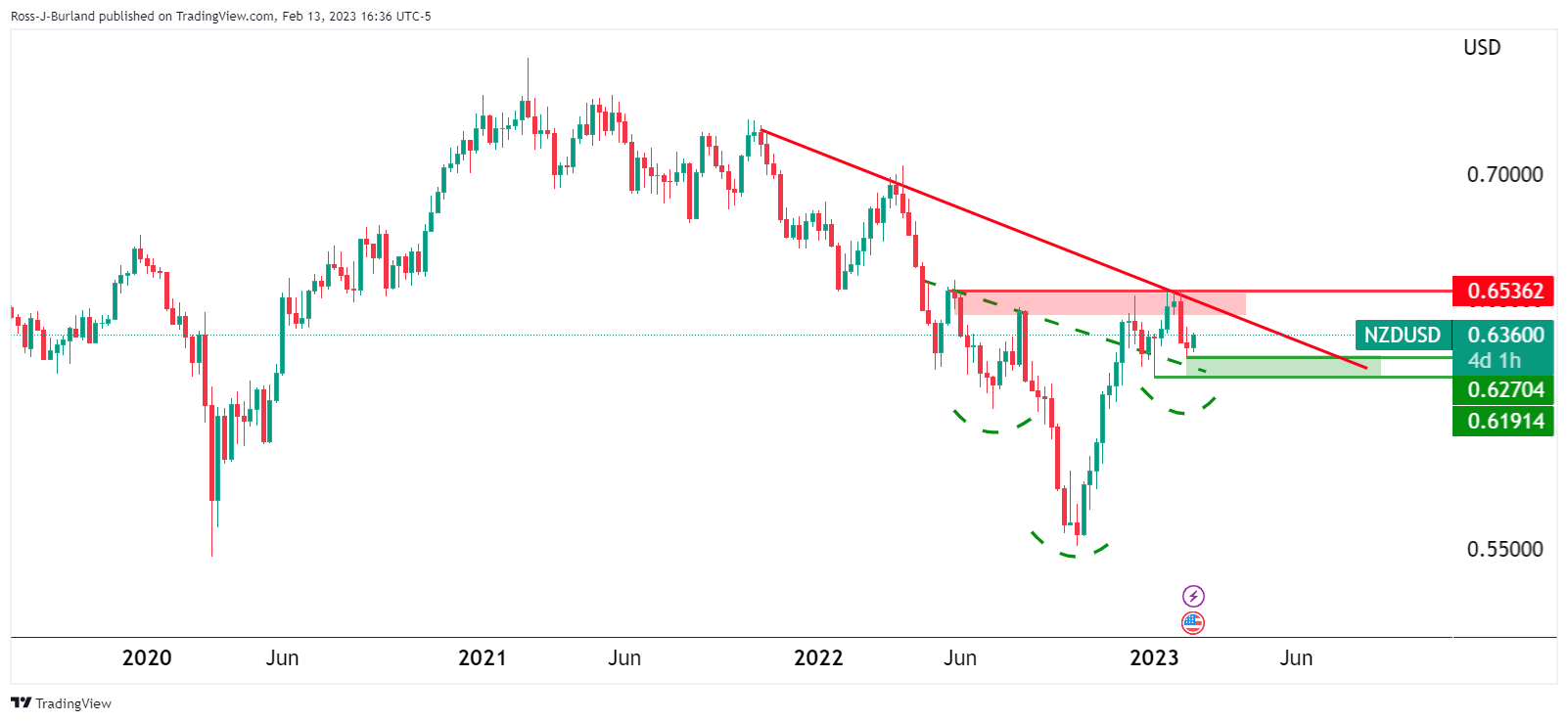- Analytics
- News and Tools
- Market News
CFD Markets News and Forecasts — 13-02-2023
Japan's Gross Domestic Product released by the Cabinet Office has been released as follows:
Japan's economy grew an annualised 0.6% in the final three months of 2022, government data showed on Tuesday, bouncing back from the previous quarter's contraction as the return of inbound tourists offset a slowdown in capital expenditure and exports, Reuters explained.
''The fourth-quarter growth of Japan's economy, the world's third-largest, compared with the median estimate of a 2.0% gain in a Reuters poll of 18 economists.''
Key notes
Japan's Oct-Dec annualised GDP+0.6% (poll: +2.0%).
Japan real GDP +0.2% QoQ (Reuters poll: +0.5%).
Japan Oct-Dec private consumption +0.5% QoQ (poll: +0.5%).
Japan Oct-Dec Capex -0.5% qtr/qtr (poll: -0.2%)
Japan Oct-Dec external demand contribution to GDP +0.3 pct point (poll: +0.4 pct pt).
Japan exports +1.4% qtr/qtr
Japan domestic demand contribution to GDP -0.2 pct point
Japan GDP deflator +1.1% YoY.
USD/JPY update
More to come...
About the Gross Domestic Product
The Gross Domestic Product released by the Cabinet Office shows the monetary value of all the goods, services and structures produced in Japan within a given period of time. GDP is a gross measure of market activity because it indicates the pace at which the Japanese economy is growing or decreasing. A high reading or a better-than-expected number is seen as positive for the JPY, while a low reading is negative.
- USD/CHF has shifted its auction below 0.9200 despite the cheerful market mood.
- The market sentiment could get dismal if the US inflation figure shows a U-turn after declining for three months.
- An increase in the Swiss CPI has bolstered the case of more interest rate hikes by the Swiss National Bank ahead.
The USD/CHF pair has shifted its business below the round-level resistance of 0.9200 in the early Asian session. The Swiss Franc asset is expected to deliver more losses as investors have ignored the consequences associated with the United States inflation, in case it delivers a surprise upside. The risk appetite of the market participants has improved dramatically and has provided support to the risk-sensitive assets.
S&P500 futures are looking to extend their upside as investors have also ignored the geopolitical fears linked to the airborne threats to the United States. The US Dollar Index (DXY) is struggling to reclaim the critical resistance of 103.00 amid the risk-on mood. Meanwhile, a recovery in the demand for US government bonds has dragged the 10-year US Treasury yields to near 3.70%.
Investors seem casual ahead of the release of the US Inflation, however, the market sentiment could get dismal if the inflation figure show a U-turn after declining significantly for the past three months.
Analysts at TD Securities have forecasted a firm 0.4% MoM gain in the core CPI series. In terms of the headline, we expect CPI inflation to register its firmest MoM gain since October, posting a strong 0.4% increase. Our MoM projections imply that inflation likely lost speed again on a YoY basis in January as we look for inflation to drop to 6.2% for the headline (after 6.5% YoY in December), and to ease to 5.5% YoY for the core series (after 5.7% in January).”
On the Swiss Franc front, an increase in the Consumer Price Index (CPI) has bolstered the case of more interest rate hikes by the Swiss National Bank (SNB) ahead. On Monday, the Swiss Federal Statistical Office reported a rise in the monthly CPI figure by 0.6% vs. the consensus of 0.4%. And, the annual inflation rate rose to 3.3% from the estimates of 2.9% and the former release of 2.8%.
SNB Chairman Thomas J. Jordan has already cleared that the inflationary pressures are beyond the control of the central bank. Therefore, the case calls for more interest rate hikes by the SNB ahead.
- US Dollar Index remains pressured after reversing from one-week high.
- Pullback in yields, market’s preparations for the key US CPI for January weigh on DXY.
- Hawkish Fed talks fail to put a floor under the price.
- Softer US inflation can renew Fed policy pivot talks and weigh on the US Dollar.
US Dollar Index (DXY) holds lower ground near 103.30 during early Tuesday morning in Asia, following a U-turn from the one-week high amid cautious optimism. In addition to the market’s mildly positive sentiment, the greenback’s gauge also declines as the DXY traders brace for the Consumer Price Index (CPI) for January amid mixed clues.
That said, the risk profile was mostly upbeat on Monday, after a downbeat start, as fears surrounding the unidentified flying objects near the United States and China, one of which was recently confirmed as like a metal ball, eased afterward on comments from the US General. That said, the US military authority turned down the fears while rejecting calls to believe that those flying objects were from China. Adding strength to the risk-on mood were upbeat US equities and a pullback in the US Treasury bond yields after multiple days of run-up.
It should be noted that sluggish US inflation expectations seemed to have weighed on the DXY as the 10-year and 5-year breakeven inflation rates from the St. Louis Federal Reserve (FRED) grind near monthly high, close 2.31% and 2.44% at the latest.
Even so, hawkish comments from the Fed policymakers and a lack of major positive headlines weigh on the Gold price. On Monday, Fed Governor Michelle Bowman said that the Federal Reserve will need to continue to raise interest rates in order to get them to a level high enough to bring inflation back down to the central bank's target rate, per Reuters. Before him, Philadelphia Federal Reserve President Patrick Harker pushed back the chatters of a Fed rate cut during 2023. However, the policymaker did mention, “Fed not likely to cut this year but may be able to in 2024 if inflation starts ebbing.” His comments were mostly in line with Fed Chair Jerome Powell’s cautious optimism and exerted downside pressure on the US Dollar.
Against this backdrop, Wall Street closed on the positive side while the US Treasury bond yields retreat after multiple days of run-up.
Moving ahead, the US CPI data for January appears the key as the recent Federal Reserve (Fed) comments appear light when suggesting more rate hikes. Also, the Fed policy pivot talks aren’t far from the table and hence any disappointment from the US inflation numbers won’t hesitate to drown the DXY.
Also read: US Consumer Price Index Preview: US Dollar vulnerable to violent crash, every 0.1% in Core CPI matters
Technical analysis
50-day Exponential Moving Average (EMA) guards the immediate US Dollar Index upside near 103.75.
- Gold price remains pressured around the lowest levels in five weeks.
- Markets preparations for United States Consumer Price Index for January weigh on XAU/USD price amid hawkish Federal Reserve talks.
- Risk-on mood, softer US Dollar failed to provide tailwind to the Gold price.
- Gold buyers need downbeat US CPI but inflation expectations are again on the move.
Gold price (XAU/USD) holds lower ground at the monthly bottom surrounding $1,855, following the slump to early January levels the previous day, as markets brace for the United States Consumer Price Index (CPI) for January. Also pausing the XAU/USD’s declines is the US Dollar pullback, as well as the firmer sentiment. However, hawkish comments from the Federal Reserve (Fed) officials and firmer US inflation expectations seem to keep the Gold bears hopeful ahead of the key data.
Hawkish Federal Reserve talks favor Gold bears
Federal Reserve (Fed) officials defend the rate hikes and are far from suggesting the policy pivot, which in turn keeps the market’s fears of tighter monetary policy actions moving forward and the same weighs on the Gold price. Fed Governor Michelle Bowman said on Monday that the Federal Reserve will need to continue to raise interest rates in order to get them to a level high enough to bring inflation back down to the central bank's target rate, per Reuters. Before him, Philadelphia Federal Reserve President Patrick Harker pushed back the chatters of a Fed rate cut during 2023. However, the policymaker did mention, “Fed not likely to cut this year but may be able to in 2024 if inflation starts ebbing.” His comments were mostly in line with Fed Chair Jerome Powell’s cautious optimism and exerted downside pressure on the US Dollar.
United States Inflation Expectations also weigh on XAU/USD
Although the market forecasts hint at the easing of the United States Consumer Price Index (CPI) for January to 6.2% YoY from 6.5%, the US inflation expectations remain firmer around the monthly highs and underpin the hawkish Fed bias. That said, the US inflation expectations per the 10-year and 5-year breakeven inflation rates from the St. Louis Federal Reserve (FRED) remain firmer around the monthly highs, close 2.31% and 2.44% at the latest. It’s worth noting that the University of Michigan also lifted its one-year ahead inflation projections while keeping the five-year forecasts intact.
Easy sentiment, softer US Dollar fail to recall Gold buyers
The risk profile was mostly upbeat on Monday, after a downbeat start, as fears surrounding the unidentified flying objects near the United States and China, one of which was recently confirmed as like a metal ball, eased afterward on comments from the US General. That said, the US military authority turned down the fears while rejecting calls to believe that those flying objects were from China. Adding strength to the risk-on mood were upbeat US equities and a pullback in the US Treasury bond yields after multiple days of run-up.
It should be noted that the US Dollar Index (DXY) retreated from a one-week high on Monday, sidelined near 103.30 by the press time, as traders prepare for the key US data.
While the softer sentiment and the US Dollar’s pullback should put a floor under the Gold price, the metal failed to cheer any of it and remained depressed near the five-week low.
US CPI is the key
Gold traders should emphasize the US CPI data for January as the recent Federal Reserve (Fed) comments appear light when suggesting more rate hikes. Also, the Fed policy pivot talks aren’t far from the table and hence any disappointment from the US inflation numbers won’t hesitate to propel the Gold price.
Also read: Gold Price Forecast: $1,800 barrier not that far away
Gold price technical analysis
Following a downside break of the 200-Simple Moving Average (SMA), the Gold price forms a bearish triangle pattern while portraying consolidation of downside moves ahead of the key United States inflation.
That said, the 50-SMA pierces off the 200-SMA from above and prints a bearish moving average crossover called the “Death cross”, suggesting further weakness of the Gold price.
Also portraying the XAU/USD inaction are the recently sluggish Moving Average Convergence and Divergence (MACD) signals and the downbeat Relative Strength Index (RSI), placed at 14.
Even so, the lower line of the stated triangle, around $1,845 by the press time, restricts short-term XAU/USD downside before directing Gold bears towards a horizontal area comprising multiple levels marked since the last December, close to $1,825.
Alternatively, an upside clearance of the aforementioned triangle’s top line, close to $1,855 at the latest, could trigger a corrective bounce toward the 50-SMA hurdle surrounding $1,880. However, Gold buyers remain off the table unless witnessing successful trading beyond the 200-SMA resistance, close to $1,890 at the latest.
Overall, the Gold price flashes bearish signals as the key data/events loom.
Gold price: Four-hour chart
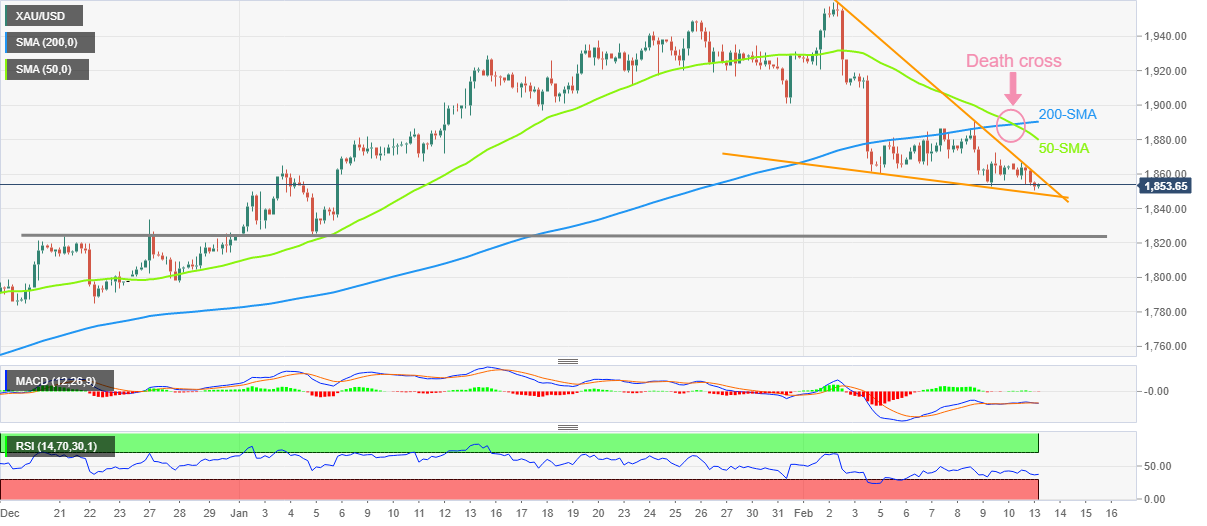
Trend: Further downside expected
- AUD/JPY is expected to extend its correction to near 92.00 as investors see the abolishment of the YCC by the BoJ.
- An abolishment of YCC will provide more returns on yen-denominated assets.
- The RBA has already hiked its interest rates to 3.35% and more hikes are in pipeline to contain the stubborn inflation.
The AUD/JPY pair has turned sideways after a marginal correction to near 92.20 in the early Tokyo session. The risk barometer is expected to deliver more losses as the novel Bank of Japan (BoJ) leadership might abolish the Yield Curve Control (YCC), as reported by Bloomberg, to allow bonds more freedom and more allowance to the central bank to purchase bonds.
Bloomberg reported, “With the nomination for the top BOJ job set to be announced Tuesday, bond traders are wagering on a further tweak to yield curve control sooner rather than later and pricing at an end to negative rates around the middle of the year.”
Earlier, BoJ Governor Haruhiko Kuroda announced a tweak in the YCC of 10-year Japanese Government Bonds (JGBs) yield to rise to 0.5% from the current 0.25%. The move was considered a step towards an exit from the decade-long ultra-expansionary monetary policy by the BoJ.
And, now the abolishment of the YCC by academician Kazuo Ueda after appointing him as a successor of BoJ Governor Haruhiko Kuroda, as expected, will accelerate the hopes that yen-denominated assets might generate more alpha for investors. This will strengthen the Japanese Yen further.
On the Australian Dollar front, investors are awaiting the speech from Reserve Bank of Australia (RBA) Governor Philip Lower for interest rate guidance, scheduled for Wednesday. Inflationary pressures in the Australian economy have not cooled down amid supply chain bottlenecks, which would compel RBA Lowe to sound hawkish for March monetary policy meeting. The RBA has already hiked its interest rates to 3.35% and more hikes are in pipeline to contain the stubborn inflation.
- GBP/USD grinds higher after posting the biggest daily jump in a month.
- Optimism surrounding an end to the UK’s labor strike, pullback in US dollar underpin Cable’s rebound.
- BoE’s Haskel appears cautious but Fed’s Bowman defends hawkish rate bias.
- UK jobs report appears important amid workers’ agitation, US CPI is the key.
GBP/USD marches towards 1.2150 while extending the week-start rebound from the key technical support to early Tuesday morning in Asia. In doing so, the Cable pair cheers the broad US Dollar pullback, as well as the risk-on mood, amid positive catalysts emanating from the UK. Adding strength to the quote’s recovery could be the trader’s preparations for the UK’s monthly employment data and the US Consumer Price Index (CPI) for January.
An end to the 20-day strikes by the London bus drivers and the British firms' readiness to inflate the workers’ pay by the most since 2012 seemed to have favored the GBP/USD buyers of late. The news becomes more important as Bank of England (BoE) policymaker Jonathan Haskel highlighted that further rate hikes will depend upon the incoming data.
BoE’s Haskel crossed wires while speaking in an interview with The Overshoot as he cited a rise in activity in the UK labor market. BoE’s Haskel also mentioned, “I would prefer to make policy with much more attention on the data flow over the next few months.”
It should be noted, however, that the British government is yet to seal a major victory over the labor issues and hence the same challenges the Cable buyers.
Elsewhere, the week began with a risk-off mood amid the US-China tensions surrounding the mystery objects that flew over their boundaries and allegations of spying. However, the US General turned down the fears while rejecting calls to believe that those flying objects were from China. Adding strength to the risk-on mood were upbeat US equities and a pullback in the US Treasury bond yields after multiple days of run-up.
That said, Fed Governor Michelle Bowman said on Monday that the Federal Reserve will need to continue to raise interest rates in order to get them to a level high enough to bring inflation back down to the central bank's target rate, per Reuters. Before him, Philadelphia Federal Reserve President Patrick Harker pushed back the chatters of a Fed rate cut during 2023. However, the policymaker did mention, “Fed not likely to cut this year but may be able to in 2024 if inflation starts ebbing.” His comments were mostly in line with Fed Chair Jerome Powell’s cautious optimism and exerted downside pressure on the US Dollar.
Looking ahead, the GBP/USD may remain firmer amid the US Dollar’s positioning for the key data. However, downbeat prints of the UK jobs report won’t hesitate to recall the pair sellers as the US inflation expectations have been firmer of late. As per the consensus, the UK’s Unemployment Rate is expected to remain unchanged at 3.7% for three months to December 2022. Further, the US CPI could ease to 6.2% YoY versus 6.5% prior.
Technical analysis
Although the 100-day Exponential Moving Average (EMA), around 1.2040 by the press time, puts a floor under the GBP/USD prices, the Cable pair’s further upside needs validation from the 200-day EMA, around 1.2140 at the latest.
- EUR/JPY is neutral to upward biased from a technical perspective, but caution is warranted due to fundamental news.
- Rumors of the appointment of Kazuo Ueda to be the new Governor at the Bank of Japan spurred speculations of a hawkish stance.
- Abandonment of the Bank of Japan Yield Curve Control could strengthen the Japanese Yen.
The EUR/JPY bounces from the 200-day Exponential Moving Average (EMA), and advances sharply toward the 142.00 area, breaking crucial resistance areas in the daily chart. However, it trimmed some of those earlier gains but remained above all the EMAs. At the time of writing, the EUR/JPY exchanges hands at 142.02.
From the daily chart perspective, the EUR/JPY is neutral-to-upward biased, though it remains capped by the YTD high at 142.84. A breach of the latter would resume the uptrend, and the EUR/JPY could rally towards its next supply zone, being a downslope resistance trendline, drawn from October highs that pass around 144.55-70, followed by the December 20 daily high at 145.83.
On the other hand, fundamental news surrounding the Bank of Japan (BoJ) could trigger a downward reaction in the event of an appreciation of the Japanese Yen (JPY). Speculations that Kazuo Ueda, which the Japanese PM Kishida would appoint as the new BoJ Governor, would lean towards a more hawkish stance had increased the likelihood of abandonment of the Yield Curve Control (YCC). Therefore, that would be bullish for the Japanese Yen.
In that event, the EUR/JPY could position itself towards the downside, though it would need to hurdle all the EMAs toward the 200-day EMA at 140.34. Break below, and the cross-currency pair would be exposed to the 137.91 January 19 daily low, ahead of the YTD low at 137.38.
EUR/JPY Daily chart
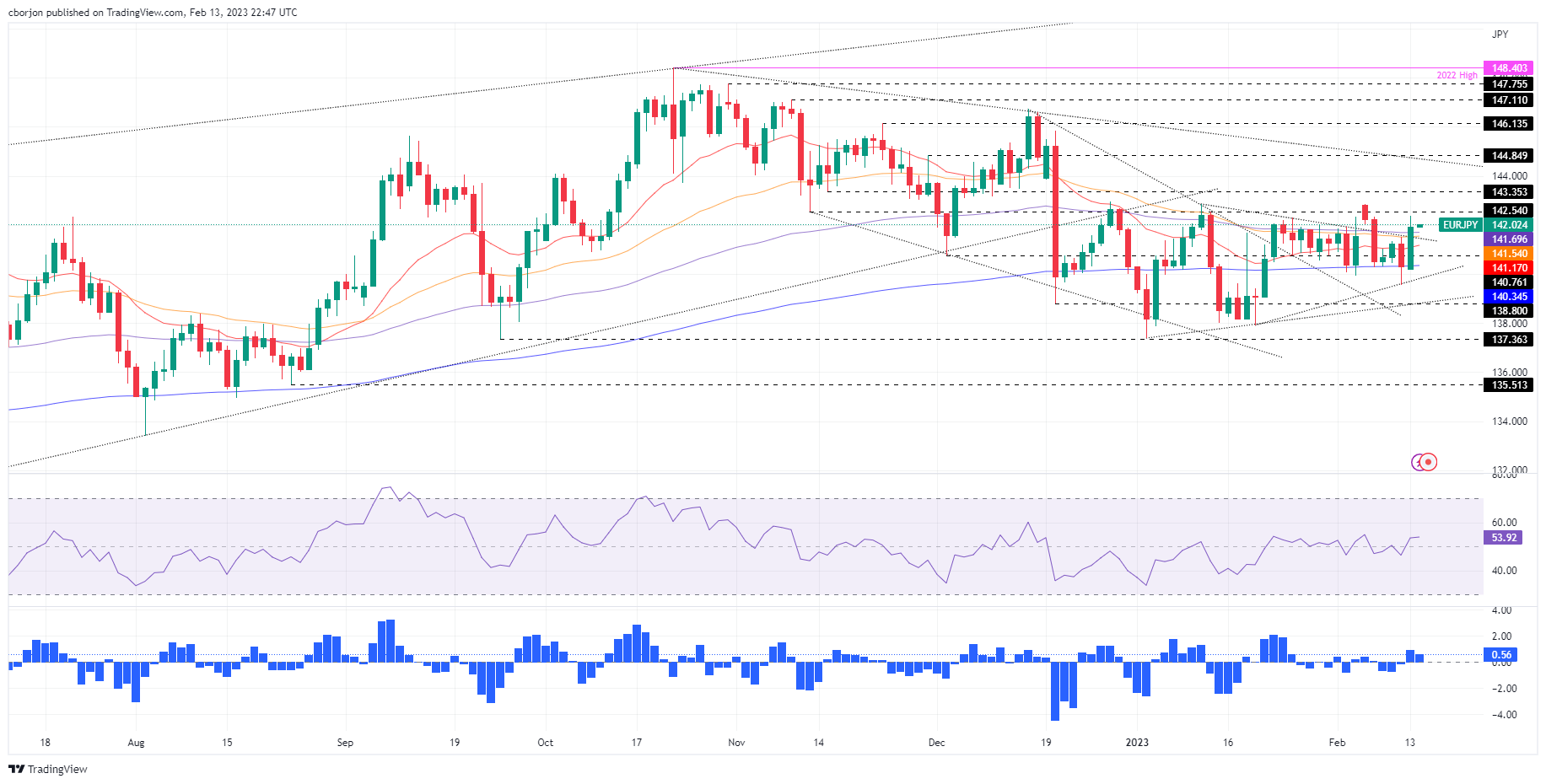
EUR/JPY Key technical levels
- USD/CAD is expected to deliver sheer weakness below 1.3330 amid the risk-off mood.
- A breakdown of the Ascending Triangle pattern has strengthened the Canadian Dollar.
- The Loonie is exposed to the horizontal support at 1.3226 after a breakdown of the RSI (14) into the 20.00-40.00 range.
The USD/CAD pair is hovering around the critical support of 1.3326 in the early Asian session. The Loonie asset is demonstrating signs of refreshing its eight-day low below 1.3326 as the risk appetite theme has gained sheer traction. The market mood has turned cheerful as investors have digested the consequences of a surprise rise in the United States inflation ahead.
The US Dollar Index (DXY) retreated after a pullback move to near the 103.00 resistance. S&P500 futures are showing immense strength despite the airborne threats to the United States after back-to-back unidentified flying objects near the US air base. Meanwhile, easing uncertainty for US Consumer Price Index (CPI) has pushed 10-year US Treasury yields lower to near 3.70%.
USD/CAD has delivered a downside break of the Ascending Triangle chart pattern formed on a four-hour scale. The upward-sloping trendline of the aforementioned chart pattern is placed from February 08 low at 1.3360 while the horizontal resistance is plotted from January 31 high at 1.3472. The major has slipped below the 50-period Exponential Moving Average (EMA) at 1.3385, indicating more weakness ahead.
Meanwhile, the Relative Strength Index (RSI) (14) has slipped into the bearish range of 20.00-40.00, which indicates that the downside momentum has been triggered.
A downside move below February 13 low at 1.3325 will drag the Loonie asset toward February 2 low at 1.3262. A slippage below the latter will expose the asset to the horizontal support plotted from November 15 low at 1.3226.
On the flip side, a break above February 7 high at 1.3469 will drive the asset toward January 19 high at 1.3521 followed by January 6 low at 1.3538.
USD/CAD four-hour chart
-638119250862147414.png)
Bloomberg came out with the analysis suggesting further challenges to the Bank of Japan’s (BoJ) easy money policy during the incoming Kazuo Ueda’s reign. The news initially said, “With the nomination for the top BOJ job set to be announced Tuesday, bond traders are wagering on a further tweak to yield curve control sooner rather than later and pricing in an end to negative rates around the middle of the year.”
Key findings (via Bloomberg)
Benchmark yields have been holding close to the BOJ’s 0.5% policy ceiling this month on concerns that Ueda will have to either tweak or completely abandon the curve-control program amid rising inflation.
Forward-dated swaps are pricing in a removal of the BoJ’s negative-rate policy in July followed by a series of hikes in short-term interest rates.
The yen has jumped more than 12% since the end of October, outperforming all of its Group-of-10 peers, thanks to a boost from the BOJ unexpectedly doubling its 10-year yield cap in December.
Three-month implied volatility for the Japanese currency has been elevated since October even as an equivalent gauge for the broader market declined, indicating that traders are on guard for another BOJ surprise.
Bets on an expected demise of yield-curve control and policy tightening overseas have necessitated an increase in central bank intervention to defend its yield cap.
The fragile state of the bond market provides further evidence that Kuroda’s unprecedented quantitative easing may have only a limited time left.
USD/JPY grinds higher
It should be noted that the Japanese government is up for formally announcing their nominations for the BoJ leadership on Tuesday, making Bloomberg’s piece important for the USD/JPY pair traders. Also highlighting the Yen pair is the presence of the first reading of Japan’s fourth quarter (Q4) Eurozone Gross Domestic Product (GDP).
That said, the USD/JPY pair remains mildly bid near 132.40 amid the market’s cautious optimism during early Tuesday morning in Asia.
Also read: USD/JPY Price Analysis: Rejected at 133.00 but remains firm at around 132.40s
- AUD/USD is facing soft barricades around 0.6970 ahead of the US Inflation data.
- A surprise rise in the US CPI figure could dampen the market mood
- RBA Lowe’s speech will guide about the likely monetary policy action in March.
The AUD/USD pair showed a firm recovery in Monday’s trading session as investors ignored the consequences of a surprise upside in the United States inflationary pressures and geopolitical tensions amid airborne threats to the US. The Aussie is struggling to extend gains above 0.6970 in the early Asian session, however, the upside looks favored considering the strength in the recovery movement.
The US Dollar index (DXY) was heavily offered by the market participants and surrendered the critical support of 103.00. The USD Index is facing hurdles in reclaiming the 103.00 resistance as the market mood is quite cheerful. S&P500 futures recovered dramatically and displayed strong gains, conveying that investors have digested the uncertainty ahead of the US Consumer Price Index (CPI) data. An improvement in the risk appetite of investors strengthened the risk-sensitive currencies.
After printing a fresh monthly high, the return generated on US Treasury bonds dropped firmly. The 10-year US Treasury yields slipped firmly to near 3.70%.
No doubt, the risk-perceived assets have shown resilience ahead of the US inflation data. However, the recovery move could be faded as a rebound in the inflationary pressures after recognizing a downside trend could dampen the market sentiment.
According to analysts from ING, core inflation is to rise to 0.4% MoM. A 0.4% MoM core CPI print (or possibly even 0.5%) would give the Federal Reserve (Fed) near-term ammunition to argue for a May rate hike. Nonetheless, we think that shelter and cars will contribute to inflation slowing sharply from a mid-second quarter, with weakening corporate pricing power also contributing to getting inflation down to 2% by year-end.”
Meanwhile, the Australian Dollar is likely to dance to the outcome of the speech from Reserve Bank of Australia (RBA) Governor Philip Lowe, which is scheduled for Wednesday. The speech from RBA’s Lowe will provide cues about the likely monetary policy action in March.
- EUR/USD bounces off 50-day EMA as US Dollar eases ahead of the key data.
- Risk sentiment improved on easing US-China fears despite “unidentified objects”.
- EC quarterly economic forecasts added strength to the Euro pair’s recovery.
- US inflation expectations hint at firmer print but Fed hawks need strong number to push back policy pivot talks.
EUR/USD holds onto the week-start gains from the five-week low around 1.0725-30 during early Tuesday morning in Asia. The major currency pair benefited from the improvement in market sentiment, as well as the broad Euro gains ahead of the key statistics from the Eurozone and the US.
The week began with a risk-off mood amid the US-China tensions surrounding the mystery objects that flew over their boundaries and allegations of spying. However, the US General turned down the fears while rejecting calls to believe that those flying objects were from China. Adding strength to the risk-on mood were upbeat US equities and data from the Eurozone, not to forget the market’s positioning ahead of the preliminary readings of the fourth quarter (Q4) Eurozone Gross Domestic Product (GDP) and the US Consumer Price Index (CPI) for January.
On Monday, the European Commission (EC) released its quarterly economic projections for the Eurozone wherein it revised up the economic growth forecast to 0.9% for 2023 from 0.3% previously expected, projecting 2024 growth unchanged at 1.5%. The EC, however, lowered the Eurozone inflation forecast for 2023 to 5.6% YoY from 6.1% earlier expected. Further, the EC also cut 2024 inflation predictions to 2.5% for 2024, versus 2.6% previously anticipated.
It should be noted, however, that the hopes of firmer European inflation contrasted with the mixed comments from the European Central Bank (ECB) officials to probe the EUR/USD bulls.
That said, according to economists polled by Bloomberg, Euro area inflation is still likely to loom above the European Central Bank (ECB) target of 2.0% heading further out in 2025.
Further, European Central Bank (ECB) Vice-President Luis de Guindos said on Monday, “Rate increases beyond March are to depend on data.” On the same line, ECB policymaker Mario Centeno said, “Inflation is going down faster than we expected,” while adding that smaller hikes would need mid-term inflation nearing 2%.
On the other hand, Fed Governor Michelle Bowman said on Monday that the Federal Reserve will need to continue to raise interest rates in order to get them to a level high enough to bring inflation back down to the central bank's target rate, per Reuters. Before him, Philadelphia Federal Reserve President Patrick Harker pushed back the chatters of a Fed rate cut during 2023. However, the policymaker did mention, “Fed not likely to cut this year but may be able to in 2024 if inflation starts ebbing.” His comments were mostly in line with Fed Chair Jerome Powell’s cautious optimism and hence challenged the US Dollar buyers.
Against this backdrop, Wall Street closed with gains while the US Treasury bond yields snapped a two-day uptrend.
Moving on, EUR/USD might remain lackluster moves ahead of the key EU Q4 GDP and the US CPI for January as policymakers at the ECB and the Fed appeared to have eased their hawkish bias. As a result, softer prints of the data may weigh on the respectively, with higher odds in favor of the Euro’s pullback than the US Dollar considering the early signals for the inflation number. That said, the first reading of the Eurozone Q4 GDP is expected to repeat 1.9% YoY figures while the US CPI could ease to 6.2% YoY versus 6.5% prior.
Technical analysis
EUR/USD rebounds from the 50-day Exponential Moving Average (EMA), around 1.0675 by the press time, to portray the latest recovery from the five-week low. However, the 21-day EMA and the previous support line from early November 2022, respectively near 1.0770 and 1.0925, appears important resistances to crack for the bulls to retake control.
- NZD/USD short squeeze is in full effect to start the week.
- NZD/USD bulls eye the 50% mean reversion for space in the 0.64s for the day ahead.
NZD/USD rallied at the start of the week, ending the US session some 0.8% higher near 0.6360 as a result of rapped bears being squeezed in the open. A rebound in global risk appetite and a slight pullback in the USD DXY index ahead of key US CPI later today influenced positioning also.
''Arguably the biggest threat to the Kiwi lies in US bond yields, which could keep rising if markets shy away from cuts,'' analysts at ANZ Bank argued.
''But that might be a lengthy process, and local bond yields are also rising. So it’s more balanced, but we do think it makes sense to plan for volatility given the higher than normal degree of uncertainty.''
Meanwhile, the technicals played out as follows:
NZD/USD daily chart
We have a bullish inverse head and shoulders shaping up on the daily chart but the price is being resisted by a dominant trendline.
NZD/USD H1 chart

Meanwhile, we had three days of shorts in the market and Monday trapped the ones that joined the party late only to be ushered out of the door by the bulls from the off. Bulls eye the 50% mean reversion for space in the 0.64s for the day ahead.
- The GBP/JPY rallied more than 200 pips on Monday, ahead of the release of US inflation data.
- GBP/JPY Price Analysis: Short term, could challenge 158.00; otherwise, a rally to 162.00 is on the cards.
The GBP/JPY breaks above the top of a trading range, advancing sharply toward the top-trendline of a descending triangle in a downtrend, at 161.19, the day’s high, but retraced some of its gains. Hence, the GBP/JPY is trading at 160.66, above its opening price by 1.43%.
After reaching the day’s high in the session, the GBP/JPY did not hold to its gains above the 50-day Exponential Moving Average (EMA) at 160.78. That would have opened the door to challenge the confluence of the 200 and 100-day EMAs, each at 161.81 and 162.00. However, the symmetrical triangle top trendline capped the advancement as bears piled in, dragging prices lower.
In the short term, the GBP/JPY four-hour chart portrays the cross-currency as range-bound based on the EMAs residing beneath the spot price. Nevertheless, as the Relative Strength Index (RSI) turned overbought but exited from that territory, the GBP/JPY dropped from around daily/weekly highs.
If the GBP/JPY edges downwards, it will face a solid support area. Firstly the 200-EMA at 160.03, which, once cleared, could pave the way towards the 159.14/32 area, the confluence of the 20/50/100 EMAs. A decisive break will send the GBP/JPY diving towards the ascending triangle bottom trendline at around 158.18.
On the flip side, if the GBP/JPY reclaims 161.80, it will open the door to challenge 162.00.
GBP/JPY 4-Hour Chart
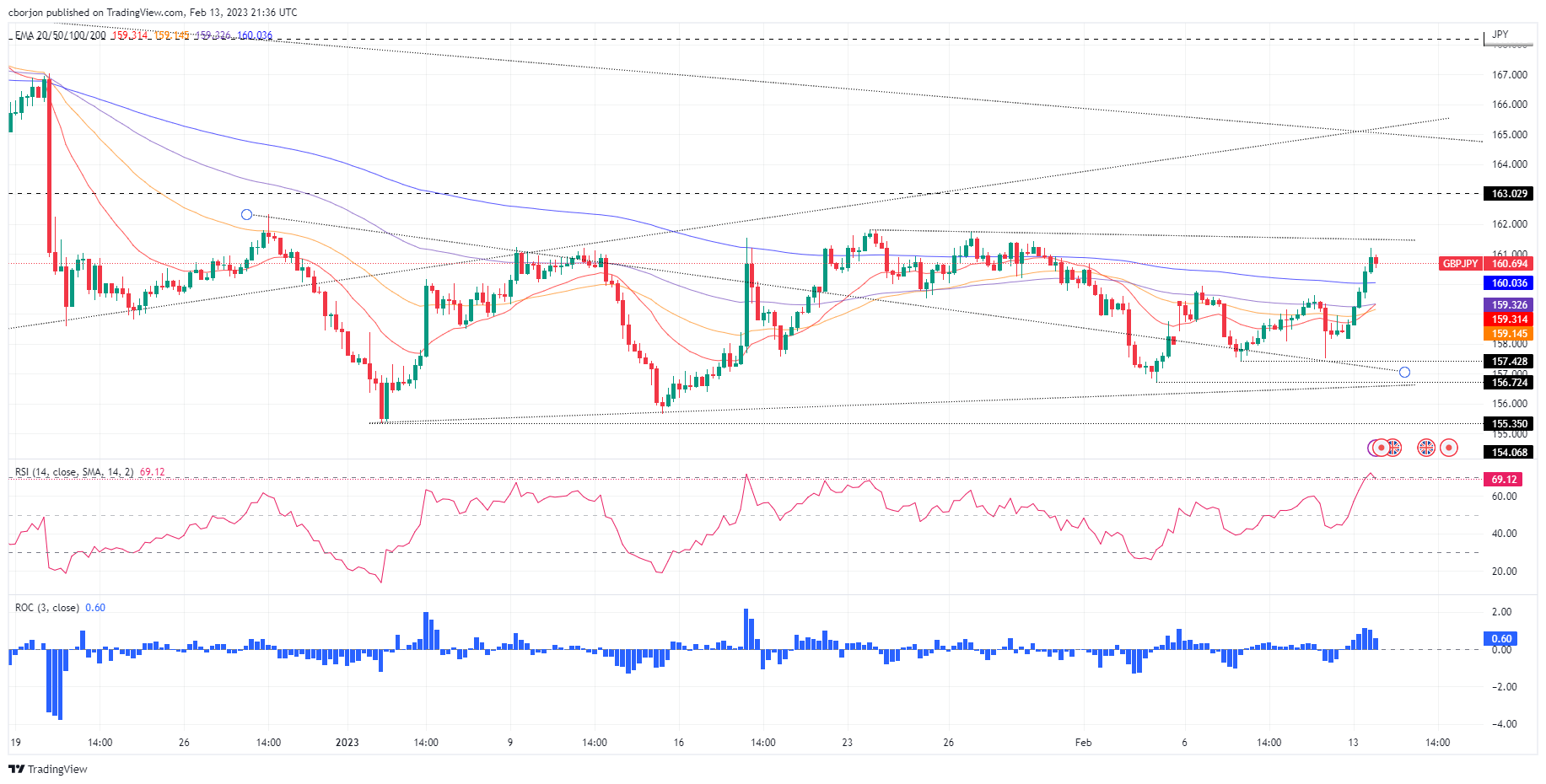
GBP/JPY Key technical levels
- Gold price bulls eye the 50% mean reversion as a resistance area that could hold.
- Gold price bears seek a break of $1,850 for the continuation to the $1,825 1000 pip target.
- US CPI is a critical event for the Gold price this week.
Gold price was choppy in New York but decisively bearish as per the technicals and failures to rally even on US Dollar weakness as the session got going around the London fix and Wall Street's cash open. Gold price is currently trading at $1,850 and at the bottom of a new box that was formed in Friday's sell-off. The yellow metal dropped on Monday in a continuation of that move and from the day's high set in Asia at $1,866.59.
US Consumer Price Index key for Gold Price
Gold is pressured as investors get set for a very heavy week of data in the United States where we start on Tuesday, with what could be a robust 6.2% annualized Consumer Price Index outcome for the prior month. When combined to the unexpectedly strong January jobs report released earlier this month, in the Nonfarm Payrolls, this data could really kick off a storm in markets that are otherwise front-running the Federal Reserve and are pricing in a picot for later in the year.
Analysts at TD Securities explained that ''core prices likely stayed strong in January with the index rising 0.4% MoM (matching Dec's upward-revised gain), as we look for the recent relief from goods deflation to come to an end.''
''Shelter inflation likely remained the key wildcard, while a rebound in gasoline prices will be the main driver of non-core CPI prices. Our MoM forecasts imply 6.2%/5.5% YoY for total/core prices.''
However, there are mixed outlooks for the CPI data with some analysts anticipating a hawkish outcome while others a dovish one.
For instance, while some analysts anticipate a more benign outcome from the data, analysts at Brown Brothers Harriman argued that a move higher in US Treasury yields of late, (10-year rose from Thursday's low of 3.334% to a recent high of 3.755%), coincides with renewed inflation concerns and a reprising of Fed tightening expectations.
''WIRP suggests 25 bp hikes March 22 and May 3 are nearly priced in, while the odds of a third hike in June or July top out near 45%,'' the analysts said. ''Strangely enough, an easing cycle is still expected to begin in Q4 but we believe that will be corrected in the next stage of Fed repricing, which may come after CPI and Producer Price Index data this week,'' they argued.
On the other side of the narrative, analysts at TD Securities said that they anticipated a dovish outcome that will be underscoring the prospects that the recent pain trade starts to reverse.''
''The latest USD correction was inspired mostly by extreme positioning and short-term risk premium, which has also started to correct,'' they noted. ''Plus, the strong employment numbers did little to rattle the Fed, which has helped reinforce the soft-landing narrative.''
''The upshot is that if CPI complies with our forecasts this week, that should kick-start a new round of broad US selling,'' the analysts at TD argued, paving the way for bullish prospects of the euro that is negatively correlated to US selling.
Meanwhile, the Federal Reserve speaker Governor Michelle Bowman said the following at the start of the week:
"I expect we'll continue to increase the federal funds rate because we have to bring inflation back down to our 2% goal and in order to do that we need to bring demand and supply into better balance," Bowman said during an American Bankers Association conference in Florida.
Once at a sufficiently restrictive level, interest rates will then need to be held for "some time" to restore price stability, she added.
Bowman rounded off by saying that a very strong labour market alongside moderating inflation meant a so-called economic 'soft landing' remains possible.
Gold technical analysis
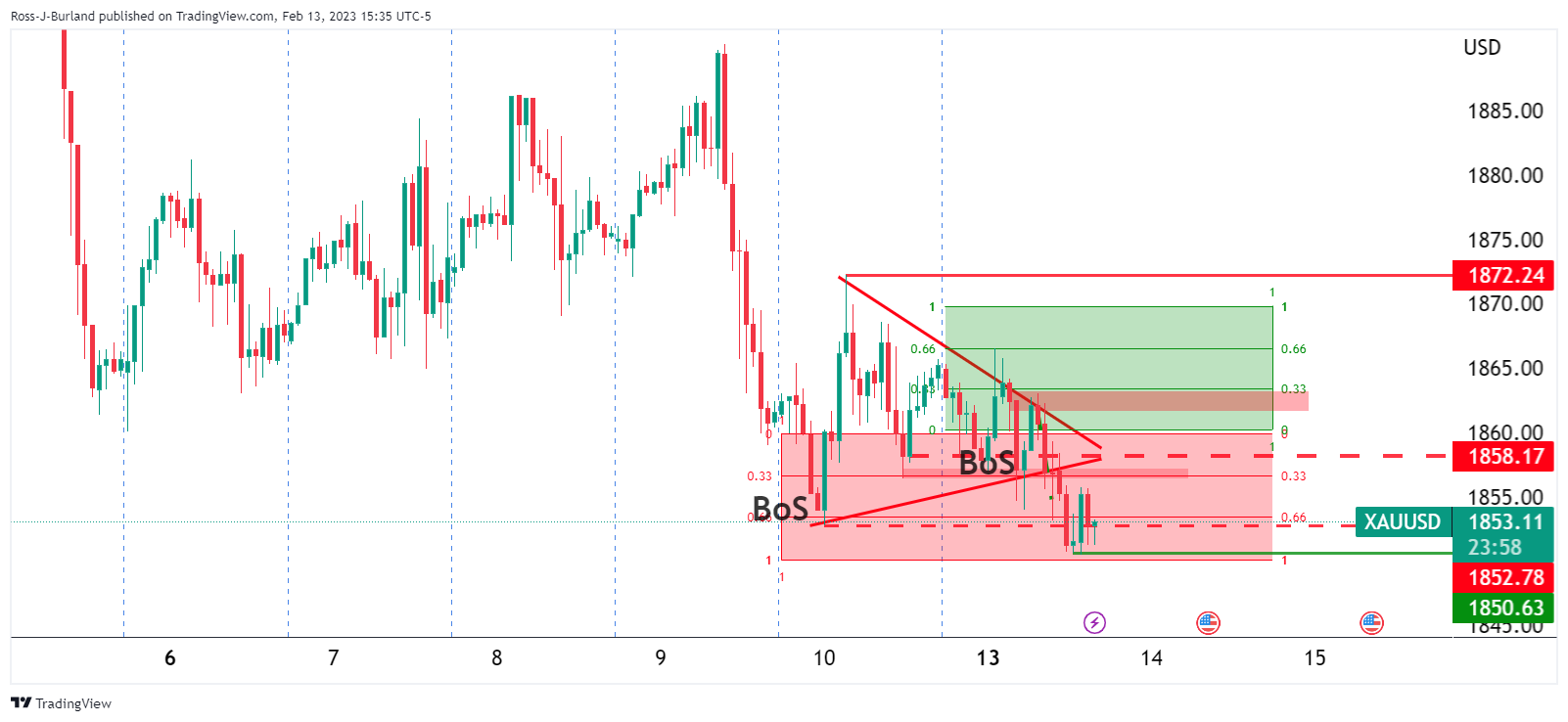
The breaks of the structures have occurred over the past couple of days and shorts are building, penetrating deeper territories. However, a correction could be on the cards as follows:
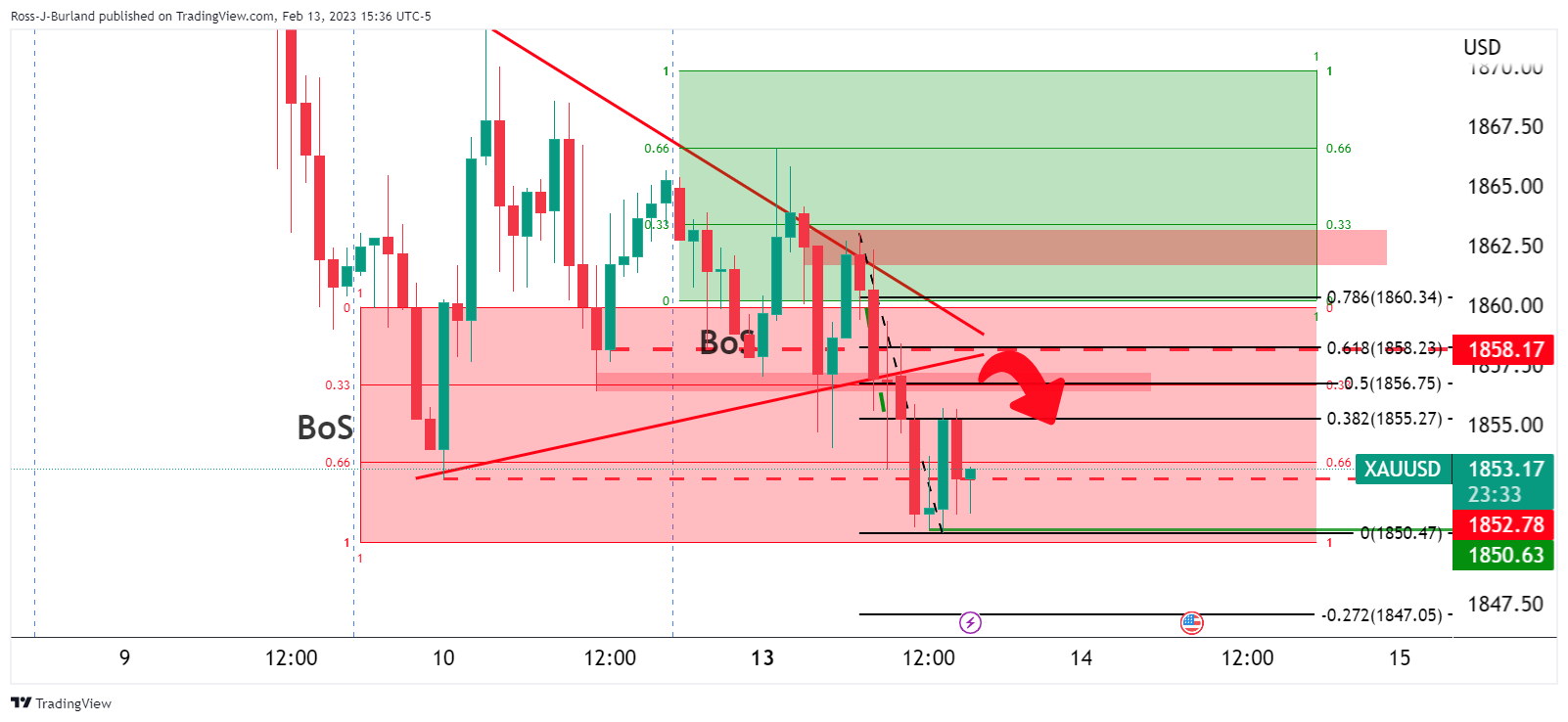
The 50% mean reversion is a resistance area that could hold and result in a downward continuation with $1,850 eyed. This guards a move to the 1000 pip box target of $1,825 made in prior analysis:
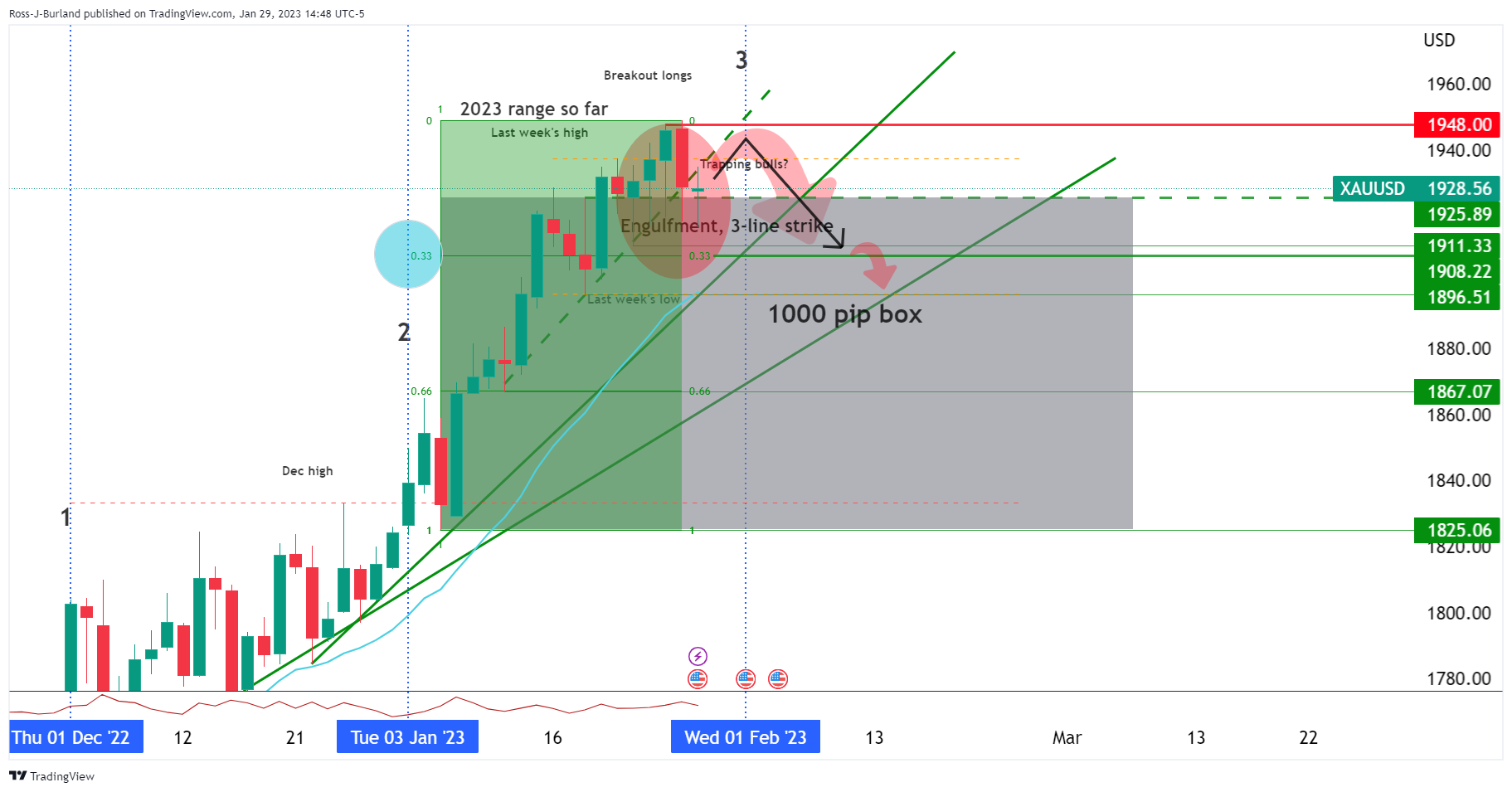
What you need to take care of on Tuesday, February 14:
Tensions between the US and China weighed on the market mood at the weekly opening, with the Greenback making the most out of it. However, a better market mood during European trading hours pushed the US Dollar into the red across the FX board.
Still, the absence of relevant macroeconomic releases and the upcoming US Consumer Price Index update limited the intraday US Dollar slide. Market players await the release of the January United States Consumer Price Index (CPI). Inflation is foreseen raising at an annualized pace of 6.2%, easing from 6.5% YoY in December. The core reading, excluding volatile food and energy prices, is expected at 5.5%. Although the US Federal Reserve does not base its decision on this particular figure, it has a high impact on financial markets, as it reflects price pressures in the country.
The EUR/USD pair bottomed at 1.0655, bouncing towards the 1.0720 price zone. The pair retains gains in early Asia, despite ignoring early headlines. The European Commission released the quarterly Economic Growth Forecasts report. Economic growth in the Euro Zone has been upwardly revised, now seen at 0.9%. Additionally, inflation forecasts have been downwardly revised to 5.6% for this year and 2.5% in 2024.
The British Pound was among the best performers, advancing vs its American rival to 1.2144, retreating modestly ahead of the close. The UK will publish its latest employment figures on Tuesday.
The AUD/USD pair currently trades at around 0.6960, while USD/CAD is down to the 1.3330 region, with commodity-linked currencies benefiting from the better tone of Wall Street. US indexes pulled back from their intraday highs but anyway ended the day with gains.
Government bond yields seesawed across the day, appreciating during Asian trading hours but shedding some ground at the end of the day amid a better mood. However, the yield on the 2-year Treasury note advanced, while that on the 10-year note finished the day pretty much unchanged.
Spot gold eased and trades at fresh February lows just above $1,850 a troy ounce. Crude oil prices, on the other hand, followed equities with WTI up to $80 a barrel.
Like this article? Help us with some feedback by answering this survey:
- GBP/USD short squeeze takes out the weaker hands start of the week.
- GBP/USD downside thesis on the daily chart is still valid around the US CPI event.
GBP/USD has been on a tear as it pulls away from the start of the day's trapped shorts that were seeking a break below 1.2050 for the initial balance for the week. At the time of writing, GBP/USD is trading at 1.2140 and up 0.8% on the day.
The following is an illustration of the price action and thesis for a long in the New York session ahead of this week's critical US Consumer Price Index and Retail Sales data the following day.
GBP/USD daily chart
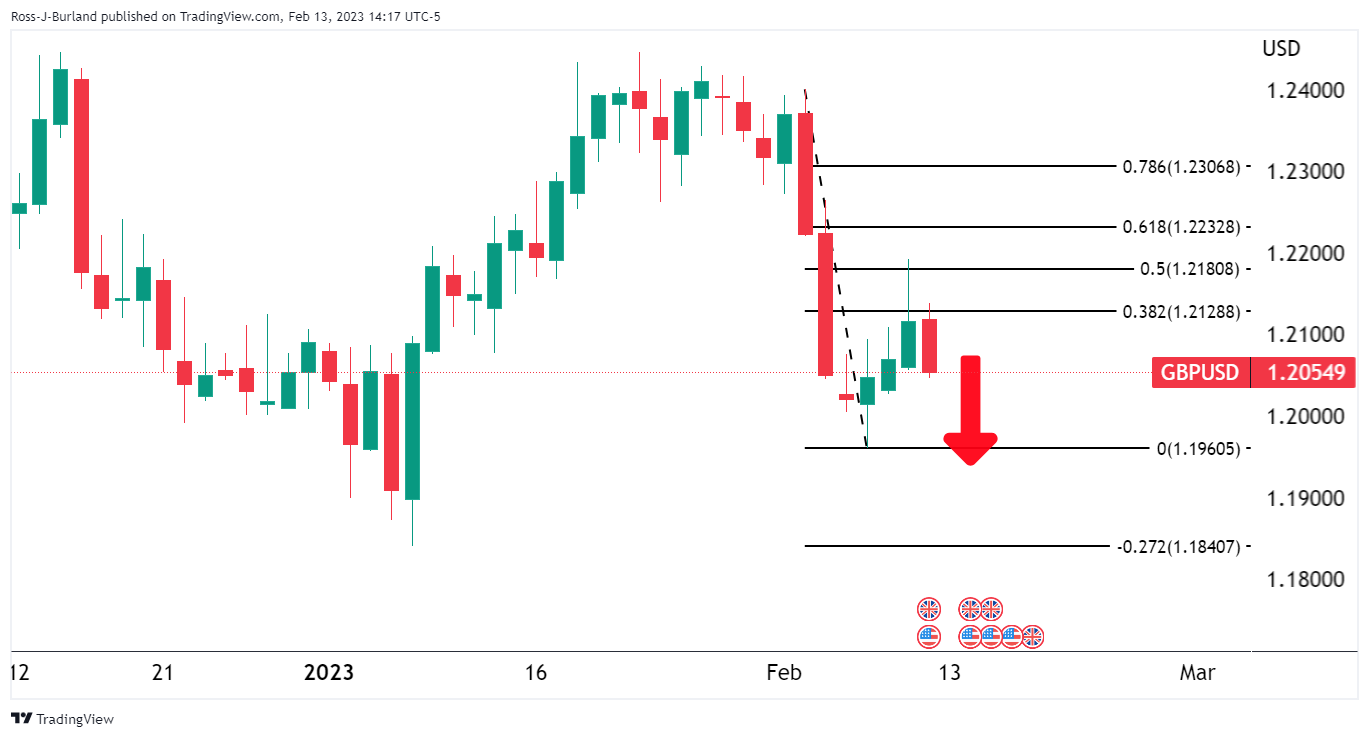
at first glance prior to the day, the market was appearing to be set up for a downside continuation given the correction to the 50% mean reversion and strong rejection from the bears. However...
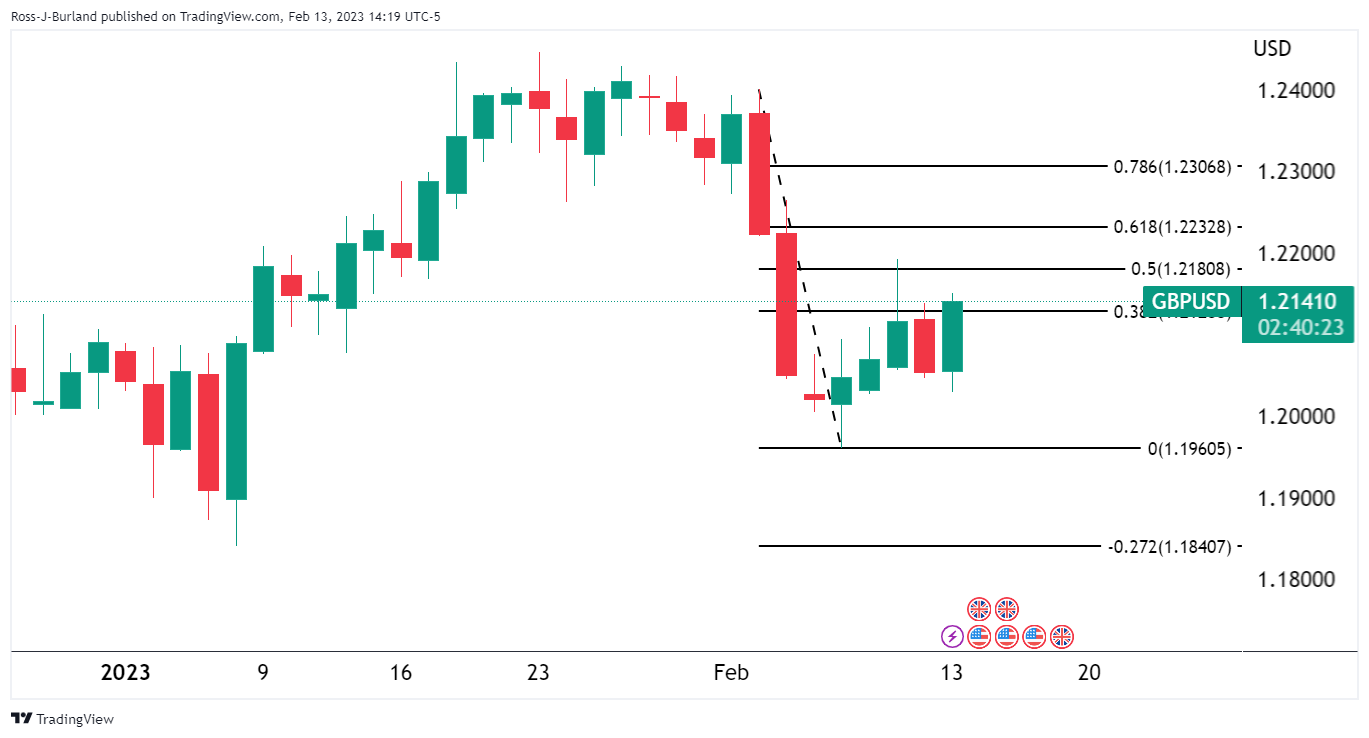
The bulls put on a short squeeze as illustrated above.
GBP/USD M15 chart
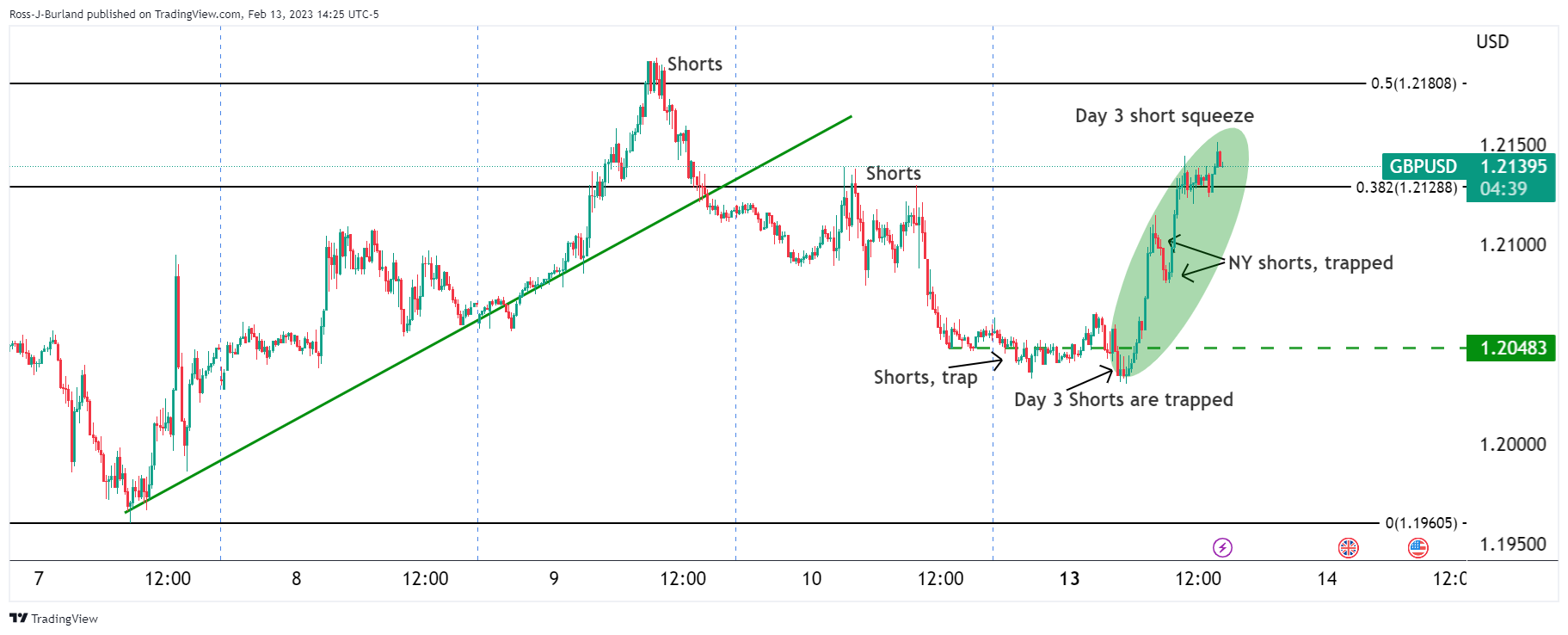
As illustrated, the market was overwhelmed with sellers and the bulls took advantage of this to start the week. On Thursday, an influx of supply came on and Friday had more shorts coming into the market. On Monday, the bears attempted to get on board with what appeared to be a downside extension and breakout opportunity below 1.2050. However, there was a break of structure to the long side as follows:

GBP/USD bears still in play
Nevertheless, the downside thesis on the daily chart is still valid around the US CPI event with the price still below the 1.2200 psychological level and a 50% mean reversion resistance that has a confluence with prior support looking left:
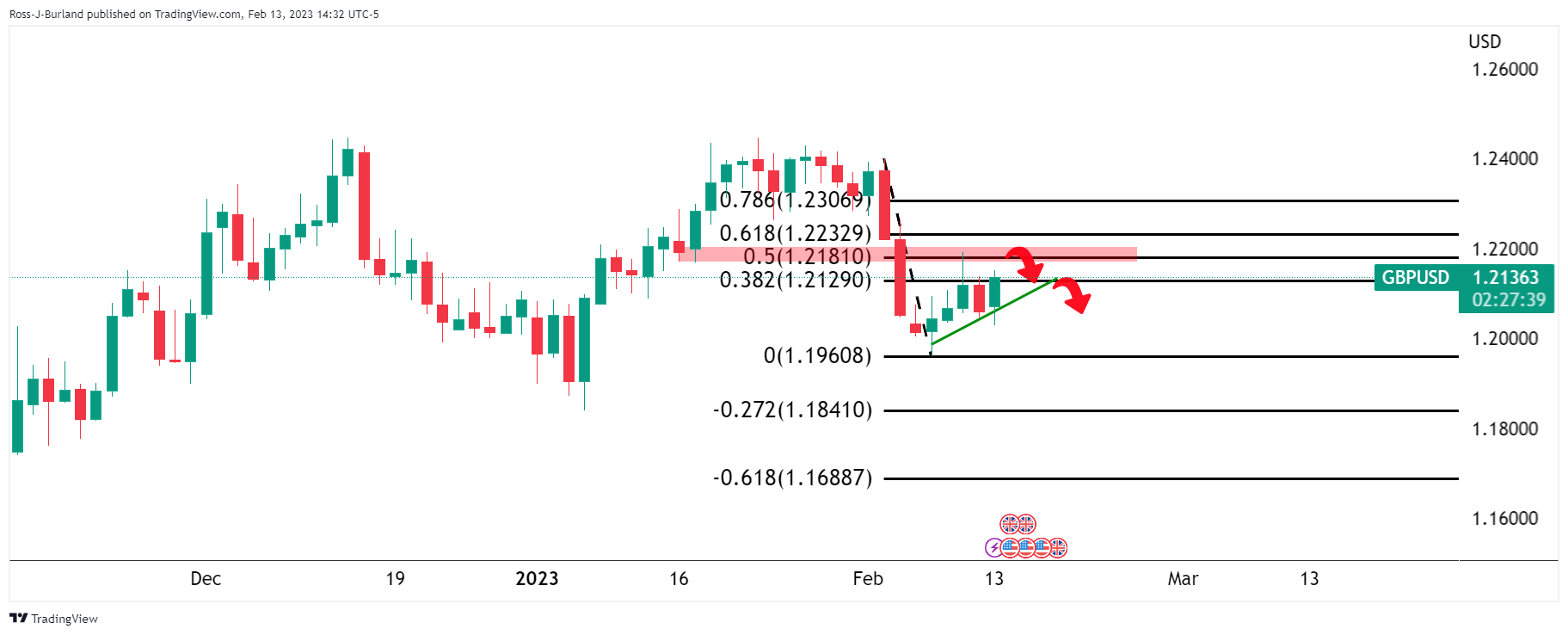
- USD/JPY advanced sharply toward 132.40 on Monday, spurred by a risk-on impulse.
- The daily chart suggests the pair as neutral-upwards biased.
- Short term, the USD/JPY 4-hour chart, depicts the pair would trade within 131.80-133.00.
The USD/JPY climbs as the New York session progresses, up by 0.77%, hitting a new six-week high at 132.90. Nevertheless, the major failed to hold to its gains and was rejected toward the 132.40 area. At the time of writing, the USD/JPY is trading at 132.44.
From a daily chart perspective, the USD/JPY climbed and pierced the last week’s high around 132.90 to retreat to 132.50s. The USD/JPY retracement was spurred by the 50-day Exponential Moving Average (EMA) At 132.66; albeit broken, the USD/JPY pair slid beneath the latter. Although the pair is trading off the day’s high, the USD/JPY bias in the near term is tilted to the upside.
Zooming into the 4-hour chart, after the USD/JPY consolidated during the last week in the 130.30-131.80 area, it broke the top of the range, but solid resistance around 133.00, capped the USD/JPY rally. Nevertheless, the USD/JPY might begin trading in a higher range, within the 131.80-133.00 area, ahead of US inflation data to be revealed on Tuesday, around 13:30 GMT
If the report shows that inflation continues to edge lower, the USD/JPY could aim toward the 200-EMA at 131.49, ahead of the 131.00 figure. Once those demand areas are cleared, the 100-EMA would be exposed at 130.84.
Conversely, higher-than-expected inflation would pave the way for further upside. Therefore, the USD/JPY first resistance would be 133.00. Break above, and the 134.00 figure is next, followed by the January 6 high at 134.77.
USD/JPY 4-hour chart
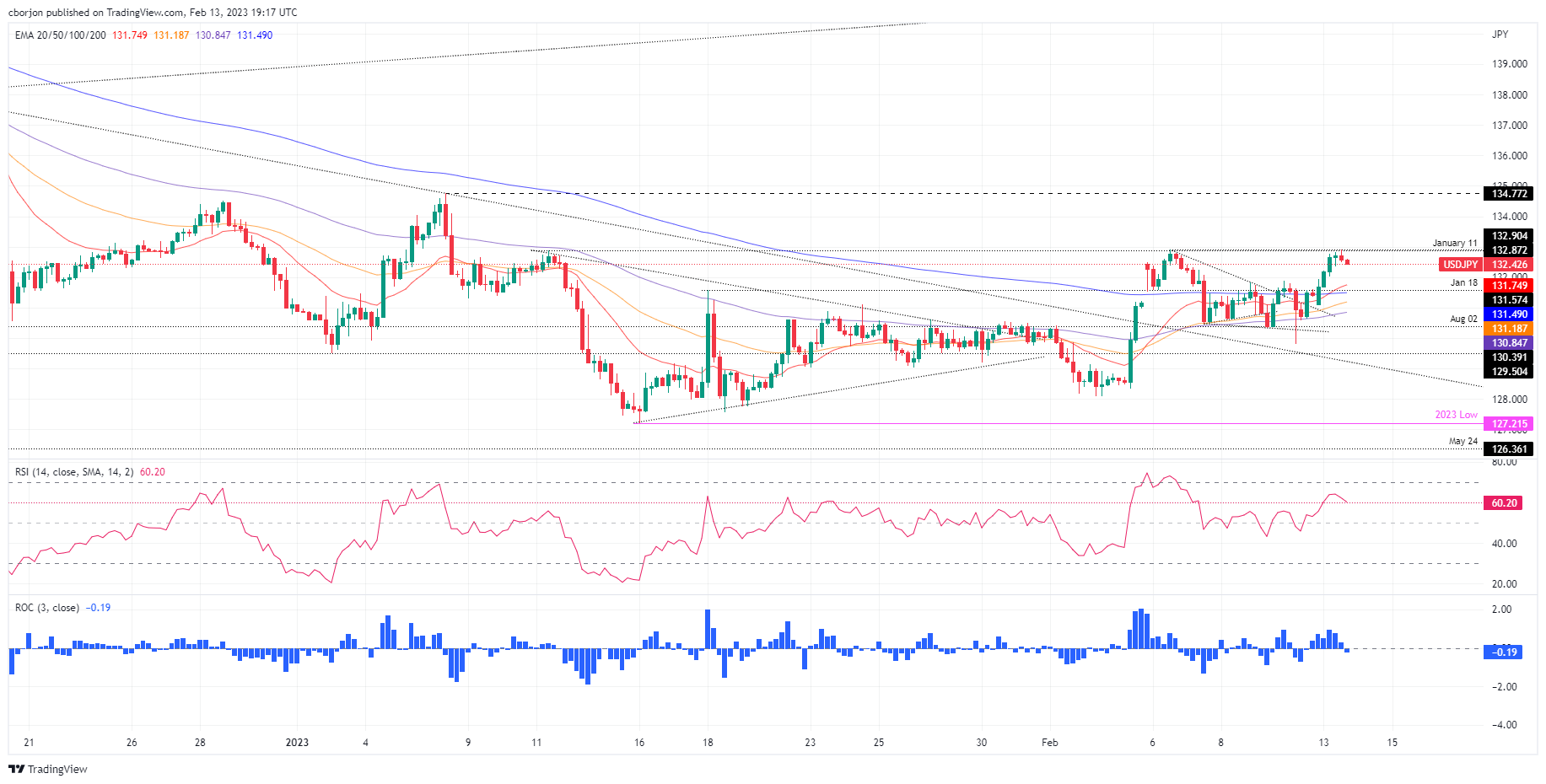
USD/JPY Key technical levels
- EUR/USD has run up high in a short squeeze as traders look ahead to US CPI.
- Beares are lurking with eyes on 1.0600 on the downside.
EUR/USD has been testing a critical high in the midday session on Wall Street following what had been a positive start for the day for the US Dollar. At the time of writing, EUR/USD is trading up high for the day at 1.0727 and has gained 0.4% so far following a rally from the Asian lows of 1.0655 within a 93 pip Average True Range (ATR).
Fundamentally, it's all about the Federal Reserve and positing in front of the key data event for the week ahead in the United States of America's Consumer Price Index with Retail Sales as a sideshow the following day. There are mixed outlooks for the CPI data with some analysts anticipating a hawkish outcome while others a dovish one.
Federal Reserve speakers have already been out of the gate this week with hawkish rhetoric. Fed Governor Michelle Bowman said the following:
"I expect we'll continue to increase the federal funds rate because we have to bring inflation back down to our 2% goal and in order to do that we need to bring demand and supply into better balance," Bowman said during an American Bankers Association conference in Florida.
Once at a sufficiently restrictive level, interest rates will then need to be held for "some time" to restore price stability, she added.
Bowman rounded off by saying that a very strong labour market alongside moderating inflation meant a so-called economic 'soft landing' remains possible.
Meanwhile, analysts at Brown Brothers Harriman argued that a move higher in US Treasury yields of late, (10-year rose from Thursday's low of 3.334% to a recent high of 3.755%), coincides with renewed inflation concerns and a reprising of Fed tightening expectations.
''WIRP suggests 25 bp hikes March 22 and May 3 are nearly priced in, while the odds of a third hike in June or July top out near 45%,'' the analysts said. ''Strangely enough, an easing cycle is still expected to begin in Q4 but we believe that will be corrected in the next stage of Fed repricing, which may come after CPI and Producer Price Index data this week,'' they argued.
On the other side of the narrative, analysts at TD Securities said ''TD anticipates a dovish CPI report this week, underscoring the prospects that the recent pain trade starts to reverse.''
''The latest USD correction was inspired mostly by extreme positioning and short-term risk premium, which has also started to correct,'' they noted. ''Plus, the strong employment numbers did little to rattle the Fed, which has helped reinforce the soft-landing narrative.''
''The upshot is that if CPI complies with our forecasts this week, that should kick-start a new round of broad US selling,'' the analysts at TD argued, paving the way for bullish prospects of the euro that is negatively correlated to US selling.
EUR/USD technical analysis
Meanwhile, we have the hourly chart's key resistance being tested:
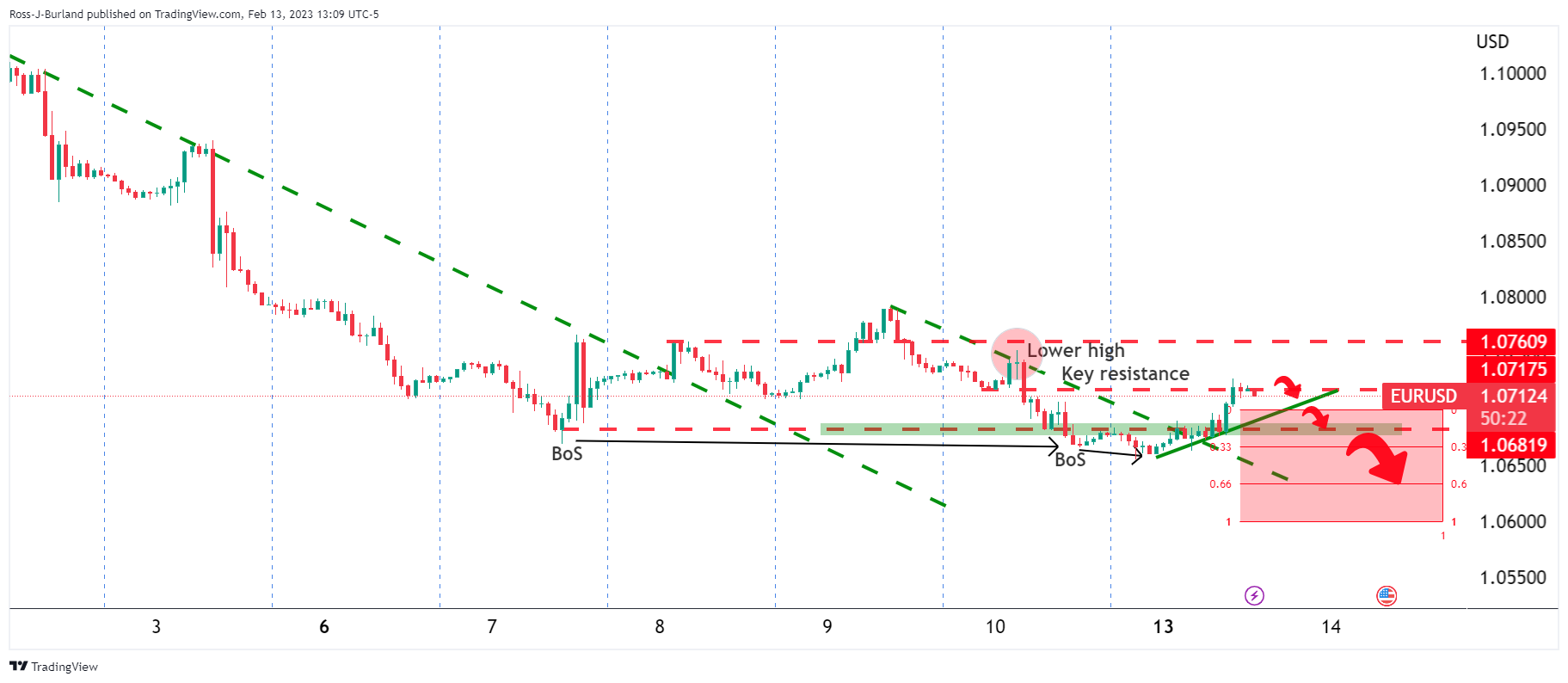
We have a couple of bearish breaks of structures, BoS, on Friday and the start of the week before the move up into the shorts that had gathered over the last couple of days:
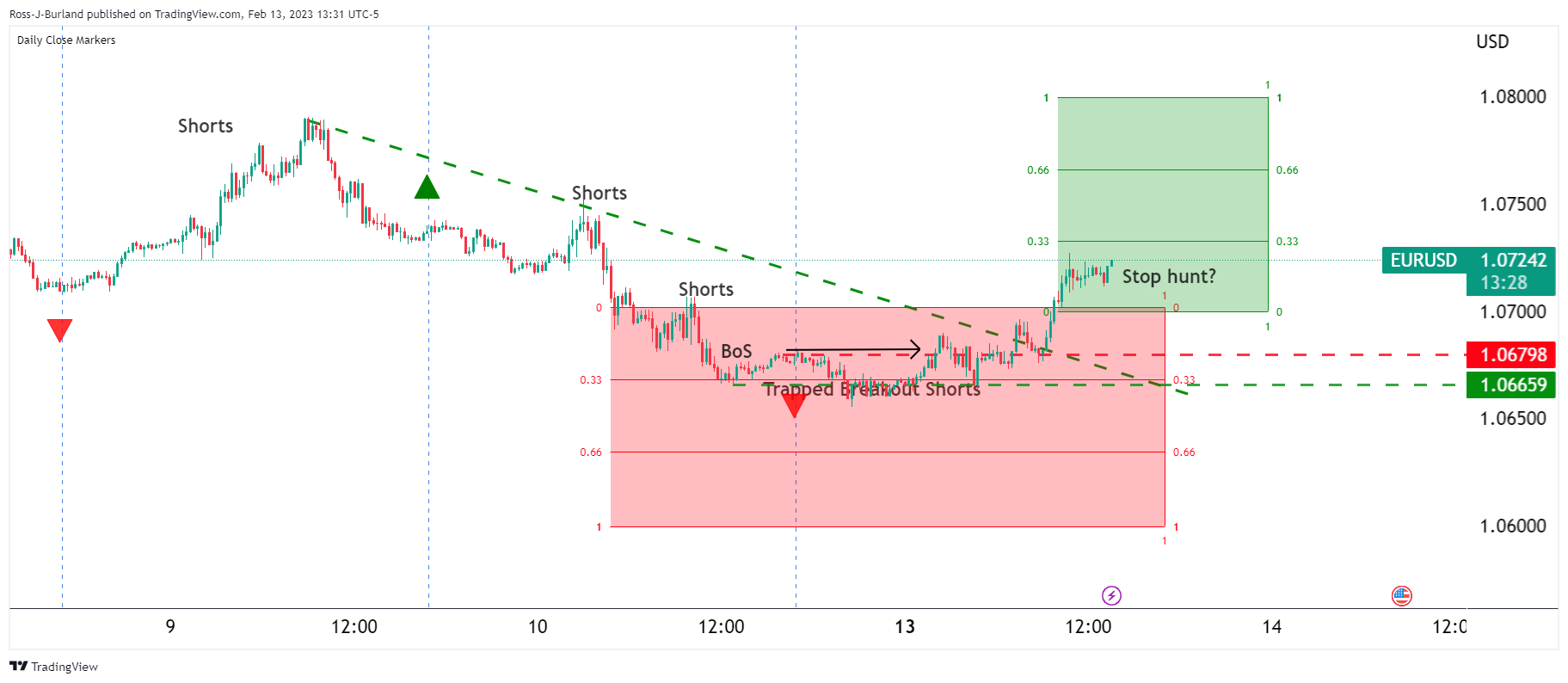
In a short squeeze, the price has burst into a new 100-pip box on the upside but this could just be a momentary pause and correction before the next major move lower.
EUR/USD daily charts
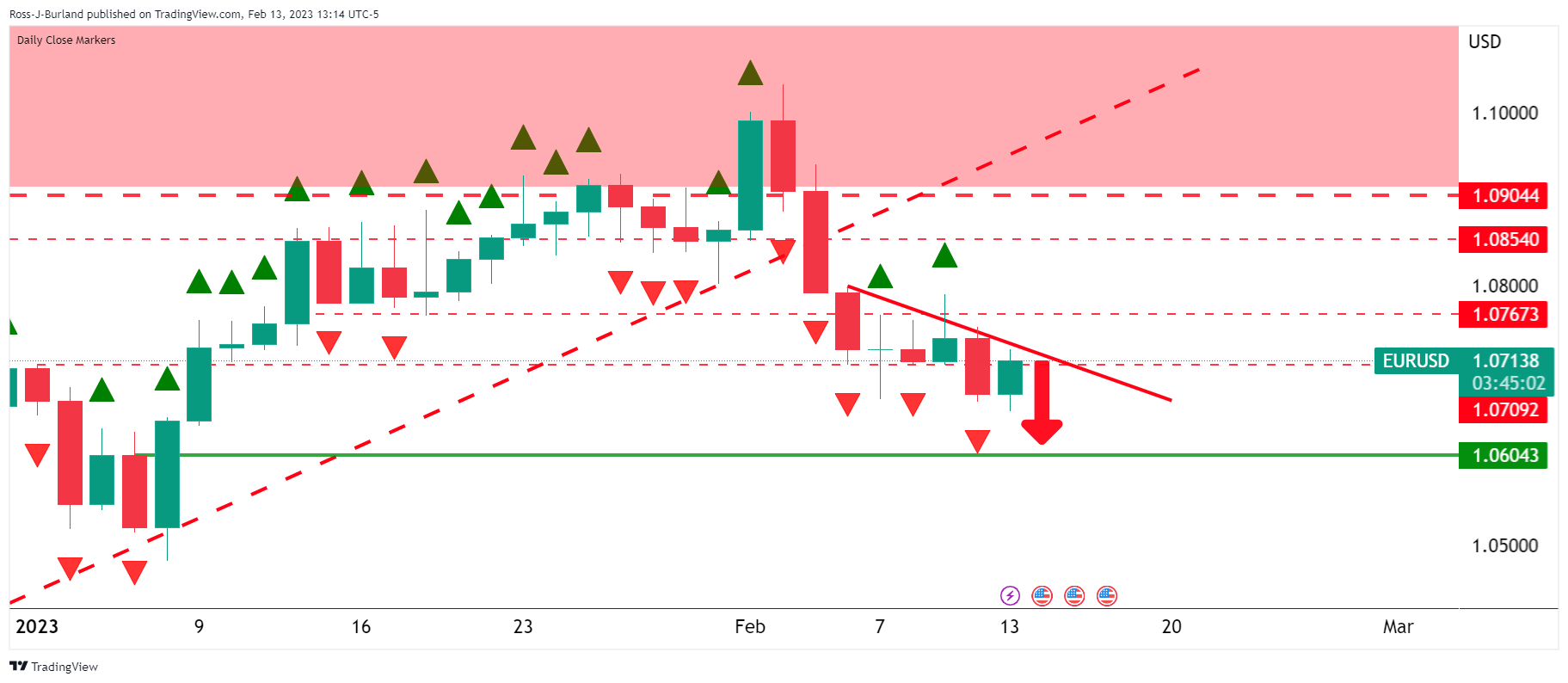
While on the front side of the trend, there are p[prospects of a move lower to test the 1.0600 level for the day (s) ahead.
- AUD/USD encountered support at around 0.6890 and climbed back above 0.6950.
- Inflation in the United States is estimated to cool down, as CPI and Core CPI will be revealed on Tuesday.
- Per the New York Fed, inflation expectations for one year are estimated at around 5%.
- Traders are eyeing the release of Aussie’s Consumer Sentiment and Business Confidence reports.
The AUD/USD edges high in the North American session by 0.75%, spurred by a risk-on impulse, ahead of the release of US inflation data on Tuesday, which is expected cool down, according to a news sources poll. Nevertheless, the jump was capped by Federal Reserve (Fed) Governor Bowman’s hawkish commentary, keeping the major within familiar levels. At the time of writing, the AUD/USD exchanges hands at 0.6966.
US equities continued to climb in the mid-New York session. Inflation expectations in the United States remained firm, as reported by the New York Federal Reserve poll. Data showed that Americans estimate inflation to remain steady at 5%, while for three years, they observe inflation at around 2.7%, down from 2.9% in December. For a five-year horizon, inflation is estimated at 2.5%, vs. 2.4% in the previous month.
AUD/USD is still aiming higher in the day, nearby the highs of the day, underpinned by risk appetite. Traders are awaiting inflation figures from the United States (US), with January’s Consumer Price Index (CPI) foreseen at 6.2% YoY, down from December’s 6.5%, while core data is estimated at 5.5% YoY, from 5.7% in the prior month.
Elsewhere, Federal Reserve (Fed) officials continued to cross wires. Fed Governor Michelle Bowman commented that the Federal Funds Rate (FFR) would need to increase to bring inflation towards its 2% target. She added that the US central bank needs to bring supply and demand into balance.
What to watch?
The Australian economic docket will feature Consumer Sentiment and the NAB Business Confidence report. On the US, the docket will reveal the already mentioned inflation data, along with further Fed speakers, led by Lorie Logan of the Dallas Fed and the NY Fed President John Williams.
AUD/USD Key technical levels
hnical levels
- Gold dives to five-week lows at around $1850 as bears eye the 100-DMA beneath $1820.
- Market participants are eyeing Tuesday’s US CPI data, which could reaffirm the disinflation process has already started.
- XAU/USD Price Analysis: A daily close below $1850 would pave the way toward $1820.
Gold price retreated from last Friday’s highs of $1872.22 and dropped toward the $1850 area on Monday despite the US Dollar (USD) fall, ahead of a vital inflation report from the United States (US). Additionally, US Treasury yields, albeit edging down, remain at around five-week highs. At the time of writing, the XAU/USD is trading at $1852.88.
Gold retraces to $1850 weighed by a risk-on mood
XAU/USD remains pressured, while the US Dollar Index, a measure of the buck’s value vs. a basket of peers, drops 0.18%, down at 103.391, undermined by the US 10-year Treasury bond yield, with the 10-year benchmark not dropping one and a half bps to 3.726%.
Investors are awaiting a report from the Bureau of Labor Statistics (BLS) on Tuesday, revealing the Consumer Price Index (CPI) for January, estimated at 6.2% YoY, lower than the 6.5% in December. The core CPI excludes volatile items like food and energy, which is foreseen at 5.5% YoY, from 5.7% in the previous month.
In the meantime, Fed hawkish commentary continued with the Fed Governor Michell Bownman, who said that the Federal Reserve (Fed) needs to continue to raise rates to get the Federal Funds Rate(FFR) to a sufficiently restrictive level, as the US central bank battles high inflationary pressures.
Of late, the US Federal Reserve of New York revealed inflation expectations for the year hold steady at 5%. For a three-year horizon, the poll showed that inflation would stand at 2.7%, down from December 2.9%, while for a five-year span, it was projected at 2.5%, vs. 2.4 in the prior month.
XAU/USD Technical analysis
Technically speaking, XAU/USD remains neutral to slightly downward biased. At the time of typing, the yellow metal falls beneath the 50-day Exponential Moving Average (EMA) At $1856.58, exacerbating further selling pressure. On the downside, the following support levels would be the December 26 daily high of 1833.29 turned support, followed by the 100-day EMA at 1817.77, and the confluence of the 200-day EMA, and the figure at $1800.

The Federal Reserve Bank of New York's monthly Survey of Consumer Expectations showed on Monday that the US consumers' one-year inflation expectation stayed unchanged at 5% in January.
Further details of the publication showed that the three-year ahead expected inflation declined to 2.7% from 2.9% in December and the five-year ahead expected inflation edged higher to 2.5% from 2.4%.
On a concerning note, the expected household income growth for the year ahead dropped to 3.3% from 4.6%, marking the biggest decline in the survey's history.
Market reaction
The US Dollar Index stays under modest bearish pressure following this report and it was last seen losing 0.17% on the day at 103.40.
The US Bureau of Labor Statistics will release the Consumer Price Index (CPI) figures for January on Tuesday, February 14 at 13:30 GMT and as we get closer to the release time, here are the forecasts by the economists and researchers of 12 major banks regarding the upcoming US inflation print.
The annual CPI is expected to decline to 6.2% from 6.5% in December while the Core CPI, which excludes volatile food and energy prices, is seen at 5.5% from 5.7%. On a monthly basis, the CPI is forecast at 0.5% while the Core CPI is expected at 0.4%.
Commerzbank
“We expect consumer prices to rise by 0.4% from December, and by 0.3% excluding energy and food (core rate). The respective YoY rates would then fall from 6.5% to 6.2% and from 5.7% to 5.4% (core rate).”
ANZ
“We expect US core CPI to have risen by 0.3% MoM in January, while higher energy prices should see headline CPI inflation up by 0.5%. Fed guidance is likely to remain hawkish until it gets a clearer picture that core services excluding housing inflation and tightness in the labour market are beginning to moderate. On a YoY basis, we expect January core CPI would result in core easing to 5.4% from 5.7% and headline to 6.2% from 6.5%.”
Danske Bank
“We forecast core CPI at 0.4% MoM. An upside surprise to 0.5% or above would in our view mark a clear upturn in the broader underlying inflation pressures and could take EUR/USD another leg lower.”
ING
“We expect core inflation to rise to 0.4% MoM. A 0.4% MoM core CPI print (or possibly even 0.5%) would give the Fed near-term ammunition to argue for a May rate hike. Nonetheless, we think that shelter and cars will contribute to inflation slowing sharply from mid-second quarter, with weakening corporate pricing power also contributing to getting inflation down to 2% by year-end.”
TDS
“We forecast a firm 0.4% MoM gain in the core CPI series. In terms of the headline, we expect CPI inflation to register its firmest MoM gain since October, posting a strong 0.4% increase. Our MoM projections imply that inflation likely lost speed again on a YoY basis in January as we look for inflation to drop to 6.2% for the headline (after 6.5% YoY in December), and to ease to 5.5% YoY for the core series (after 5.7% in January).”
BofA
“We forecast headline CPI increased by 0.4% MoM in January, which would be an acceleration from the recent pace. We also expect the YoY rate to fall from 6.5% to 6.1%. Meanwhile, we look for core CPI to increase by 0.3% MoM and for the YoY rate to fall from 5.7% to 5.4%.”
Deutsche Bank
“Higher gas prices should boost headline MoM CPI (+0.42% DB forecast). Core MoM should be stable (DB +0.36%). The YoY rates should fall around two-tenths each to 6.2% and 5.5%, respectively.”
RBC Economics
“We expect CPI growth edged down to 6.2% in January from 6.5% in December (YoY). Food price growth likely also continued to slow, albeit from very high levels. By contrast, we expect energy price growth to tick up for the first time in 7 months – though to an 8% rate that is still well below a June peak of 42%. We look for core inflation to slow further in January, coming in at 5.4% YoY, down from 5.7% in December. All told, recent inflation reports have pointed to a relatively broadly-based easing in price pressures.”
NBF
“The energy component likely rebounded in the month, helping the headline index to advance 0.5%. If we’re right, the YoY rate should come down from 6.5% to 6.2%. The core index, meanwhile, may have continued to be supported by rising rent prices and advanced 0.3% on a monthly basis. This would translate into a three-tick decline of the 12-month rate to 5.4%.”
CIBC
“There’s still scope for a deceleration in the core component in January to a 0.3% monthly pace, however, as wage growth decelerated, and shelter prices are set to decelerate imminently, in line with the typical lags associated with new leases that are resetting at lower rates. That could provide an offset to any slowdown in the pace of disinflation in goods prices, as industry measures of used car prices climbed in January. When adding gasoline and food prices back into the mix, total prices likely increased by a stronger 0.5% on the month. We’re below the consensus on core CPI, which could slightly weigh on bond yields and the USD.”
Citibank
“US January CPI MoM – Citi: 0.5%, prior: -0.1%; CPI YoY – Citi: 6.3%, prior: 6.5%; CPI ex Food, Energy MoM – Citi: 0.4%, prior: 0.3%; CPI ex Food, Energy YoY – Citi: 5.6%, prior: 5.7%. After three months of an apparent slowing in core CPI increases from October through December, we expect CPI to pick back up to a 0.4-0.5% pace with a 0.43% MoM rise in January core CPI. However, an eventual moderation in shelter prices should help moderate core CPI by mid-year.”
Wells Fargo
“We expect to see a 0.4% MoM increase in the CPI. Rising gasoline prices and a pause in the downward trend of used car prices are part of the reason we believe that January will see faster price growth compared to December. That said, the underlying pace of inflation still appears to be gradually slowing, and we expect the year-ago inflation rate to register another decline. We look for YoY CPI inflation to be 6.2% in January. If realized, this would be the slowest pace of CPI inflation since October 2021.”
Gold’s bullish momentum has been fading. A further sell-off could confirm prices falling below $1,800 in the short-term, strategists at ANZ bank report.
Fading bullishness
“Gold hit a high of $1,960 in the first week of February, but strong US labour data led to a sharp correction of 4%. While this correction looks normal after a 20% price rally, the bullishness seems to be waning.”
“Further fall in Gold prices could trigger more technical sell-offs in the short-term.”
“The key supports are $1,800 and $1,730.”
“On the upside, immediate resistance lies at $1,900. Should the price break above $1,930, it would confirm a continuation of the uptrend.”
- Long-term, the USD/MXN remains downward biased, as it got rejected at the 50-hour EMA.
- USD/MXN, on an intraday basis, formed a falling wedge, suggesting that buyers are gathering momentum.
The USD/MXN recovered some ground on Monday after last week’s Banxico decision to raise rates by 50 basis points (bps) interest rates to the 11% threshold spurred a bid in the Mexican Peso (MXN). At the time of writing, the USD/MXN exchanges hands at 18.6517, above its opening price by a slight margin of 0.03%.
From a daily chart perspective, the USD/MXN is still downward biased, as the daily moving averages (MAs) remain above the spot price. Even though the USD/MXN paired some of last Friday’s losses, the USD/MXN pair remains under selling pressure, and it could shift neutral if the USD/MXN breaks resistance at the 50-day Exponential Moving Average (EMA) at 19.0805.
Oscillators like the Relative Strength Index (RSI) point downwards and in bearish territory, so further downside is expected.
On an intraday basis, the USD/MXN 1-hour chart suggests the pair might consolidate in the 18.50-19.00 area, unable to crack support/resistance levels.
A falling wedge is forming as the pair bottoms at around the $18.60 area, which would exacerbate an upward move in the USD/MXN, though there are some key resistance levels that buyers need to battle, to lift the USD/MXN exchange rate towards $19.00.
A break above the 20-period Exponential Moving Average (EMA) at 18.6768 would send the USD/MXN pair toward 18.7336., which, once cleared, would open the door for further gains toward the 100-EMA at 18.7945 and the 200-EMA at 18.8273.
USD/MXN 1-Hour chart
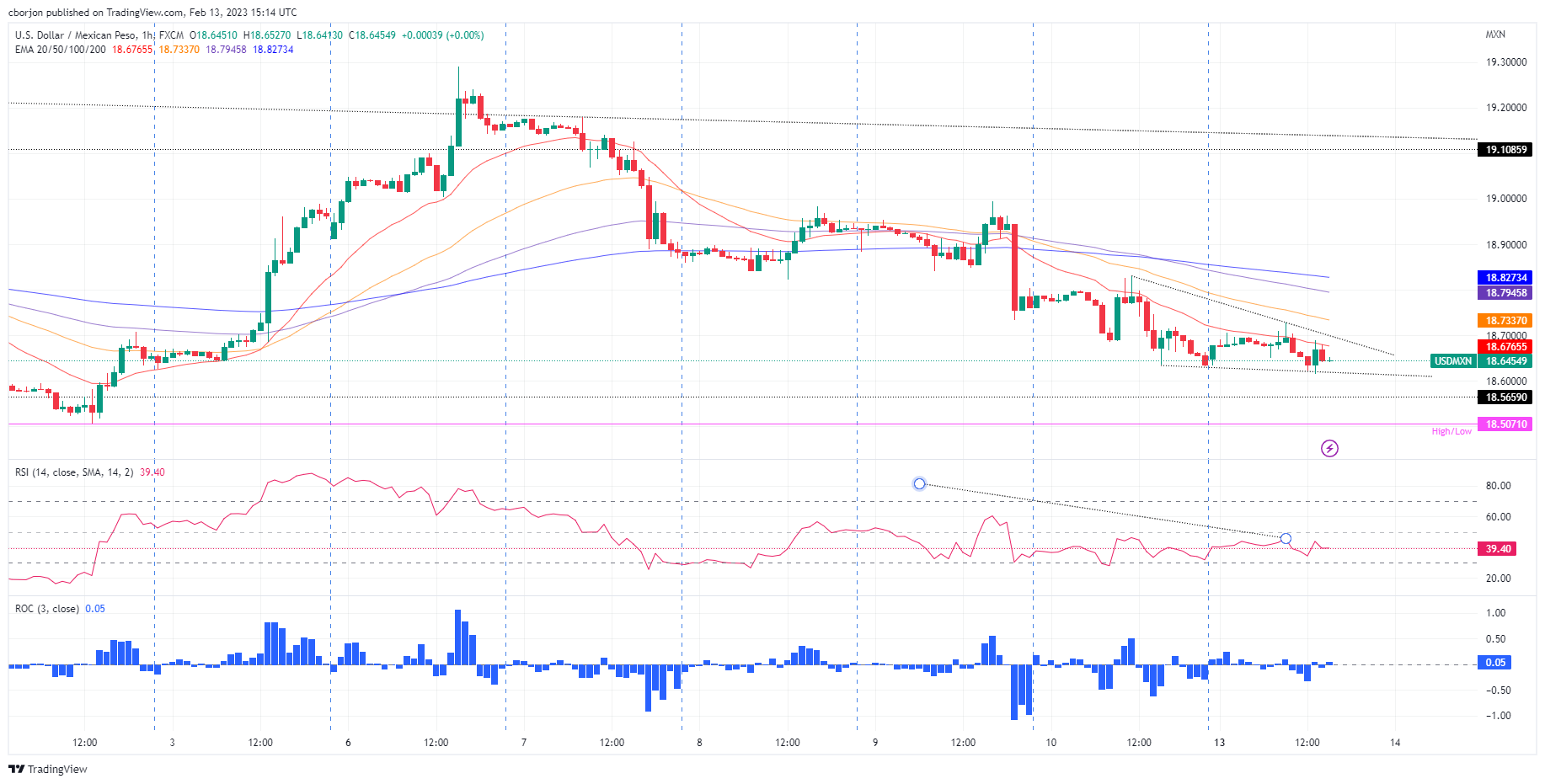
USD/MXN Key technical levels
Seasonal bias favouring the US Dollar has not been in evidence in 2023 yet, as economists at MUFG Bank note.
Balance of risks for the Dollar is shifting
“Momentum is turning more USD positive, most of all versus GBP and next for EUR.”
“It might not take much from here for investors to starting considering the risk of the US terminal rate ending higher than the level currently flagged by the FOMC (5.00%-5.25%) and any disappointment tomorrow after months of good inflation news could trigger an outsized move in rates and a further rebound for the Dollar. That seems the greater risk following the jobs report.”
“Don’t forget the seasonal bias favouring the Dollar at this time of the year too – January and February is one of the two best periods for the greenback throughout the year and we haven’t seen much of that since the start of the year.”
The UK is the only G7 economy with output below its pre-pandemic level. Economists at Rabobank expect the British Pound to remain under downward pressure over the coming months.
UK is the only G7 economy not to have recovered its pre-pandemic levels
“Currently, the UK is the only G7 economy not to have recovered its pre-pandemic levels. In addition to weak growth, its fundamentals are characterised by high inflation, low productivity, weak investment growth, post-Brexit trade frictions and a current account deficit.”
“We continue to expect EUR/GBP to edge to 0.90 by the middle of the year and see scope for further dips below GBP/USD 1.20.”
The rally in the S&P 500 finally stalled at 4195 following the strong payroll report and a setback is underway. The index is expected to see further near-term consolidation but with weakness still viewed as corrective for now, in the opinion of analysts at Credit Suisse.
S&P 500 to see an eventual test of 4312/26
“With daily MACD threatening to cross lower, we see scope for further near-term weakness, but our bias, for now at least, remains to view this as a temporary pullback.”
“Support is seen next at the 38.2% retracement of the rally from the late December low at 4031 and then more importantly at the back of the broken medium-term downtrend and price support at 4016/09, with better buyers expected to show here. We suspect we need to see a move below 3886 to make the argument that we may have seen a more important peak.”
“Resistance is seen at 4112/15 initially, with a move above 4154/56 needed to clear the way for a retest of 4195/4203. An eventual break above here should see a test of the 61.8% retracement of the 2022 fall and summer 2022 high at 4312/26.”
Federal Reserve (Fed) Governor Michelle Bowman said on Monday that they still see a very strong labor market but added that there isn't much moderation in inflation as they would like, as reported by Reuters.
"It is possible we will still be able to achieve a soft landing," Borman added and said that she expects the Fed will continue to raise interest rates, pointing out there will be a lot of data releases between now and the next policy meeting.
Market reaction
These comments don't seem to be having a significant impact on the US Dollar's performance against its major rivals. As of writing, the US Dollar Index was up marginally on the day at 103.65.
Antje Praefcke, FX Analyst at Commerzbank, would not go straight for the first data publication this week even if it might have a Dollar-negative effect in case the result comes in below market expectations.
Do not go straight for the first set of data
“As no important publication is on the agenda for today we are likely to see a quiet trading day. The next heavy-weight is not due until tomorrow in the shape of the US inflation data.”
“Even if inflation was going to ease more significantly than the market expects that does not necessarily mean that the market will immediately switch to a Dollar-negative view again. I think that would require a bigger set of data that illustrates an overall picture of a more pronounced economic slowdown caused by the past rate hikes and might dampen Fed hopes of a soft landing. Only at that stage would it be justified in my view for the market to increasingly rely on the Fed moving in its direction, which would then put pressure on the Dollar.”
“If tomorrow’s inflation data comes in below market expectations, I would expect a short dip in the Dollar but I would be cautious about expecting this to continue all week.”
- USD/CAD quickly reverses an intraday dip to over a one-week low.
- Sliding crude oil prices undermines the Loonie and acts as a tailwind.
- Hawkish Fed expectations limit the USD downside and lend support.
The USD/CAD pair recovers a few pips from over a one-week low touched during the early North American session and is currently placed around the 1.3350-1.3355 area, up less than 0.10% for the day.
A modest downtick in the US Treasury bond yields, along with an intraday turnaround in the equity markets, prompt some selling around the safe-haven US Dollar and exerts pressure on the USD/CAD pair. That said, a combination of factors helps limit any further losses and assists spot prices to attract some buyers near the 1.3325 region.
Crude oil prices once again fail near a technically significant 200-day SMA and kick off the new week on a weaker note. This, in turn, is seen undermining the commodity-linked Loonie. Apart from this, the prospects for further policy tightening by the Fed act as a tailwind for the greenback and contributes to limiting losses for the USD/CAD pair.
Investors seem convinced that the US central bank will stick to its hawkish stance and the bets were fueled by the risk of higher US inflation print for January. Hence, the focus will remain glued to the crucial US CPI report, due for release on Tuesday, which will influence the Fed's rate-hike path and drive the USD demand in the near term.
Ahead of the key data risk, the US bond yields and the broader risk sentiment will play a key role in influencing the greenback in the absence of any relevant market-moving economic data. Apart from this, traders will take cues from oil price dynamics to grab short-term opportunities around the USD/CAD pair.
Technical levels to watch
- GBP/USD rebounds swiftly from a multi-day low touched earlier this Monday.
- A recovery in the risk sentiment undermines the USD and offers some support.
- Hawkish Fed expectations could help limit the USD downside and cap the pair.
The GBP/USD pair builds on its goodish intraday bounce from the 1.2030 area, or a multi-day low touched earlier this Monday and scales higher through the mid-European session. Spot prices climb back above the 1.2100 mark in the last hour and reverse a major part of Friday's downfall amid the emergence of some US Dollar selling.
A modest recovery in the global risk sentiment - as depicted by a turnaround in the equity markets - exerts some downward pressure on the safe-haven buck. Apart from this, a softer tone around the US Treasury bond yields further undermines the Greenback, which, in turn, is seen as a key factor lending some support to the GBP/USD pair.
That said, rising bets for further policy tightening by the Federal Reserve (Fed) should help limit the downside for the USD and cap gains for the GBP/USD pair. Investors now seem convinced that the US central bank will stick to its hawkish stance for longer amid the risk of higher inflation print for January, due for release on Tuesday.
The speculations were fueled by the revision of the previous month's data, which showed that consumer prices rose in December instead of falling as estimated previously. Furthermore, the University of Michigan survey's one-year inflation expectations climbed to 4.2% this month from 3.9% in January. This, in turn, favours the USD bulls.
Apart from this, a dovish assessment of the Bank of England (BoE) decision last week warrants some caution before placing aggressive bullish bets around the GBP/USD pair. In the absence of any relevant market-moving economic releases, traders now look to Fed Governor Michelle Bowman's speech for some impetus ahead of the UK jobs data on Tuesday.
Technical levels to watch
USD/CAD holds last week’s losses to the mid-1.33s. The pair needs to crack 1.3295 to see further falls, economists at Scotiabank report.
Resistances align at 1.3380/90, then 1.3420
“USD/CAD closed net lower on the day Friday, forming a bearish outside range day. That should see spot put a little pressure on the downside in the next day or so but whether losses can extend to test trend support at 1.3295 remains to be seen.”
“The prior week’s price action was USD-bullish (weekly outside range) which rather means that the CAD will have to better the early Feb low at 1.3262 to rally more sustainably.”
“We spot minor resistance at 1.3380/90 intraday ahead of 1.3420.”
The EUR is trading flat against the USD. Economists at Scotiabank expect the EUR/USD to head lower towards the 1.05/06 region.
EU revises up GDP for 2023
“The EU revised its growth outlook to 0.9% this year (from 0.3%), which puts the Eurozone more or less in line with North American rates of growth.”
“Weakness below support in the low 1.07s last week weakened the EUR’s short-term technical picture at least. But weekly price action turned less supportive at the start of the month and EUR losses below the 55-day MA (now resistance at 1.0690) keep the near-term focus on the downside and towards a retest of the 1.05/1.06 range.”
The S&P 500 dropped back below the 4,100 level, which served as resistance back in September and twice in December. Economists at Charles Schwab expect the index to move within a 3,800-4,100 range over the next couple of months.
Fairly rich forward P/E of 19 on the S&P 500
“One of the problems which may be making another ‘leg up’ in the S&P 500 is valuation – the forward P/E on the S&P is currently roughly 19 and it doesn't look like the ‘E’ is growing in the near-term to help support a higher multiple.”
“We could be in for a period of sideways trading for the next couple of months in this index, perhaps ~3,800-4,100 (or maybe as high as 4,300, depending on rates/inflation data).”
- Silver attracts some buyers near the 100-day SMA support, though lacks follow-through.
- The setup favours bearish traders and supports prospects for a further depreciating move.
- A sustained move beyond the $23.00 mark is needed to negate the near-term bearish bias.
Silver manages to defend the 100-day SMA support and stage a modest bounce from its lowest level since late November, around the $21.80 region touched earlier this Monday. The white metal, however, lacks any follow-through buying and struggles to capitalize on the recovery move beyond the $22.00 mark.
From a technical perspective, last week's break and acceptance below the 38.2% Fibonacci retracement level of the recent rally from October 2022 favours bearish traders. Furthermore, oscillators on the daily chart are holding deep in the negative territory and are still far from being in the oversold zone. This, in turn, supports prospects for an extension of the recent sharp pullback from the $24.65 area, or over a nine-month high touched on February 2.
Some follow-through selling below the 100-day SMA, currently around the $21.75 region, will reaffirm the near-term bearish outlook. The XAG/USD would then turn vulnerable to test to the 50% Fibo. level, around the $21.35 area. The downward trajectory could get extended further towards the $21.00 level en route to the 61.8% Fibo. level, around the $20.60-$20.55 zone. The commodity could eventually drop towards challenging the $20.00 psychological mark.
On the flip side, any meaningful recovery beyond the $22.15 area - the 38.2% Fibo. support breakpoint - is more likely to attract fresh sellers near the $22.60-$22.70 supply zone. This, in turn, should cap the XAG/USD near the $23.00 mark, representing the 23.6% Fibo. That said, a convincing break through the latter could offset the negative outlook and shift the near-term bias in favour of bullish traders, paving the way to reclaim the $24.00 round figure.
Silver daily chart
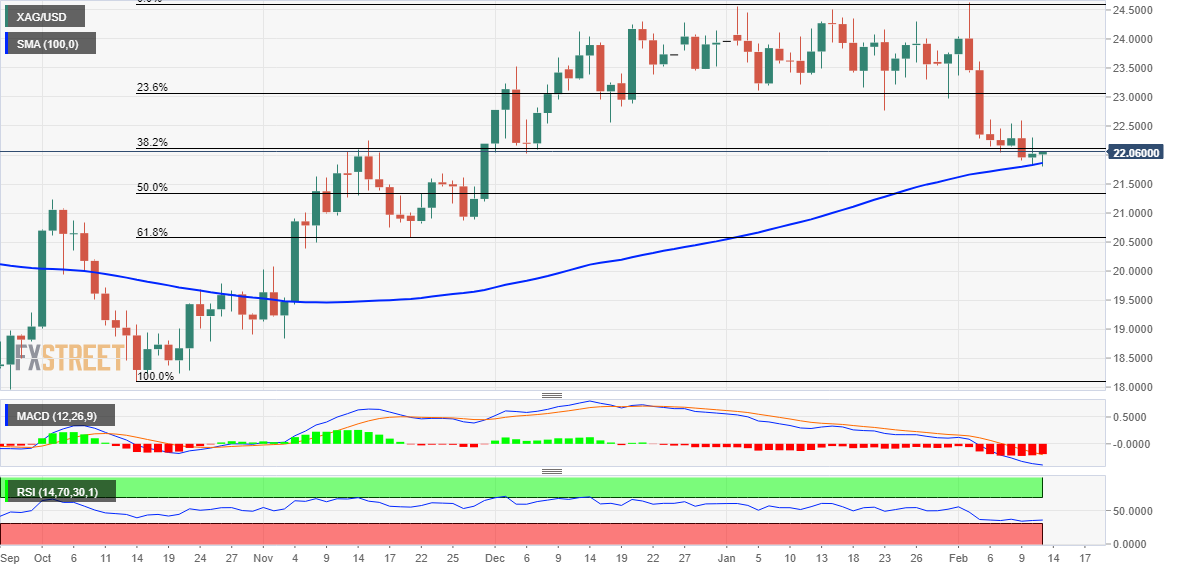
Key levels to watch
The British Pound has started the week on a softer footing. Economists at OCBC Bank expect the GBP/USD pair to trade within a range of 1.1950-1.2180 for the time being.
Sideways trade likely
“Support here at 1.1950 (200-Day Moving Average, 23.6% fibo retracement of 2022 low to high), 1.1850 (100-DMA).”
“Resistance at 1.2190 (50-DMA), 1.2260 (21-DMA) and 1.2450 levels (double top).”
“Sideways trade still likely. Range of 1.1950-1.2180 within a wider range of 1.1850-1.2250.”
See: EUR/USD to rise to 1.10 by Q2 – Deutsche Bank
Following Friday's volatile action, USD/JPY gathered bullish momentum early Monday. But with Yield-Curve-Control still set to end, upward pressure on the Yen will remain, in the opinion of economists at MUFG Bank.
YCC is still set to end
“The prospect of higher JGB yields appears to us to be at least partially priced into the FX markets and the choice of Ueda as Governor, if confirmed, will not change that expectation, and there is a risk that it strengthens the expectations further. But we do not see the choice of Ueda as necessarily hugely different to Amamiya, in terms of the course of monetary policy this year.”
“Our bias was for the Yen to strengthen and that remains the case.”
“We still believe YCC is likely to end and we see Ueda as a credible alternative to Amamiya who will adopt changes to monetary policy with credibility given his time at the BoJ preceded Abenomics.”
EUR/USD lost over 100 pips last week and stays in a consolidation phase below 1.0700 on Monday. Economists at OCBC Bank note that the pair remains under bearish pressure.
Initial support aligns at 1.0660
“Bearish momentum on daily chart intact while RSI fell. Downside risks remain.”
“Support at 1.0660, 1.0610 and 1.0490 levels.”
“Resistance at 1.0680 (23.6% fibo retracement of September low to February high), 1.0760 and 1.0830 (21 DMA).”
See: EUR/USD could test the 1.0500 support on a strong US CPI read – ING
The US Dollar has started the week on a firmer tone after closing higher for a second consecutive week. Tomorrow’s US Consumer Price Index (CPI) data should offer some guidance on USD direction in the near term, economists at OCBC Bank report.
Risks modestly skewed to the upside for now
“If disinflation trend in US shows signs of slowing (even if it is temporary), then risk sentiment could come under pressure and the USD may find further support. However, if disinflation trend proves entrenched instead of bumpy (i.e. CPI comes in softer than expected), then a resumption of USD softness could return.”
“Daily momentum is bullish while RSI shows signs of resuming its rise. Risks modestly skewed to the upside for now.”
“Resistance here at 103.60 (50 DMA), 104.10 (23.6% fibo retracement September peak to February low) and 105.”
“Support at 102.50 (21 DMA), 101.60 and 100.80.”
The reopening in China has continued to support AUD in early 2022, but relative rates have been a headwind. Economists at Danske Bank expect the AUD/USD pair to move gradually lower over the coming months.
AUD is well positioned to gain support from Chinese reopening
“We still think AUD is well positioned to gain support from Chinese reopening and the less negative global growth outlook.”
“Higher commodity prices are supportive for AUD all else equal, but they also increase the risk of the Fed turning more hawkish.”
“We continue to look for modestly lower AUD/USD in 12M in line with our view of broad USD strength, but AUD could still gain vis-à-vis other cyclically sensitive currencies, like EUR.”
“Forecast: 0.69 (1M), 0.68 (3M), 0.67 (6M), 0.67 (12M).”
- EUR/USD remains depresed near a one-month low amid a modest USD strength.
- Hawkish Fed expectations and looming recession risks underpin the greenback.
- Bets for additional jumbo rate hikes by the ECB help limit losses for the major.
The EUR/USD pair consolidates its recent downfall to over a one-month low and oscillates in a narrow range through the first half of the European session on Monday. The pair is currently placed around the 1.0675-1.0680 region and seems vulnerable to prolonging its sharp retracement from the highest level since April 2022 touched earlier this month.
The US Dollar stands tall near a five-week high amid the prospects for further policy tightening by the Fed and turns out to be a key factor acting as a headwind for the EUR/USD pair. In fact, a slew of FOMC members, including Fed Chair Jerome Powell, stressed the need for additional interest rate hikes this week to fully gain control of inflation. The bets were reaffirmed by the Labor Department's annual revisions of CPI, which showed that consumer prices rose in December instead of falling as previously estimated.
Furthermore, the University of Michigan survey's one-year inflation expectations climbed to 4.2% this month from the 3.9% previous. This raises the risk of higher inflation print for January and dashes hopes for an imminent pause in the Fed's rate-hiking cycle. This, along with the prevalent cautious market mood and looming recession risks, continues to lend support to the safe-haven buck. Apart from this, signs of easing inflationary pressure in the Eurozone undermine the Euro and keep a lid on the EUR/USD pair.
That said, bets for additional jumbo rate hikes from the European Central Bank (ECB) in the coming month lend some support to the shared currency. Traders also seem reluctant to place aggressive bets ahead of the crucial US CPI report on Tuesday, which further contributes to limiting the downside for the EUR/USD pair, at least for now. Nevertheless, Friday's breakdown below the 50-day SMA could be seen as a fresh trigger for bearish traders and supports prospects for an extension of the near-term depreciating move.
Technical levels to watch
In the midst of the Dollar's upward correction, the Euro has also lost its idiosyncratic bullish momentum. Economists at ING expect the EUR/USD to test 1.05 support on a strong US Consumer Price Index (CPI) report.
Lacking the domestic push
“Our medium-term view is still one of EUR/USD appreciation over the course of 2023, but we don’t see clear drivers for a EUR/USD rebound this week, especially from the eurozone side.”
“It would probably require a rather low US CPI figure to send the pair sustainably back above 1.0800-1.0850. We see a greater chance of the pair coming under some additional pressure, and a strong US CPI read could mean the 1.0500 support (1.0490 is the 2023 low) is tested.”
“President Christine Lagarde will speak on Wednesday: expect another attempt to build market expectations around more tightening, although other ECB members have already gone a long way communication-wise and we don’t see her speech as a big risk event for the Euro.”
Economists at ANZ Bank expect the US Dollar to remain resilient ahead of the US Consumer Price Index (CPI) report tomorrow. However, the greenback could see some selling pressure following the release.
USD to be supported at the current range around 103
“January US CPI is the key event for the DXY, with Core Services Excluding Housing in focus. On a YoY basis, we expect January core CPI would result in core easing to 5.4% from 5.7% and headline to 6.2% from 6.5%.”
"Based on our forecasts of a slight decline in YoY figures, some easing in USD strength could be expected following the release.”
“Ahead of CPI, we expect the USD to be supported at the current range around 103.”
- NZD/USD rebounds over 50 pips from the daily low amid the emergence of some USD selling.
- A modest recovery in the risk sentiment weighs the buck and benefits the risk-sensitive Kiwi.
- Hawkish Fed expectations, recession fears should limit the USD downside and cap the major.
The NZD/USD pair attracts some buyers near the 0.6290 area on Monday and climbs to a fresh daily high during the first half of the European session. The pair is currently placed just below mid-0.6300s, though remains well within a familiar trading band held over the past week or so.
The US Dollar fails to capitalise on its modest intraday gains and turns out to be a key factor lending some support to the NZD/USD pair. A softer tone surrounding the US Treasury bond yields acts as a headwind for the greenback. Apart from this, an intraday recovery in the US equity markets further undermines the safe-haven buck and benefits the risk-sensitive Kiwi.
That said, worries about a deeper global economic downturn should keep a lid on any optimism in the markets. Apart from this, the prospects for further policy tightening by the Fed could help limit any meaningful downside for the USD and cap the upside for the NZD/USD pair. This, in turn, warrants some caution for bulls and before positioning for further gains.
Investors now seem convinced that the Fed will stick to its hawkish stance. The bets were reaffirmed by the Labor Department's annual revisions of CPI, which showed that consumer prices rose in December instead of falling as previously estimated. Separately, the University of Michigan survey's one-year inflation expectations climbed to 4.2% in February from the 3.9% previous.
This raises the risk of higher inflation print for January and dashes hopes for an imminent pause in the Fed's rate-hiking cycle. Hence, the market focus will remain glued to the crucial US CPI report on Tuesday. Heading into the key data risk, traders might refrain from placing aggressive bets around the NZD/USD pair in the absence of relevant economic data on Monday.
Technical levels to watch
Ulrich Leuchtmann, Head of FX and Commodity Research at Commerzbank, expects JPY volatility to persist as uncertainty about the BoJ's stance is set to diminish gradually at best.
Clarity is unlikely to arrive overnight
“Even once the new BoJ governor has taken office, clarity is unlikely to arrive overnight. No experienced central banker would announce a 180° turnaround in monetary policy or any other significant strategy setting in one fell swoop. The reaction of currency markets and bond markets could be too disruptive. We should, I think, expect uncertainty about the BoJ's stance to diminish gradually at best.”
“I consider the market's opinion expressed in the implied USD/JPY volatilities to be questionable. That in the very near future the direction of monetary policy will become clear (and thus generate high JPY volatility), but after that everything will be clear (and thus JPY volatility will decrease again), is in my view an over-optimistic assessment.”
In its quarterly publication released on Monday, the European Commission revised upwards its economic growth forecast for the Eurozone to 0.9% in 2023 from 0.3% previously, projecting 2024 growth unchanged at 1.5%.
Additional takeaways
Eurozone to avoid earlier exepcted technical recession with 0.1% QoQ growth in Q4 2022 and 0.0% QoQ in Q1 2023
Uncertainty surrounding the forecast was high, but risks to growth were broadly balanced.
Domestic demand could turn out higher than projected if the recent declines in wholesale gas prices pass through to consumer prices more strongly and consumption proves more resilient.
Nonetheless, a potential reversal of that fall cannot be ruled out in the context of continued geopolitical tensions.
EU Commission lowers its Eurozone inflation forecast for 2023 to 5.6% YoY from 6.1% expected earlier, sees inflation of 2.5% in 2024, down from the previous forecast of 2.6%.
This forecast crucially hinges on the purely technical assumption that Russia's aggression of Ukraine will not escalate but will continue throughout the forecast horizon.
The German economy will grow slightly this year, revising upwards its previous forecast for a 0.6% contraction. Growth is expected to rebound to 1.3% in 2024.
Market reaction
The quarterly forecasts failed to have any material impact on the Euro, as EUR/USD continues to trade around 1.0675, flat on the day.
AUD/USD was net almost unchanged last week around 0.69. This week's crowded calendar includes US Consumer Price Index (CPI) report, which could spark USD volatility, economists at Westpac report.
Initial AUD/USD support lies around 0.6850/60
“AUD/USD’s sharpest movement of the week could well occur in response to the US inflation report on Tuesday.
“Any deviation from the median forecast of 6.2%yr overall, 5.5%yr ex-food and energy seems likely to spark significant US Dollar movement.”
“Ahead of the CPI, initial AUD/USD support lies around 0.6850/60, resistance around 0.7080.”
- GBP/USD remains on the defensive for the second successive day amid modest USD strength.
- Hawkish Fed expectations and the prevalent risk-off mood continue to underpin the greenback.
- Expectations that the BoE rate-hiking cycle is nearing the end further seem to weigh on the GBP.
- Traders await this week’s key macro data from the UK and the US for a fresh directional impetus.
The GBP/USD pair edges lower for the second straight day on Monday and remains on the defensive through the first half of the European session. The pair is currently placed near the mid-1.2000s, just a few pips above the daily low, and seems vulnerable to extending last week's retracement slide from the vicinity of the 1.2200 mark.
A combination of supporting factors assists the US Dollar to reverse a modest intraday slide and hold steady near a one-high, which, in turn, is seen weighing on the GBP/USD pair. A more hawkish commentary by several FOMC members, including Fed Chair Jerome Powell, back the case for further policy tightening by the US central bank. This, along with the prevalent risk-off environment amid looming recession risks, continue to act as a tailwind for the safe-haven greenback.
In fact, investors now seem convinced that the Fed will stick to its hawkish stance and the bets were reaffirmed by the incoming US macro data. Against the backdrop of a blockbuster US monthly jobs report, the Labor Department's annual revisions of CPI on Friday showed that consumer prices rose in December instead of falling as previously estimated. Separately, the University of Michigan survey's one-year inflation expectations climbed to 4.2% this month from the 3.9% previous.
This raises the risk of higher inflation print for January and dashes hopes for an imminent pause in the Fed's rate-hiking cycle. In contrast, the Bank of England (BoE) is becoming increasingly unsure as to whether further policy tightening is warranted. It is worth recalling that BoE said that inflation will fall more rapidly during the second half of 2023. Moreover, the UK central bank, in its monetary policy statement, removed the phrase that they would "respond forcefully, as necessary".
The aforementioned fundamental backdrop suggests that the path of least resistance for the GBP/USD pair is to the downside. That said, traders might refrain from placing aggressive bets ahead of this week's key macro releases from the UK and the US. The UK monthly jobs report is due on Tuesday, which will be followed by the US CPI report. The focus will then shift to the UK CPI report, along with the US Retail Sales data, on Wednesday and the US Producer Price Index (PPI) on Thursday.
In the meantime, the USD price dynamics will continue to play a key role in influencing the GBP/USD pair and allow traders to grab short-term opportunities. Later during the early North American session, traders will take cues from a scheduled speech by Fed Governor Michelle Bowman. Apart from this, the broader risk sentiment should drive the USD demand and provide some impetus to the major.
Technical levels to watch
European Central Bank (ECB) policymaker Mario Centeno made some comments on the inflation and monetary policy outlook, in his speech on Monday.
Key quotes
Inflation is going down faster than we expected.
Smaller hikes would need mid-term inflation nearing 2%.
March forecasts will help determine peak rate.
Forecasts are likely to show a faster drop in inflation.
Economy and labor market are showing resilience.
Market reaction
The latest ECB commentary is having little to no impact on the EUR/USD pair, as it keeps its downside consolidative phase intact at around 1.0675.
In an interview with The Overshoot, Bank of England (BoE) policymaker Jonathan Haskel said on Monday, “I would prefer to make policy with much more attention on the data flow over the next few months.”
Additional comments
“What we’ve seen in the UK. is a very US-style labor market in the last 40-odd years.”
“We have downgraded our forecast of structural output growth. Around 2015-2018 we just decided that we had had ~2% productivity growth, pre-GFC and ~1% productivity growth post-GFC. Then there’s the vexed question of Brexit. More recently, the decline has been an hours effect, because of the rise in inactivity.”
“It is true that when we raise rates that is not good for investment. I absolutely accept that, and therefore we are potentially contributing to that very poor capital investment.”
Market reaction
At the time of writing, GBP/USD is losing 0.10% on the day, trading at 1.0245. The pair is unperturbed by the above comments.
US Dollar Index (DXY) clings to small daily gains. Economists at ING expect DXY to return to the 105 level soon.
Balance of risks appears skewed to the upside for the USD today
“The Dollar appears in a position to at least hang on to recent gains this week.”
“We could see a return to 105.00 in DXY soon.”
“Today’s price action may follow a wait-and-see approach given there are no data releases, but we have observed a tendency of markets to move closer to defensive long-Dollar positions into key risk events.”
“The balance of risks appears skewed to the upside for the Dollar today.”
European Central Bank (ECB) Vice-President Luis de Guindos said on Monday, “rate increases beyond March are to depend on data.”
“The ECB are a bit more positive on the economic outlook,” de Guindos added.
EUR/GBP is trading around the mid-0.8800s. Economists at ING believe that the pair could extend its slide toward 0.8800 but continue to see Euro outperformance in the second quarter of the year.
Running out of reasons to stay bearish on EUR/GBP for longer
“The EUR/GBP drop could extend to 0.8800 but we think markets are running out of reasons to stay bearish on the pair for longer.”
“We continue to see Euro outperformance from the second quarter and 0.9000 is our target level in EUR/GBP in the second half of 2023.”
- AUD/USD reverses an intraday dip to sub-0.6900 levels amid a modest USD downtick.
- Hawkish Fed expectations to limit the USD fall and cap the pair amid the risk-off mood.
- Traders might also prefer to wait for the release of the crucial US CPI report on Tuesday.
The AUD/USD pair attracts some buyers near the 0.6890 area and recovers around 40 pips from a four-day low touched earlier this Monday. Spot prices climb to the 0.6930 area, or a fresh daily top during the early European session and for now, seems to have stalled last week's pullback from levels just above the 0.7000 psychological mark.
The US Dollar struggles to capitalize on its intraday gains amid a modest downtick in the US Treasury bond yields and turns out to be a key factor lending some support to the AUD/USD pair. That said, the prospects for further policy tightening by the Fed should help limit the downside for the USD. This, along with the prevalent risk-off environment, warrants caution before positioning for any meaningful upside for the risk-sensitive Aussie.
Several FOMC members, including Fed Chair Jerome Powell, last week stressed the need for additional interest rate hikes to fully gain control of inflation. The bets were boosted by the Labor Department's annual revisions of CPI data on Friday, which showed that consumer prices rose in December instead of falling as previously estimated. Furthermore, the University of Michigan survey's one-year inflation expectations climbed to 4.2% for February.
This raises the risk of higher inflation print for January and reaffirms expectations that the Fed will stick to its hawkish stance. This, in turn, might hold back traders from placing bearish bets around the USD ahead of the latest US consumer inflation figures, due for release on Tuesday. This, in turn, suggests that the path of least resistance for the AUD/USD pair is to the downside and any subsequent move up might still be seen as a selling opportunity.
There isn't any major market-moving economic data due for release from the US on Monday, leaving the USD at the mercy of the US bond yields. Traders will further take cues from Fed Governor Michelle Bowman's scheduled speech later during the early North American session. This, along with the broader risk sentiment, could influence the USD price dynamics and contribute to producing short-term trading opportunities around the AUD/USD pair.
Technical levels to watch
Economists at Deutsche Bank expect the EUR/USD and GBP/USD pairs to climb towards 1.10 and 1.25 by Q2, respectively.
USD to be on a sustained downward trend from here onwards
“The USD has further weakened since the start of 2023, and we expect it to be on a sustained downward trend from here onwards.”
“There is scope for the EUR/USD to catch-up to favourable energy and monetary policy developments and reach 1.10 by Q2.”
“Cable appears cheap and the high-beta cross should benefit from the more
supportive risk backdrop in H1. We forecast GBP/USD at 1.25 by Q2.”
- Gold price oscillates in a narrow range just above a one-month low and 50-day SMA support.
- Bets for additional rate hikes by the Federal Reserve act as a headwind for the yellow metal.
- A stronger US Dollar contributes to capping the XAU/USD, though recession fears limit losses.
Gold price extends its consolidative price move through the early European session on Monday and is currently placed around the $1,865 region. The XAU/USD manages to hold above the 50-day Simple Moving Average (SMA) support, though remains well within the striking distance of over a one-month low touched on Friday.
Hawkish Federal Reserve acts as a headwind for Gold price
The prospects for further policy tightening by the Federal Reserve (Fed) continue to underpin the US Dollar and act as a headwind for the non-yielding Gold price. In fact, a slew of Federal Open Market Committee (FOMC) policymakers, including Fed Chair Jerome Powell, last week stressed the need for additional interest rate hikes to fully gain control of inflation.
Moreover, the Labor Department's annual revisions of the Consumer Price Index (CPI) showed on Friday that consumer prices rose in December instead of falling as previously estimated. Adding to this, the University of Michigan survey's one-year inflation expectations climbed to 4.2% this month from the 3.9% previous and reaffirmed expectations for a more hawkish Fed.
Recession fears lend support to safe-haven XAU/USD
This, in turn, assists the USD to stand tall near a one-month high, which is seen as another factor that contributes to capping the upside for the US Dollar-denominated Gold price. That said, the prevalent risk-off environment - amid looming recession risks - lends some support to the safe-haven precious metal and helps limit the downside, at least for the time being.
Focus remains on consumer inflation figures from United States
Apart from this, the risk of higher inflation print for January lends support to the Gold price, which is considered a hedge against rising inflation. Hence, the market focus remains glued to the crucial CPI report from the United States (US), due for release on Tuesday. The data could influence the Fed's rate-hike path and determine the near-term trajectory for the XAU/USD.
Gold price technical outlook
From a technical perspective, a sustained break and acceptance below the 50-day SMA, currently around the $1,856 region, will be seen as a fresh trigger for bearish traders. The gold price might then accelerate the fall towards The XAU/USD could then accelerate the fall towards the next relevant support near the $1,830 area en route to the $1,818-$1,817 zone and the $1,800 round figure.
On the flip side, any subsequent move up is likely to confront stiff resistance near the $1,875 region. This is followed by the $1,900 round-figure mark. The latter should act as a pivotal point, above which a bout of a short-covering could lift the Gold price to the $1,925-$1,930 congestion zone.
Key levels to watch
Here is what you need to know on Monday, February 13:
Markets remain risk-averse early Monday as investors keep an eye on geopolitics while refraining from taking large positions ahead of this week's key events. In the absence of high-tier data releases, risk perception should continue to drive the market action in the remainder of the day.
On Friday, the data published by the University of Michigan revealed that the year-ahead inflation expectation component of the Consumer Sentiment Survey rose to 4.2% in early February from 3.9% in January. This data helped the US Dollar preserve its strength against its rivals late Friday and the US Dollar Index (DXY) closed the second straight week in positive territory. In the European morning, DXY clings to small daily gains near 103.70 and the benchmark 10-year US Treasury bond yield holds steady above 3.7%. Reflecting the cautious mood, US stock index futures are down between 0.25% and 0.35%.
Meanwhile, the US military reportedly shot down an unidentified object, the third one since the downing of the Chinese balloon, flying above Michigan on Sunday.
EUR/USD lost over 100 pips last week and stays in a consolidation phase below 1.0700 on Monday. On Tuesday, Eurostat will publish the Employment Change and Gross Domestic Product data for the fourth quarter.
Following last week's sharp decline, GBP/USD moves sideways at around 1.2050 to start the week.
AUD/USD holds steady slightly above 0.6900. In the early trading hours of the Asian session on Tuesday, National Australia Bank's Business Confidence data will be watched upon for fresh impetus alongside Westpac Consumer Confidence Index.
Despite the broad-based US Dollar strength, USD/CAD fell over 100 pips on Friday. The monthly data published by Statistics Canada showed that Net Change Employment was up 150,000 in January, compared to the market expectation of 15,000, and provided a boost to the Canadian Dollar.
Following Friday's volatile action, USD/JPY gathered bullish momentum early Monday and was last seen trading near 132.20, where it was up more than 0.5% on a daily basis. Reuters reported on Monday that Japan's Upper House of Parliament has scheduled confirmation hearings on government nominees for the new Bank of Japan (BoJ) governor and his two deputies on February 27. Markets widely expect the Japanese government to formally nominate Kazuo Ueda on Tuesday, February 14.
Pressured by rising US Treasury bond yields, Gold price stayed on the back foot ahead of the weekend and failed to stage a rebound. In the early European morning, XAU/USD fluctuates in a tight range slightly above $1,860.
Bitcoin stayed relatively quiet over the weekend but ended the second straight week in negative territory, losing around 5%. BTC/USD trades up and down in a narrow channel below $22,000 early Monday. Ethereum stays in a consolidation phase and trades at around $1,500.
- EUR/GBP fades bounce off monthly support, grinds near intraday high of late.
- Sustained trading beyond 200-SMA, looming bull cross on MACD favor buyers.
- Weekly resistance line guards immediate upside ahead of monthly high.
EUR/GBP grinds near an intraday high surrounding 0.8850 during the initial hours of Monday morning in London. In doing so, the cross-currency pair stays above the 200-Simple Moving Average (SMA) despite fading bounce off the monthly support line.
It’s worth noting that the impending bull cross on the MACD and steady RSI (14) joins the quote’s successful trading above the key moving average to keep buyers hopeful.
That said, a one-week-old descending trend line restricts the EUR/GBP pair’s immediate upside to near 0.8870.
Following that, the 0.8900 round figure and multiple hurdles near 0.8910 could act as the last defense of the pair buyers before directing the quote toward the monthly high of near 0.8980.
It should be observed that the EUR/GBP run-up beyond 0.8990 will need validation from the 0.9000 psychological magnet to aim for the previous yearly high surrounding 0.9250.
On the contrary, the 200-SMA and an ascending trend line from January 19, close to 0.8835 and 0.8828 in that order, restrict the short-term downside of the EUR/GBP pair.
Following that the 61.8% Fibonacci retracement level of the pair’s January-February upside and the late January swing low, respectively near 0.8820 and 0.8760, will be in focus.
Overall, EUR/GBP is likely to remain firmer unless offering clear trading below 0.8828.
EUR/GBP: Four-hour chart
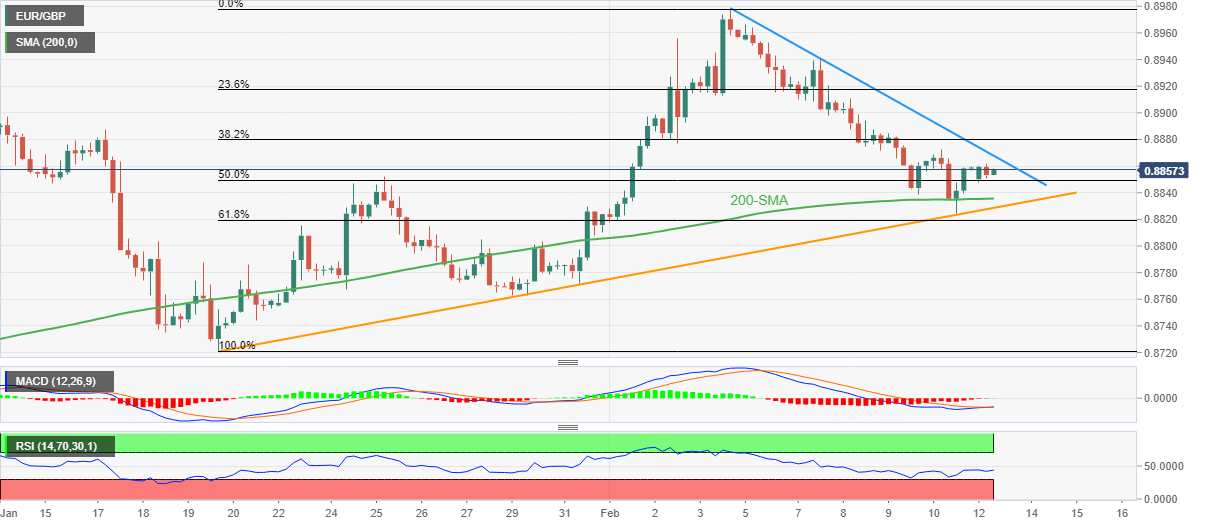
Trend: Further upside expected
Gold price is trading with moderate losses. XAU/USD could target $1,825 if the 50-Daily Moving Average support fails, FXStreet’s Dhwani Mehta reports.
Gold price attacks 50-DMA again
“Gold sellers again took charge on Monday, attacking the 50DMA, now at $1,857. Daily closing below the latter is needed to extend the downside break from the bearish continuation pattern toward the $1,850 psychological level.”
“A fresh sell-off toward the January 5 low of $1,825 could be in the offing on a sustained break below the $1,850 demand area.”
“Should Gold bulls manage to take out the intraday high at $1,866, then a test of the bear flag support-turned-resistance at $1,877 could be in the offing. Acceptance above the latter is critical to initiating a meaningful recovery toward the $1,885 static resistance.”
FX option expiries for Feb 13 NY cut at 10:00 Eastern Time, via DTCC, can be found below.
- EUR/USD: EUR amounts
- 1.0930 842m
- 1.1000 337m
- USD/JPY: USD amounts
- 126.50 700m
- 127.50 426m
- 130.15 426m
- USD/CAD: USD amounts
- 1.3000 644m
- USD/JPY picks up bids to renew intraday high as US Dollar cheers risk-off mood.
- Hopes of doves to keep the BoJ reins weigh on Yen amid sluggish yields.
- Upbeat US inflation expectations, hawkish Fed concerns keep buyers hopeful.
- Japan policymakers verdict on BoJ leader, Japan Q4 GDP and US CPI will be crucial for clear directions.
USD/JPY refreshes intraday high around 132.30 during early Monday in Europe. In doing so, the Yen pair reverses the previous week’s losses amid hopes of an easy money policy to prevail for long. Adding strength to the pair’s upside bias is the US Dollar’s demand amid a risk-off mood and also due to the hawkish bias surrounding the Federal Reserve (Fed), not to forget steady yields.
Talks surrounding Kazuo Ueda’s appointment as the Bank of Japan (BoJ) Governor backed concerns over the ultra-easy monetary policy and favored the USD/JPY bulls afterward.
On the other hand, fears about the mystery objects flying over the US and China underpin the US Dollar’s haven demand and propel the USD/JPY prices. The US shot down nearly four such objects while China prepares to hit one such unidentified object while weighing on the market sentiment and fueling the DXY. That said, the US Dollar Index (DXY), was up 0.20% near 103.80 by the press time.
Elsewhere, the mildly hawkish Fed talks join Friday’s strong US Consumer Sentiment and US inflation expectations to offer extra strength to the USD/JPY prices, via US Dollar strength. During the weekend, Philadelphia Federal Reserve President Patrick Harker pushed back the chatters of a Fed rate cut during 2023. However, the policymaker did mention, “Fed not likely to cut this year but may be able to in 2024 if inflation starts ebbing.” His comments were mostly in line with Fed Chair Jerome Powell’s cautious optimism and hence challenge the US Dollar buyers.
Amid these plays, US stock futures fade the previous day’s corrective bounce while the Treasury bond yields remain sluggish around the multi-day high marked on Friday, which in turn helped the US Dollar Index (DXY) to grind higher after a two-week uptrend.
Moving ahead, the preliminary readings of Japan’s fourth quarter (Q4) Gross Domestic Product, up for publishing on Tuesday, will precede the Japanese policymakers’ official selection of the BoJ leaders to direct short-term USD/JPY moves. Following that, the US Consumer Price Index (CPI) for January will be crucial for short-term Yen pair directions.
Technical analysis
A daily closing beyond the 50-DMA, around 132.20 by the press time, appears necessary for the USD/JPY bulls to keep the reins.
According to economists polled by Bloomberg, Euroa area inflation is still likely to loom above the European Central Bank (ECB) target of 2.0% heading further out in 2025.
Key takeaways
“The headline and underlying measures are both predicted to average 2.1% that year.”
“Core inflation, which excludes volatile items like energy and is currently of particular concern for the ECB, will peak at its current level of 5.2% in the first quarter before easing to 3.6% in the final three months of this year.”
“Respondents see a 0.2% contraction in gross domestic product in the first quarter, followed a rebound. GDP will grow 0.4% in 2023 and 1.2% in 2024.”
- USD/MXN is struggling to extend its recovery move above 18.70 amid the risk-off mood.
- A Reuters poll indicates that the monthly headline CPI and core inflation will escalate by 0.4%.
- Banxico is proving to be an inflation fighter after the departure of Gerardo Esquivel, who was considered a big dove.
The USD/MXN pair is struggling to extend its recovery move above 18.70 in the early European session. The asset attempted a rebound move after refreshing the weekly low at 18.63, however, the recovery move looks less confident as the market sentiment is extremely negative.
Investors have underpinned the risk-aversion theme as airborne threats on the United States have triggered geopolitical tensions. Also, soaring anxiety among investors ahead of the release of the United States inflation data has added to the risk-off impulse. S&P500 futures are continuously adding losses as investors expect that higher inflation will add to the consensus for higher interest rates by the Federal Reserve (Fed).
The US Dollar Index (DXY) has turned sideways after shifting its auction above 103.40 as investors are getting prepared for a fresh upside amid a higher appeal for safe-haven assets. Higher interest rates by the Fed after a surprise rise in inflation will result in more divergence in policy comparison of other economies with the Fed. The alpha provided on 10-year US Treasury yields is holding itself above 3.74% as bets scaled higher for more stubbornness in the US inflation.
A Reuters poll indicates that the monthly headline CPI and core inflation that excludes oil and food prices will escalate by 0.4%. The annual headline CPI is seen lower at 5.8% against the former release of 6.5% while the core inflation that excludes oil and food prices is seen lower at 5.4% versus 5.8% in the former release.
Meanwhile, the hawkish monetary policy by the Bank of Mexico (Banxico) has failed to provide strength to the Mexican Peso. Last week, Banxico hiked interest rates by 50 basis points (bps) to 11%. Analysts at Commerzbank stated their views on the monetary policy “Banxico is proving to be an inflation fighter after the departure of central bank member Gerardo Esquivel, who was considered a big dove, which should in principle help the Peso.”
- USD/CAD consolidates the biggest daily slump in over a month.
- 61.8% Fibonacci retracement triggers corrective bounce amid oversold RSI.
- 200-HMA joins sluggish MACD signals to probe Loonie pair buyers.
USD/CAD retreats from intraday high as buyers struggle to overcome the key Hourly Moving Average (HMA) during early Monday in Europe. Even so, the Loonie pair prints 0.20% intraday gains around 1.3375 as it pares the heaviest daily loss in five weeks, marked the previous day.
The quote’s recovery could be linked to its bounce off the 61.8% Fibonacci retracement level of February 02-06 upside amid the oversold RSI (14) conditions.
However, the 200-HMA level challenges the USD/CAD pair’s immediate upside near 1.3385.
Given the bullish MACD signals, despite being sluggish of late, the Loonie pair may remain on the bull’s radar, suggesting a clear break of the immediate HMA hurdle surrounding 1.3385.
Following that, 1.3415 may test the upside momentum before directing the USD/CAD bulls toward the two-week-old horizontal resistance area near 1.3470.
In a case where USD/CAD remains firmer past 1.3470, it can aim for a late January swing high near 1.3520.
Alternatively, the 61.8% Fibonacci retracement level, also known as the golden Fibonacci ratio, puts a floor under the USD/CAD prices of around 1.3340, a break of which highlights the 1.3300 round figure for the bears.
Should USD/CAD breaks the 1.3300 round figure, the monthly low and November 2022 trough, respectively near 1.3260 and 1.3225, will gain the market’s attention.
USD/CAD: Hourly chart
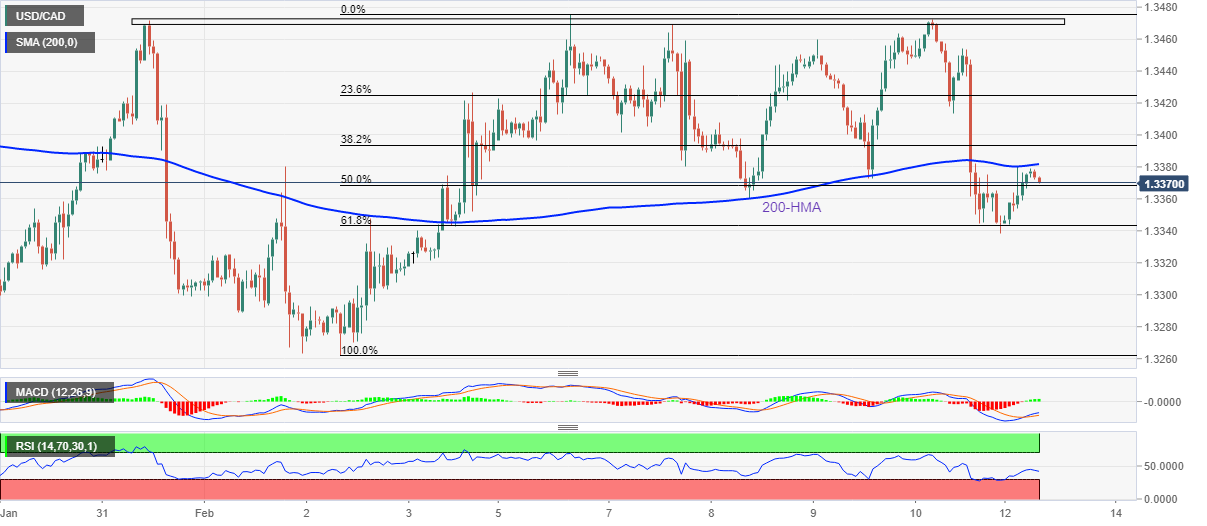
Trend: Further downside expected
- WTI extends pullback from two-week high amid sour sentiment.
- Tensions surrounding unidentified objects, hawkish Fed weigh on commodity prices.
- OPEC expects upbeat energy demand, Russia braces for Oil production cut.
- US inflation data will be crucial for clear directions.
WTI crude oil pares the previous day’s gains around $79.00, down 1.22% intraday during early Monday, as energy buyers fail to ignore the broad risk-off mood. In doing so, the black gold also falls short of cheering the price-positive news from Russia and the Organization of the Petroleum Exporting Countries (OPEC).
Russia will cut crude oil production by half a million barrels per day starting in March, mentioned CNN Business. The news also cites the Western sanctions on Moscow’s energy supply curbs as the catalyst behind the move that propelled Oil prices on Friday.
On the same line, OPEC Secretary-General Haitham Al Ghais said over the weekend at an energy conference in Cairo that the cartel “expects global oil demand to exceed pre-pandemic levels in 2023,” reported Reuters.
While the hopes of higher demand and lesser supplies put a floor under the Oil price, the market’s risk-aversion joins the firmer US Dollar to weigh on the commodity prices. Among the key catalysts fueling the US Dollar Index (DXY), up 0.20% near 103.80 by the press time, are the fears about the mystery objects flying over the US and China. The US shot down nearly four such objects while China prepares to hit one such unidentified object while weighing on the market sentiment and fueling the DXY.
The market’s risk-off joins the mildly positive Fedspeak, especially after Friday’s strong US Consumer Sentiment and inflation expectations, to also weigh on the WTI crude oil. During the weekend, Philadelphia Federal Reserve President Patrick Harker pushed back the chatters of a Fed rate cut during 2023. However, the policymaker did mention, “Fed not likely to cut this year but may be able to in 2024 if inflation starts ebbing.” His comments were mostly in line with Fed Chair Jerome Powell’s cautious optimism and hence challenge the US Dollar buyers.
Looking forward, WTI crude oil may await more clues for clear directions amid a light calendar. Hence, it may extend the latest pullback ahead of Tuesday’s US Consumer Price Index (CPI) for January. Should the US inflation data arrive as firmer, the fears of hawkish Fed actions and economic slowdown weigh on the energy benchmark.
Technical analysis
WTI crude oil remains sidelined between the one-week-old support line and the 100-DMA, respectively near $78.80 and $80.90.
- EUR/USD is expected to deliver more weakness below 1.0660 amid the dismal market mood.
- A surprise upside in the US inflation will strengthen hawkish Fed bets.
- European Central Bank policymakers have been reiterating that Eurozone won’t face a deep recession.
- EUR/USD has shifted its business below the 61.8% Fibo retracement placed below 1.0700.
EUR/USD is looking to build an intermediate cushion around 1.0660 in the early European session. The major currency is not expected to conquer the downside bias as the risk-off impulse is extremely solid amid the airborne threats to the United States and anxiety among the market participants ahead of the US Consumer Price Index (CPI) data, which will release on Tuesday.
After registering the biggest weekly loss since December, S&P500 futures have added further losses amid disappointing results by the US equities, portraying a sheer decline in the risk appetite of investors. The US Dollar Index (DXY) has shifted its business above 103.40 and is expected to add more gains as the weekend airborne threat on the US after the Chinese spy balloon event, which was later identified as a civilian by the Chinese economy, has turned investors risk averse.
Meanwhile, expectations of a higher US inflation rate on Tuesday are continuously strengthening the return generated on the US Treasury bonds. The 10-year US Treasury yields have scaled above 3.74%.
Upbeat labor market and a rebound in used car prices could propel US inflation
The US Inflation is demonstrating a declining trend for the past three months significantly, supported by lower energy and used car prices. From a whooping figure of 9.1%, the headline inflation has already corrected to 6.5% and the current consensus is favoring further decline to 5.8%. And, the core inflation that excludes oil and food prices is seen lower at 5.4% vs. the former release of 5.8%.
A strong labor market in the United States and a rebound in the prices of used cars are expected to propel the employment cost index as the shortage of labor will be offset by higher employment proposals from firms. This could trigger a rebound in the inflation projections as households with higher earnings in possession can lead to higher consumer spending. Bloomberg reported that average used-vehicle prices rose 2.5% in January according to data from Manheim.
Higher inflation rate to favor continuation of policy tightening by the Fed
The street started expecting that the decline in consumer spending and scale of economic activities will result in a pause in the policy tightening spell by the Federal Reserve (Fed). However, renewed concerns of a rebound in inflation projections have faded the policy tightening expectations. Fed chair Jerome Powell has vouched for further interest rate hikes last week as a consideration of tightening relaxations or rate cuts could be premature at the current stage.
Meanwhile, hawkish commentary from Philadelphia Fed President Patrick Harker has infused fresh blood into the US Dollar. Fed Harker reiterated his view that the central bank will continue hiking interest rates to above 5%. The Fed policymaker has favored a small interest rate hike and sees no recession ahead. Also, the expression of a rate cut is unlikely this year.
Eurozone GDP is in focus
After recording signs of softening inflation in the Eurozone, investors are shifting their focus towards the release of the Gross Domestic Product (GDP) (Q4) data, which will release on Tuesday. As per the consensus, the economic data for the quarterly and annual basis are seen similar to its former releases at 0.1% and 1.9% respectively. This indicates that the Eurozone economy has not seen a recession in CY2022. Also, European Central Bank (ECB) policymakers have been reiterating that Eurozone won’t face a deep recession, if it happens it would be shallow as the labor market is extremely solid.
EUR/USD technical outlook

EUR/USD has shifted its auction profile below the 61.8% Fibonacci retracement placed from January 6 low at 1.0483 to February 1 high at 1.1033) at 1.0694 on a two-hour scale. The major currency pair is expected to deliver more weakness as an auction shift below the 61.8% Fibo favors for a complete test of downside levels of Fibo placement. Also, the Euro is struggling to hold itself above the horizontal support placed from February 07 low at 1.0669.
The Euro bulls have faced barricades each time after encountering the 50-period Exponential Moving Average (EMA), which is at 1.0728, at the time of writing.
The Relative Strength Index (RSI) (14) witnessed hurdled around 60.00 and has now slipped into the bearish range of 20.00-40.00, which indicates more weakness ahead.
- Silver price takes offers to renew multi-day low, fades the previous day’s corrective bounce off 100-DMA.
- Bearish MACD signals, failure to rebound from key DMA favor XAG/USD sellers.
- Nearly oversold RSI (14) line challenges further downside of metal.
- 200-DMA lures Silver bears unless XAG/USD stays below $23.25.
Silver price (XAG/USD) drops 0.85% intraday as it renews the 2.5-month low near $21.80 during early Monday. In doing so, the bright metal pokes the 100-DMA while reversing the previous day’s corrective bounce off the multi-day low.
Given the quote’s inability to rebound from the 100-DMA, as well as the bearish MACD signals, the XAG/USD sellers are likely to keep the reins. However, the 200-DMA support, close to the $21.00 round figure, appears a tough nut to crack for the Silver bears.
Hence, the precious metal is likely to break the immediate DMA support surrounding $21.80 but may witness a limited downside.
It’s worth noting that the October 2022 peak surrounding $21.25 may act as an extra filter towards the south, before hitting the 200-DMA.
Meanwhile, Silver buyers need to portray a successful recovery beyond November 2022 peak surrounding $22.25 to regain the market’s confidence.
Even so, a horizontal area comprising multiple levels marked since early December 2022, close to $23.25, could challenge the XAG/USD bulls.
Following that, a jungle of resistances around $24.30 may test the Silver buyers before directing them to the monthly high of around $24.65, also the highest since April 2022.
Silver price: Daily chart
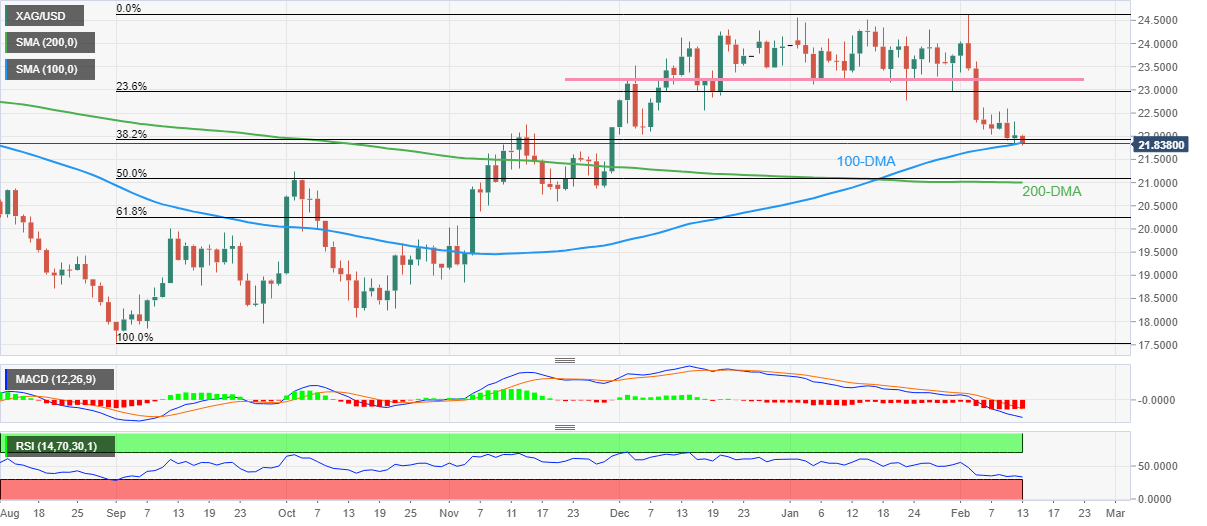
Trend: Limited downside expected
- GBP/USD holds lower ground amid the broad US Dollar rebound.
- Optimism surrounding UK workers, upbeat British GDP put a floor under the Cable price.
- Fears of US-China tussle, hawkish Fed and cautious mood ahead of key data favor US Dollar despite inactive yields.
GBP/USD clings to mild gains near 1.2050 heading into Monday’s London open as traders brace for this week’s key data from the UK and the US. Also exerting downside pressure on the Cable pair is the risk-off mood and the firmer US Dollar. However, hopes of overcoming the British workers’ strikes and recently firmer data from the UK seem to put a floor under the prices.
During the weekend, Reuters rolled out the news suggesting that the British firms are ready to refill the staff gaps even at the cost of the biggest pay rises since 2012. The news could help the UK policymakers overcome multi-week-old workers’ strikes and help the economy avoid recession, as well as propel the inflation and help the Bank of England (BoE) to remain hawkish. However, this week’s UK jobs report will be important to watch for clear directions.
It should be noted that the last week’s UK growth numbers helped British Chancellor Jeremy Hunt to mention that “the fact the UK was the fastest growing economy in the G7 last year, as well as avoiding a recession, shows our economy is more resilient than many feared."
On the other hand, the market’s risk-off mood underpinned the US Dollar’s run-up amid mildly positive Fedspeak, especially after Friday’s strong US Consumer Sentiment and inflation expectations. During the weekend, Philadelphia Federal Reserve President Patrick Harker pushed back the chatters of a Fed rate cut during 2023. However, the policymaker did mention, “Fed not likely to cut this year but may be able to in 2024 if inflation starts ebbing.” His comments were mostly in line with Fed Chair Jerome Powell’s cautious optimism and hence challenge the US Dollar buyers.
Against this backdrop, US stock futures fade the previous day’s corrective bounce while the Treasury bond yields remain sluggish around the multi-day high marked on Friday, which in turn helped the US Dollar Index (DXY) to grind higher after a two-week uptrend.
Looking forward, Tuesday’s UK employment numbers will precede US Consumer Price Index (CPI) to direct short-term GBP/USD moves. Following that, Wednesday’s UK inflation numbers data will be important for clear directions. Given the comparatively more hawkish comments from the Bank of England (BoE) officials, than the Fed policymakers, the GBP/USD price may witness recovery in case the US CPI disappoints.
Also read: GBP/USD Weekly Forecast: For how long can 200 DMA hold the fort? Focus on US/UK inflation
Technical analysis
Although the failure to cross the 50-DMA hurdle surrounding 1.2185 joins bearish MACD signals to favor GBP/USD sellers, a daily closing below the three-month-old ascending support line, close to 1.2020, appears necessary to convince bears.
Citing sources, Reuters reported on Monday, Japan's Upper House of Parliament has scheduled confirmation hearings on government nominees for the new Bank of Japan (BoJ) governor and his two deputies on February 27.
On Tuesday, February 14, the Japanese Cabinet is expected to formally nominate academic Kazuo Ueda as the new BoJ Governor along with the two deputies at both houses of parliament.
Tetsuya Inoue, a former staff secretary to Ueda during his time as a Bank of Japan monetary policy board member, said that Ueda will likely let the data guide him on the exit timing.
Market reaction
USD/JPY has recaptured the 132.00 barrier on the above headlines. The pair is trading 0.51% higher on the day at 132.07, at the press time.
- Asian stocks are displaying volatility inspired by US airborne threats and the inflation release.
- The announcement of Kazuo Ueda as the next BoJ Governor failed to infuse strength into the Japanese equities.
- Oil price has extended its losses below $79.00 as investors have ignored the oil supply cut by Russia.
Markets in the Asian domain are demonstrating immense volatility as rising odds of a surprise upside in the United States inflationary pressures amid an upbeat labor market and a recovery in the prices of used cars have strengthened the risk of a recession in the US. S&P500 futures are showing losses in the Asian SESSION. The 500-US stocks basket has carry-forwarded the weekly losses further amid the risk aversion theme. US airborne threats are escalating and have added to the higher inflation fears.
At the press time, Japan’s Nikkei225 tumbles 1.04%, Hang Seng dropped 0.50%, KOSPI surrendered 0.82%, Nifty50 slipped 0.45%. While ChinaA50 jumped 0.81%.
Chinese equities have witnessed decent gains in the morning as investors have digested the expression of deflation in China’s Consumer Price Index (CPI) report released on Friday. The economy has reported lower price pressures despite the administration and the People’s Bank of China (PBOC) advocating expansionary policy. However, signs are conveying that the demand is still downbeat and the economy will spend sufficient time in achieving pre-pandemic growth.
A consideration of academician Kazuo Ueda as the next Bank of Japan (BoJ) Governor after Haruhiko Kuroda will step down in April, as reported by Nikkei Asian Review, failed to provide strength to the Japanese stocks. For further guidance, investors are keeping an eye on the Gross Domestic Product (GDP), which will release on Tuesday. The economic data is seen expanding by 2.0% on an annual basis and 0.5% on a quarterly front.
On the oil front, the oil price has extended its losses below $79.00 as investors have ignored the announcement of an oil supply cut by Russia. Moscow announced a supply cut by 5% from March in retaliation against the price cap levied by the West to impact its funding for arms and ammunition in its war against Ukraine.
- USD/INR picks up bids to pare the previous losses amid risk-off mood.
- Fears surrounding mystery objects, hawkish Fed roil risk profile and underpin US Dollar after Friday’s upbeat data.
- Light calendar, cautious mood ahead of key data/events also exert downside pressure on Indian Rupee.
USD/INR marches towards 82.80, up 0.30% intraday, as it snaps the three-day downtrend during early Monday. In doing so, the Indian Rupee (INR) pair picks up bids to reverse the pullback from the previous monthly high as the US Dollar remains firmer amid the sour sentiment.
That said, the US Dollar Index (DXY) rises 0.20% intraday to 103.80 after a two-week uptrend as Fed talks remain hawkish while the US data appear positive. Adding strength to the greenback could be its safe-haven demand as the risk profile weakens amid geopolitical concerns surrounding unidentified objects that flew over the borders surrounding the US and China.
US Military General recently turned down the market’s fears of Chinese spying on the US by saying, “(We) have no reason to think latest objects are Chinese.” Even so, the fact that the US shot down nearly four such objects and China prepares to hit one weighs on sentiment.
On a different page, upbeat US inflation expectations and firmer Michigan Consumer Sentiment for February may have allowed Philadelphia Federal Reserve President Patrick Harker to push back the chatters of a Fed rate cut during 2023. However, the policymaker did mention, “Fed not likely to cut this year but may be able to in 2024 if inflation starts ebbing.” His comments were mostly in line with Fed Chair Jerome Powell’s cautious optimism and hence challenge the US Dollar buyers.
At home, recovery in Adani stocks and optimism surrounding the government’s deficit-cutting measures seem to battle with the broadly downbeat sentiment due to the Reserve Bank of India’s (RBI) hawkish bias. It’s worth noting that the exodus of foreign fund outflows, due to the Adani saga, also weighs on the Indian Rupee.
Amid these plays, the S&P 500 Futures fade the previous day’s corrective bounce off a one-week low, down 0.35% around 4,080 at the latest, whereas the US 10-year Treasury yields remain sidelined near 3.73% after refreshing a five-week high on Friday. Further, the Indian equity benchmarks are mildly offered by the press time.
Looking forward, USD/INR pair traders may witness lackluster moves ahead of the US Consumer Price Index (CPI) for January, up for publishing on Tuesday.
Technical analysis
USD/INR pair’s U-turn from 50-DMA, close to 82.20 by the press time, allows pair buyers to aim for a four-month-old descending resistance line, near 82.90.
- The recovery move by AUD/USD might meet offers amid the risk-off mood.
- A surprise rise in the US inflation would accelerate rate hike odds by the Fed.
- A confident drop below the H&S neckline will trigger a bearish reversal.
The AUD/USD pair has shown a responsive buying action after surrendering the round-level support of 0.6900 in the Asian session. The Aussie asset has attempted a recovery move, however, the Australian Dollar could retreat ahead as the risk impulse is quite negative amid airborne threats to the United States.
The US Dollar Index (DXY) is expected to recapture the 103.50 resistance ahead investors are getting anxious ahead of the release of the United State inflation data. S&P500 futures are extending their losses as investors are expecting that a surprise rise in the US inflation would accelerate rate hike odds by the Federal Reserve (Fed) and eventually will escalate recession fears. The 10-year US Treasury yields are struggling to extend gains above 3.75%.
AUD/USD is completing the last leg of the Head and Shoulder chart pattern on a four-hour scale. The aforementioned chart pattern is a prolonged consolidation and a breakdown of the neckline plotted from the January 10 low at 0.6860 will trigger a bearish reversal.
The asset is facing barricades each time encountering the 20-period Exponential Moving Average (EMA) at 0.6398, indicating more weakness ahead.
Meanwhile, the Relative Strength Index (RSI) (14) is struggling to sustain itself in the 40.00-60.00 range. A slippage into the bearish range of 20.00-40.00 will trigger the bearish momentum.
A breakdown below the neckline plotted from January 10 low at 0.6860 will drag the asset toward December 28 high around 0.6800. A slippage below the latter will further drag the asset toward December 22 high at 0.6767.
In an alternate scenario, a decisive break above the psychological resistance of 0.7000 will drive the asset towards January 18 high at 0.7064 followed by January 26 high at 0.7143.
AUD/USD four-hour chart
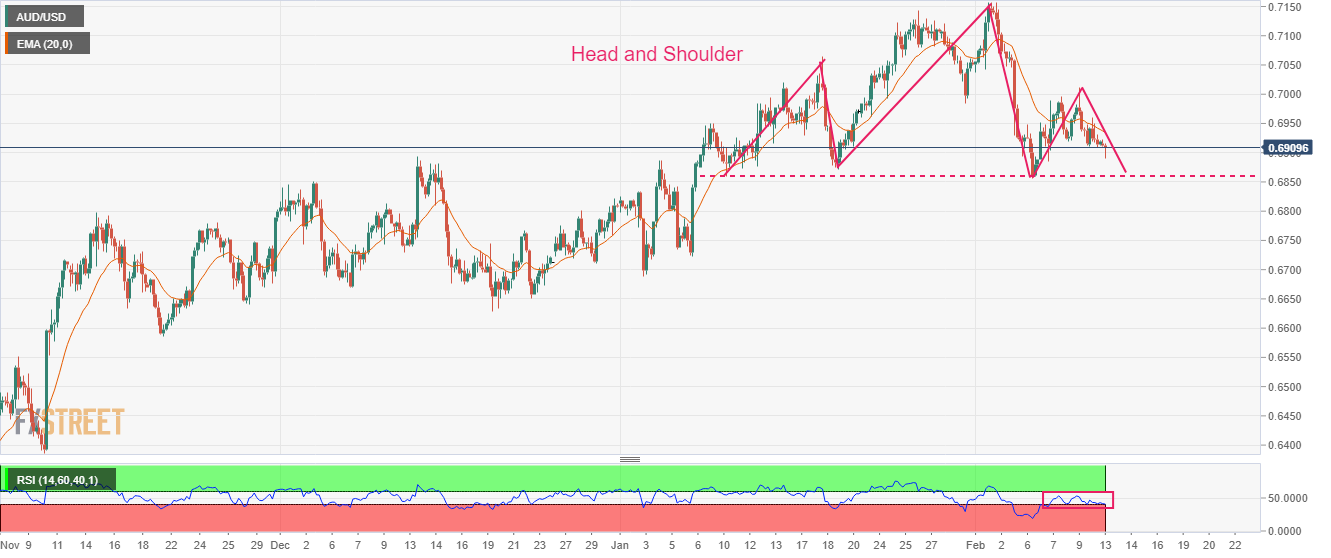
- Gold price fades Friday’s bounce off 61.8% Fibonacci golden ratio.
- Sour sentiment underpins US Dollar, weighs on XAU/USD, even as US Treasury bond yields dribble.
- Fed speak fails to bolster hawkish bias but US inflation expectations anchor rate hike concerns and tease Gold sellers.
Gold price (XAU/USD) remains depressed around $1,860 as sour sentiment underpins the US Dollar rebound during early Monday. Also exerting downside pressure on the XAU/USD could be the fears surrounding the US-China ties, as well as anxiety ahead of the US Consumer Price Index (CPI) for January.
While portraying the mood, the S&P 500 Futures fade the previous day’s corrective bounce off a one-week low, down 0.35% around 4,080 at the latest, whereas the US 10-year Treasury yields remain sidelined near 3.73% after refreshing a five-week high on Friday.
It should be noted that the fears about the mystery objects flying over the US and China have recently weighed on the sentiment, even as the US General turned down allegations on Beijing. US General turned down the market’s fears of Chinese spying on the US and the likely rush towards the safe havens by saying, “(We) have no reason to think latest objects are Chinese.” Even so, the fact that the US shot down nearly four such objects while China prepares to hit one keeps the matters on the geopolitical table and roil the risk profile.
Elsewhere, Philadelphia Federal Reserve President Patrick Harker pushed back the chatters of a Fed rate cut during 2023. However, the policymaker did mention, “Fed not likely to cut this year but may be able to in 2024 if inflation starts ebbing.” His comments were mostly in line with Fed Chair Jerome Powell’s cautious optimism and hence challenge the US Dollar buyers.
However, the US inflation expectations per the 10-year and 5-year breakeven inflation rates from the St. Louis Federal Reserve (FRED) remain firmer around the monthly highs and underpin the hawkish Fed bias, which in turn favor the US Dollar and exert downside pressure on the Gold price.
Moving on, Gold traders may witness further downside but the pace might be slow ahead of Tuesday’s US CPI. Should the scheduled US inflation data print strong numbers, hawkish Fed concerns could drown the XAU/USD price. Alternatively, softer US CPI may renew policy pivot talks and trigger the Gold price rebound.
Gold price technical analysis
Gold’s failure to cross the seven-week-old previous support drags the XAU/USD towards the 61.8% Fibonacci retracement level of December 22, 2022, to February 06, 2023 upside, also known as the Fibonacci golden ratio. Other than the failure to cross the key hurdle, sluggish oscillators also favor metal sellers.
Adding strength to the support-turned-resistance line is the 50% Fibonacci retracement level of $1,872.
It’s worth noting that the Gold’s ability to cross the $1,872 resistance confluence isn’t going to welcome the bulls as the 200-Simple Moving Average (SMA) will challenge the further upside near $1,890.
Alternatively, the aforementioned Fibonacci golden ratio near $1,852 appears immediate support for the Gold price ahead of the January 05 swing low near $1,825.
In a case where XAU/USD remains weak past $1,825, a horizontal area comprising multiple levels marked since late December, around $1,820, could challenge the metal bears.
Gold price: Four-hour chart
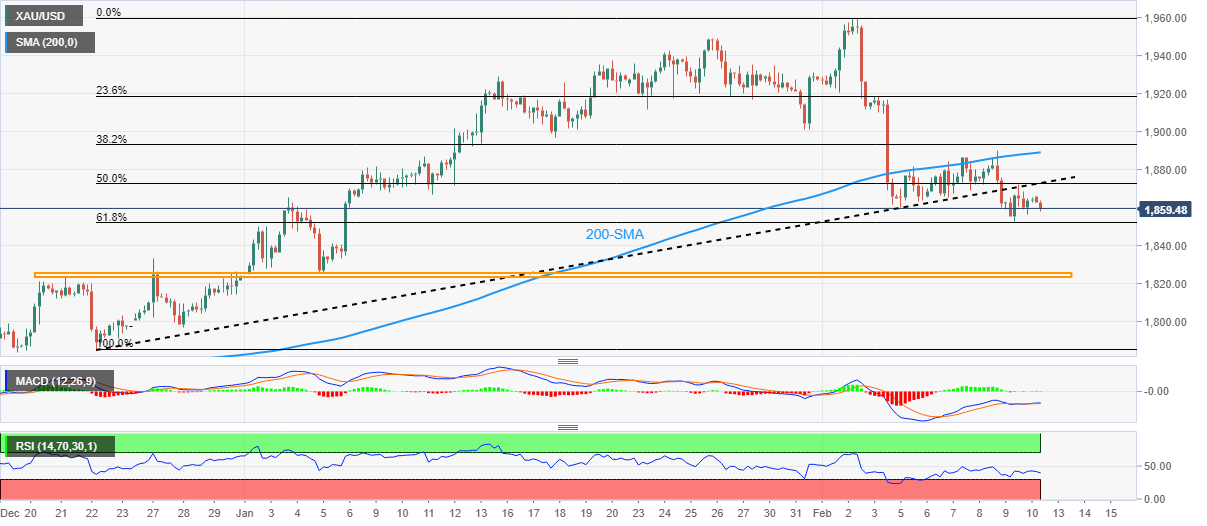
Trend: Further downside expected
- USD/JPY is looking to extend gains above 132.00 ahead of US Inflation.
- Airborne threats to the US and anxiety ahead of US Inflation have spooked market sentiment.
- The Japanese Yen surrendered its entire gains after Kazuo Ueda cited the current policy as appropriate.
The USD/JPY pair is hovering near its day high around 132.00 in the Tokyo session. The asset is expected to refresh a four-day high above 132.00 as investors are extremely risk-averse ahead of the United States inflation report and airborne threats near the territory of the United States.
Losses by S&P500 futures have escalated further as investors are concerned that a surprise rise in the US inflation will strengthen the case of another interest rate hike by the Federal Reserve (Fed). Also, disappointing earnings by the US equities have weakened the risk appetite of the market participants. The solidifying case for more interest rate hikes by the Fed has pushed the 10-year US Treasury yields to nearly 3.75%.
The US Dollar Index (DXY) has refreshed its three-day high at 103.47 amid the risk aversion theme. Economists at MUFG expect the US Dollar to be underpinned by a strong inflation report. The rationale behind an improvement in the appeal for the US Dollar is the rise in used car prices at the start of this year. Bloomberg reported that average used-vehicle prices rose 2.5% in January according to data from Manheim.
Meanwhile, the Japanese Yen has surrendered its entire gains recorded after Nikkei Asian Review reported that the Japanese Cabinet is set to appoint academician Kazuo Ueda as the next Bank of Japan (BoJ) Governor after Haruhiko Kuroda steps down in April. Kazuo Ueda stated that the current monetary policy is appropriate, which led to a sell-off in the Japanese Yen as the Japanese government has been reiterating that the economy will consider an exit from ultra-dovish monetary policy.
- EUR/USD seesaws around five-week low as bears take a breather.
- ECB’s Visco downplays rate hike bias, Fed’s Harker appears confused.
- Challenges to sentiment amid “unidentified objects” joins cautious mood ahead of key data to weigh on Euro.
EUR/USD licks its wounds around 1.0670, after declining to the five-week low, as traders await more catalysts to confirm the latest bearish bias. Adding strength to the recovery moves could be the recent consolidation in the market’s sentiment after US General’s comments. However, the European Central Bank (ECB) official’s dovish comments contrast with comparatively upbeat statements from the Federal Reserve (Fed) policymaker to keep the pair sellers hopeful ahead of the key growth and inflation data from the Eurozone and the US in that order.
The US General turned down the market’s fears of Chinese spying on the US and the likely rush towards the safe havens by saying, “(We) have no reason to think latest objects are Chinese.” Even so, the fact that the US shot down nearly four such objects while China prepares to hit one keeps the matters on the geopolitical table and weigh on the sentiment.
Earlier in the day, Governing Council member Ignazio Visco mentioned that the ECB must avoid pushing real interest rates too high, given the level of private and public debt in the euro area. The same joins the recently downbeat comments from the ECB policymakers and fears of recession inside the bloc to weigh on the EUR/USD.
On the other hand, Philadelphia Federal Reserve President Patrick Harker pushed back the chatters of a Fed rate cut during 2023. However, the policymaker did mention, “Fed not likely to cut this year but may be able to in 2024 if inflation starts ebbing.” Comments from Fed’s Harker were in line with Fed Chairman Jerome Powell and Richmond Federal Reserve (Fed) President Thomas Barkin who previously refrained from cheering upbeat US jobs report. Previously, the majority of the Fed Governors and the US diplomats, including US President Joe Biden and Treasury Secretary Janet Yellen, ruled out US recession concerns and appear hawkish for the Fed. Hence, there prevails a dilemma among the Fed policymakers which in turn makes this week’s US inflation data all the more important.
On Friday, the US inflation expectations per the 10-year and 5-year breakeven inflation rates from the St. Louis Federal Reserve (FRED) remain firmer around the monthly highs marked in the last week. Further, preliminary readings of the US University of Michigan (UoM) Consumer Sentiment for February rose to 66.4 versus 65.0 expected and 64.9 prior. Further, the UoM noted that the year-ahead inflation expectations rebounded to 4.2% this month, from 3.9% in January and 4.4% in December. “Long-run inflation expectations (5-year) remained at 2.9% for the third straight month and stayed within the narrow 2.9-3.1% range for 18 of the last 19 months,” stated the UoM.
Amid these plays, the S&P 500 Futures fade the previous day’s corrective bounce off a one-week low, down 0.50% around 4,080 at the latest, whereas the US 10-year Treasury yields remain sidelined near 3.73% after refreshing a five-week high the previous day.
As a result, the US Dollar stays firmer due to its safe-haven appear. However, cautious mood ahead of the key US Consumer Price Index (CPI) for January and the preliminary readings of the Eurozone fourth quarter (Q4) Gross Domestic Product, up for publishing on Tuesday, seem to probe the EUR/USD bears.
Technical analysis
EUR/USD needs a clear downside break of the ascending support line from November 30, 2022, around 1.0660, to convince sellers.
| Raw materials | Closed | Change, % |
|---|---|---|
| Silver | 22.029 | 0.32 |
| Gold | 1864.57 | 0.12 |
| Palladium | 1542.37 | -5.16 |
- GBP/JPY pares the previous day’s losses inside fortnight-long symmetrical triangle.
- Steady RSI backs recent recovery, 200-SMA challenges immediate upside.
- Multiple supports to test bears on their return.
GBP/JPY picks up bids to 158.70 as it grinds inside a two-wee-old triangle formation during Monday’s Asian session.
The cross-currency pair prints mild gains after a consecutive two-week downtrend. That said, the recently steady RSI (14) backs the quote’s recovery moves inside the symmetrical triangle.
It’s worth noting, however, that the 200-SMA hurdle surrounding 159.30 acts as an immediate upside hurdle for the GBP/JPY buyers to watch before the stated triangle’s top line, close to 159.45 by the press time.
In a case where the pair remains firmer past 159.45, the 160.00 psychological magnet holds the key for the GBP/JPY run-up targeting the previous monthly high surrounding 161.85 and then to the last defense of sellers, namely the late December 2022 high near 162.35.
Alternatively, a downside break of the 158.30 level will defy the triangle formation and theoretically suggest a slump toward the 143.00 mark. However, multiple hurdles do challenge the GBP/JPY bears before allowing them to cheer the multi-month low.
Among them, lows marked during February and January 2023, respectively near 156.75 and 155.35, will precede the September 2022 bottom surrounding 148.80 are the key. Also important to watch is the 150.00 round figure.
To sum up, GBP/JPY remains sidelined as it consolidates recent losses.
GBP/JPY: Four-hour chart
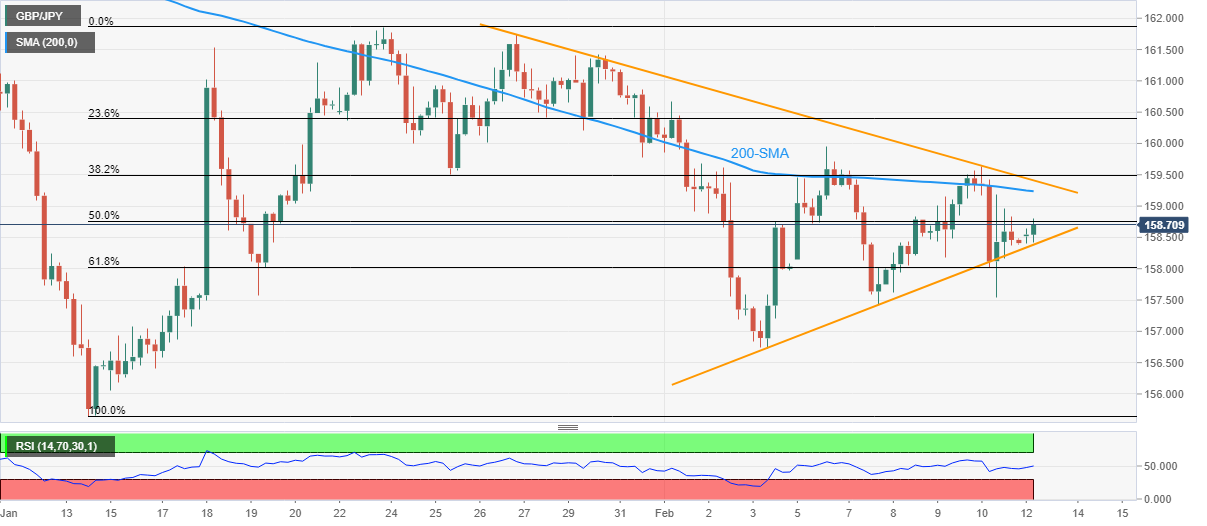
Trend: Upside remains more appealing
Haitham Al Ghais, the Secretary-General of the Organization of the Petroleum Exporting Countries (OPEC), said over the weekend at an energy conference in Cairo that the cartel “expects global oil demand to exceed pre-pandemic levels in 2023.”
Additional comments
“See demand rising to 110mn bbls/day by 2025, citing the improving economic outlook in China as it reopens.”
“OPEC remains committed to supporting oil market stability.”
“The oil industry had been “plagued by several years of chronic underinvestment.”
“Oil industry needs US$500 bn of investment annually until 2045.”
Related reads
- WTI drops from $80.00 as focus shifts to US Inflation for further guidance
- S&P 500 Futures drop, yields dribble as “unidentified objects”, Fed’s indecision probe optimists
- Risk profile remains sour as pre-data anxiety joins geopolitical fears.
- S&P 500 Futures reverse the corrective bounce off weekly low, US Treasury bond yields grind higher.
- US, China remain confused over flying objects and raising market’s fears.
- Fed policymakers appear a bit reserved ahead of US CPI, even as inflation expectations are firmer.
Risk appetite wanes as the US inflation week begins with the weekend headlines highlighting geopolitical fears and the mixed Federal Reserve (Fed) outlook. That said, a light calendar in Asia and a cautious mood ahead of the key US Consumer Price Index (CPI) for January add strength to the market’s favor for risk safety.
While portraying the mood, the S&P 500 Futures fade the previous day’s corrective bounce off a one-week low, down 0.50% around 4,080 at the latest, whereas the US 10-year Treasury yields remain sidelined near 3.73% after refreshing a five-week high the previous day.
Although the US General turned down the market’s fears of Chinese spying on the US and the likely rush towards the safe havens, the anxiety surrounding the “unidentified objects” flying over the US and Chinese airspace propel the risk-off mood. It should be noted that the US shot down nearly four such objects while China prepares to down one in nearly a week.
Elsewhere, Philadelphia Federal Reserve President Patrick Harker pushed back the chatters of a Fed rate cut during 2023. However, the policymaker did mention, “Fed not likely to cut this year but may be able to in 2024 if inflation starts ebbing.” Comments from Fed’s Harker were in line with Fed Chairman Jerome Powell and Richmond Federal Reserve (Fed) President Thomas Barkin who previously refrained from cheering upbeat US jobs report. Previously, the majority of the Fed Governors and the US diplomats, including US President Joe Biden and Treasury Secretary Janet Yellen, ruled out US recession concerns and appear hawkish for the Fed. Hence, there prevails a dilemma among the Fed policymakers which in turn makes this week’s US inflation data all the more important.
On a different page, the US inflation expectations per the 10-year and 5-year breakeven inflation rates from the St. Louis Federal Reserve (FRED) remain firmer around the monthly highs marked in the last week.
It’s worth mentioning that Wall Street closed mixed after the US data pushed back dovish concerns surrounding the Fed. However, receding hopes of the economic slowdown favored the optimists, even as the US Treasury bond yields flagged recession woes. That said, preliminary readings of the US University of Michigan (UoM) Consumer Sentiment for February rose to 66.4 versus 65.0 expected and 64.9 prior. Further, the UoM noted that the year-ahead inflation expectations rebounded to 4.2% this month, from 3.9% in January and 4.4% in December. “Long-run inflation expectations (5-year) remained at 2.9% for the third straight month and stayed within the narrow 2.9-3.1% range for 18 of the last 19 months,” stated the UoM.
Moving on, market players are likely to remain cautious and may keep favoring the safe havens, like the US Dollar, ahead of Tuesday’s US CPI. On Friday, the US Bureau of Labor Statistics announced that it revised the monthly Consumer Price Index (CPI) for December to +0.1% from -0.1%, based on updated seasonal adjustment factors.
Reuters reports that British employers expect to raise wages for their staff by the most in at least 11 years but the 5% pay deals for workers would still fall well below expected inflation.
The article cites a survey that was published on Monday.
''With the Bank of England fearing the surge in inflation could be harder to tame if pay deals keep rising, the Chartered Institute of Personnel Development (CIPD) said 55% of recruiters planned to lift base or variable pay this year as they struggle to hire and retain staff in Britain's tight labour market.''
"Skills and labour remain scarce in the face of a labour market which continues to be surprisingly buoyant given the economic backdrop of rising inflation and the associated cost-of-living crisis," Jon Boys, senior labour market economist at the CIPD, said.
Reuters explained that, ''expected median annual pay awards in 2023 rose to 5% - the highest since CIPD records began in 2012 - from 4% in the previous three months.
More than half of respondents reported having problems filling vacancies, and nearly one in three expected similar issues in the next six months.''
GBP/USD update
The Bank of England's Governor Andrew Bailey last week expressed concerns about wage-setting although markets will look to this week's Labour market data that analysts at TD Securities argued ''will likely continue to keep the pressure on the MPC heading into its March meeting.''
''We look for the Unemployment Rate to fall to just 0.1ppt above its series low and continue to look for another acceleration in ex-bonus wages. We also think headline wage growth stayed strong on a MoM basis.''
Technically, the price is en-route for lower at the start of the week as the following daily chart's thesis illustrates:
-
GBP/USD Price Analysis: The day ahead and initial balance have something for both bulls and bears
- USD/CAD has stretched its recovery move above 1.3370 as anxiety soars ahead of US CPI data.
- A surprise jump in US inflation will compel Fed Powell to continue the policy tightening spell in March.
- Canada’s weak employment cost index is going to delight the BoC.
The USD/CAD pair has rebounded firmly after building a cushion of around 1.3340 in the Tokyo session. The Loonie asset has extended its recovery firmly above 1.3370 as investors are getting anxious ahead of the release of the United States Consumer Price Index (CPI), therefore, pouring funds into the safe-haven assets due to the weak appetite of investors for risky assets.
The US Dollar Index (DXY) has refreshed its three-day high at 103.39 as the risk-appetite theme has weakened further. Meanwhile disappointed earnings by the US equities and geopolitical events in which Pentagon has shot down two unidentified flying objects in the past week have impacted the S&P500 futures.
Soaring expectations for a jump in the US inflation data, scheduled for Tuesday, is dampening the demand for the US government bonds, which has pushed the 10-year US Treasury yields to 3.74%.
The strong US labor market despite squeezing activities and higher interest rates by the Federal Reserve (Fed) is bolstering the expectations of a surprise upside in the inflation report. An occurrence of the same might force Fed chair Jerome Powell to continue the policy tightening spell to its March monetary policy. Also, Philadelphia Fed President Patrick Harker sees interest rates above 5% this year.
On the Loonie front, an upbeat employment report has conveyed that Canadian inflation could attain more stubbornness ahead. The economy added 150K in January, higher than the consensus of 15K and the former release of the 69.2K. The Unemployment Rate remained stable at 5%.
The catalyst that was music to the ears of the Bank of Canada (BoC) was the decline in the Average Hourly Earnings data, which dropped to 4.5% from the prior release of 4.7%. A decline in the labor cost index will squeeze consumer spending from the market and will trim inflationary pressures ahead.
The oil price has dropped firmly after facing barricades of around $80.00 after a power-pack move. The upside looks favored as Russia has announced a cut in oil production by 5% in retaliation aging price cap levied by 57 to prevent funding for ongoing war against Ukraine. It is worth noting that Canada is a leading exporter of oil to the United States and higher oil prices might strengthen the Canadian Dollar.
- GBP/USD bears are in play on the backside of last week's bullish trend
- 1.1950 is a target on the downside while 1.2070 is a target on the upside.
As per mid-week of last week's analysis, GBP/USD Price Analysis: Sell-off cutting into Day-3 longs, 1.2050 eyed for days ahead, the price of the Pound Sterling fell to test the 1.2050's target as the following illustrates:
GBP/USD prior analysis
''A bullish close on the day will be giving us three bullish closes in a row and leaves the risk of another sell-off on Friday:''
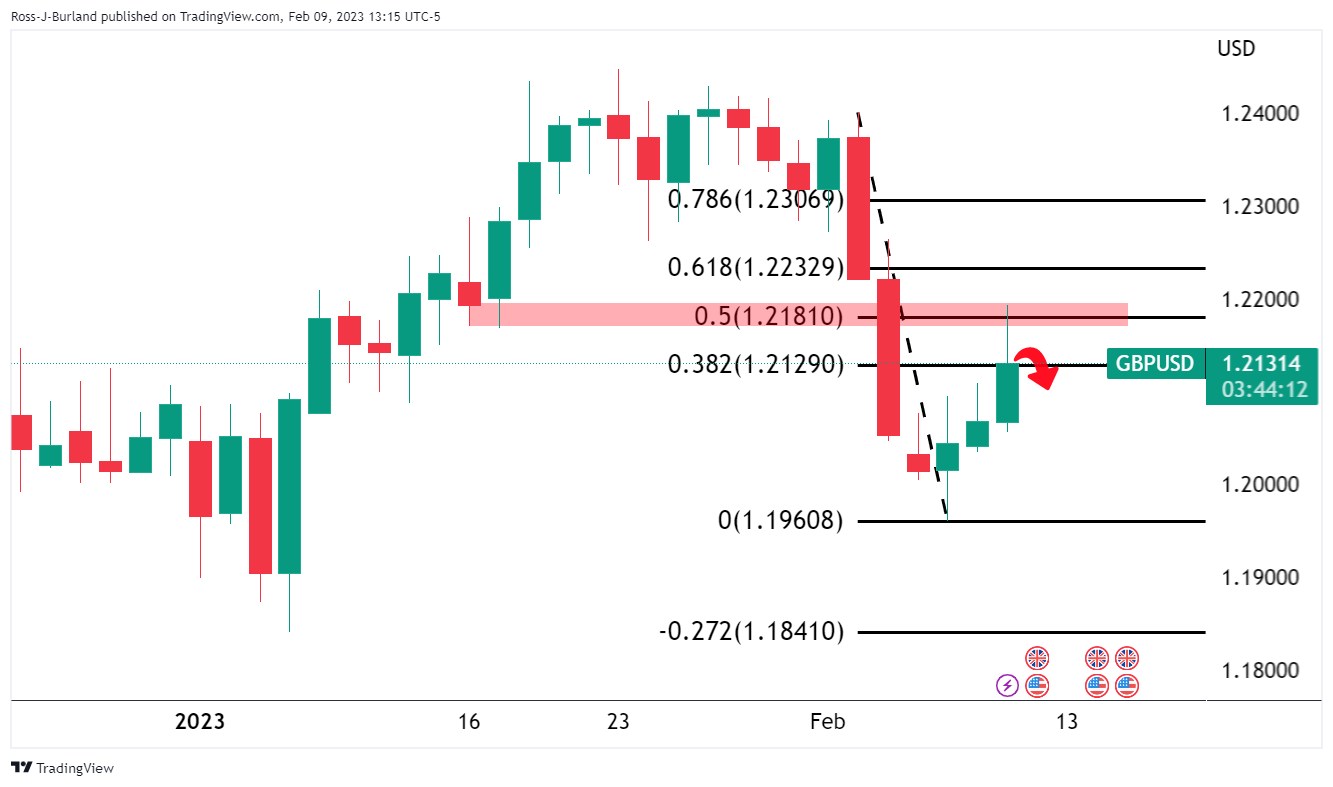
GBP/USD update
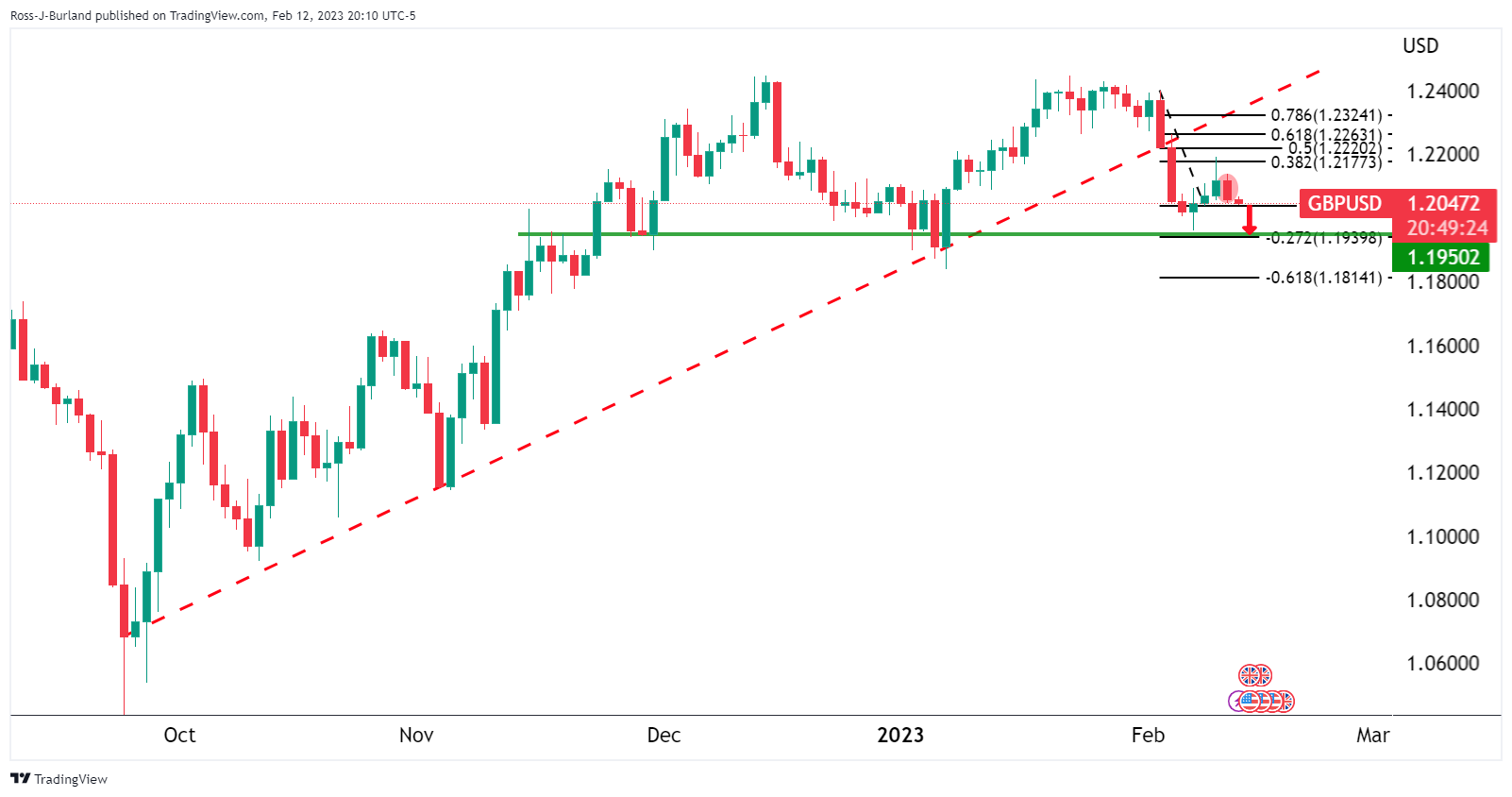
GBP/USD is on the backside of the trend now. The bears are in play and there are prospects of a continuation towards 1.1950 (daily ATR is 114 pips) with the -272% Fibonacci aligned at that juncture that meets the prior structure looking left. Further down we have the bottom of the new 100 pip box at 1.1900 and 1.1800 there after that meets a -61.8% Fibo.
However, that is not to say there will not be a move up for the day ahead as follows:
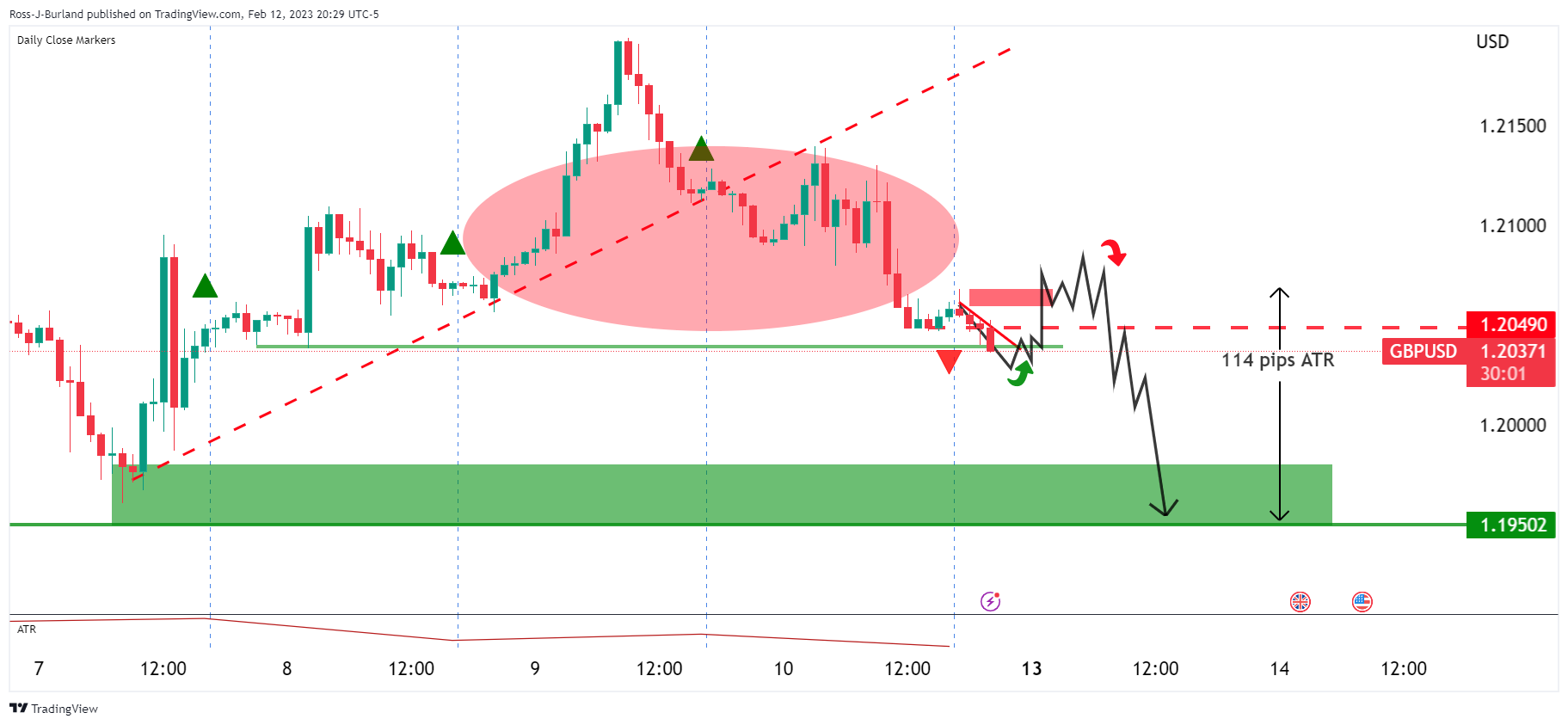
Asia could be setting up the lows for the near term for London's session's rally as the chart above illustrates, taking into account the liquidity above 1.2060 and to 1.2070. Such a move would fall within the average daily range of 114 pips and the outcome would complete the daily chart's bearish continuation thesis.
Market sentiment remains sour during early Monday as the US-China jitters over the “unidentified objects” join the mixed Fed talks and cautious mood ahead of the key US Consumer Price Index (CPI). While the geopolitics and Fed concerns are mixed, the trend from inflation precursors appears to favor the US Dollar’s safe-haven demand.
That said, the US inflation expectations per the 10-year and 5-year breakeven inflation rates from the St. Louis Federal Reserve (FRED) remain firmer around the monthly highs marked in the last week.
10-year inflation expectations per the aforementioned measure remained sidelined near 2.33% by the end of Friday’s North American trading session, after refreshing a two-month high to 2.34% on Wednesday.
On the same line, the five-year US inflation expectations rose to a fresh high since December 05, to 2.47% at the latest.
It should be noted that an upward revision to the US CPI data for December and the recently firmer US inflation expectations keep the US Dollar buyers hopeful ahead of Tuesday’s key inflation numbers.
Also read: US Dollar Index grinds higher past 103.50 as US inflation looms amid mixed Fed concerns
In recent trade today, the People’s Bank of China (PBOC) set the yuan at 6.8151 vs. the last close of 6.8158.
About the fix
China maintains strict control of the yuan’s rate on the mainland.
The onshore yuan (CNY) differs from the offshore one (CNH) in trading restrictions, this last one is not as tightly controlled.
Each morning, the People’s Bank of China (PBOC) sets a so-called daily midpoint fix, based on the yuan’s previous day's closing level and quotations taken from the inter-bank dealer.
- AUD/JPY prints mild gains to snap two-week downtrend.
- Sustained trading beyond 200-SMA, existence of bullish triangle joins steady RSI to favor AUD/JPY bulls.
- Sellers need validation from 90.00 to retake control.
AUD/JPY clings to mild gains around 91.00 as global markets remain dicey during early Monday. In doing so, the cross-currency pair seesaws inside a weekly bullish triangle while floating above the 200-SMA.
It’s worth noting that the steady RSI joins the quote’s sustained trading above the 200-SMA to keep AUD/JPY buyers hopeful.
Even so, a clear upside break of the weekly bullish triangle, currently between 91.30 and 90.20, becomes necessary for the AUD/JPY buyers to keep the reins. However, a downward-sloping resistance line from January 26, 2023, close to 91.40 at the latest, challenges the AUD/JPY upside.
In a case where the cross-currency pair remains firmer past 91.40, the odds of witnessing a run-up toward the previous monthly high near 92.80 can’t be ruled out. That said, the current monthly peak of 91.95 may act as an intermediate halt during the run-up.
Alternatively, the 200-SMA level surrounding 90.70 restricts the immediate downside of the risk-barometer AUD/JPY pair.
Following that, the aforementioned weekly triangle’s lower line could challenge the AUD/JPY bears around 90.20.
Adding to the downside filters is the 90.00 psychological magnet, a break of which could drag the quote toward the late January lows near 88.10.
Overall, AUD/JPY remains on the bull’s radar unless breaking the 90.00 round figure.
AUD/JPY: Four-hour chart
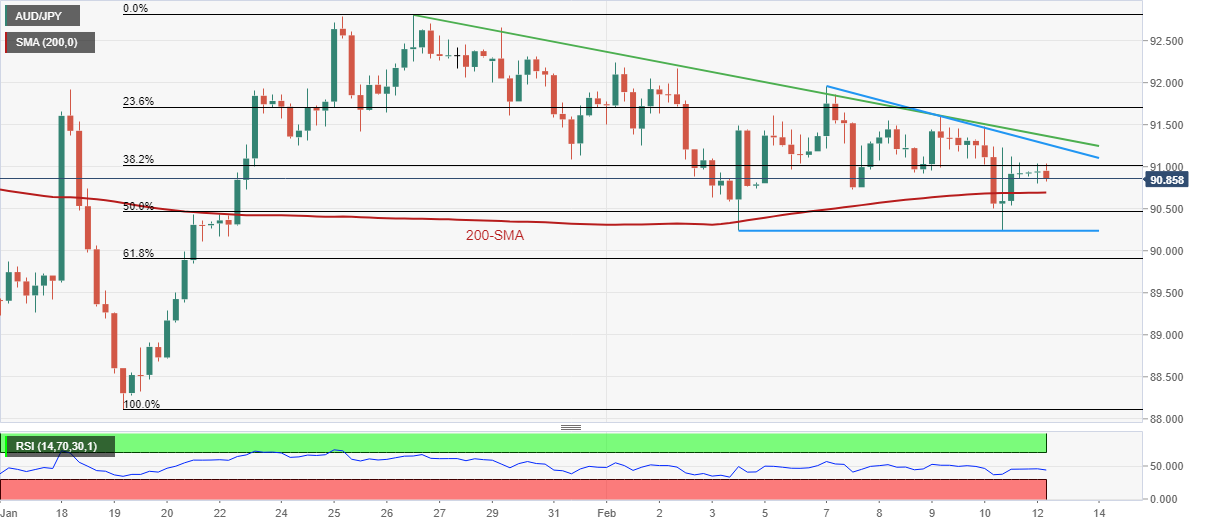
Trend: Further upside expected
- Gold price is inside the woods above $1,860.00 as investors await US inflation for fresh cues.
- Fed Harker sees interest rates above 5% this year as inflation is still elevated.
- The monthly headline and core CPI are both expected to deliver an expansion by 0.4%, according to a Reuters poll.
Gold price (XAU/USD) is demonstrating a decline in volatility ahead of the United States inflation data for fresh impetus. The precious metal is displaying a back-and-forth motion above $1,860.00, however, the downside looks favored amid a sheer decline in the risk appetite of the market participants.
The US Dollar Index (DXY) is struggling to deliver a break above the critical resistance of 103.35 in the Asian session. S&P500 futures have added losses further as disappointment from quarterly earnings has faded optimism for the risk-perceived assets. Also, back-to-back events of shooting down unidentified flying objects on the radar of the Pentagon have dampened the market mood. The alpha created on the 10-year US government bonds has dropped marginally below 3.74%.
Renewed concerns of further interest rate hikes by the Federal Reserve (Fed) have spooked market sentiment. Philadelphia Fed President Patrick Harker sees interest rates above 5% this year as inflation is still elevated. He sees on rate cut announcement this year as higher interest rates should remain for a longer period of time to achieve price stability.
The release of the US Consumer Price Index (CPI) will provide confident guidance on interest rates. As per the consensus, monthly headline and core CPI are both expected to deliver an expansion by 0.4%, according to a Reuters poll.
Gold technical analysis
Gold price has tested the breakdown of the Inverted Flag chart pattern on a two-hour scale with weak buying strength. The yellow metal is likely to display a perpendicular downside ahead after the asset will come out of balance.
The 20-period Exponential Moving Average (EMA) at $1,866.07 is barricading Gold bulls, which indicates more weakness ahead.
Meanwhile, the Relative Strength Index (RSI) (14) is hovering near 40.00. A breakdown into the bearish range of 20.00-40.00 will activate the downside momentum.
Gold two-hour chart
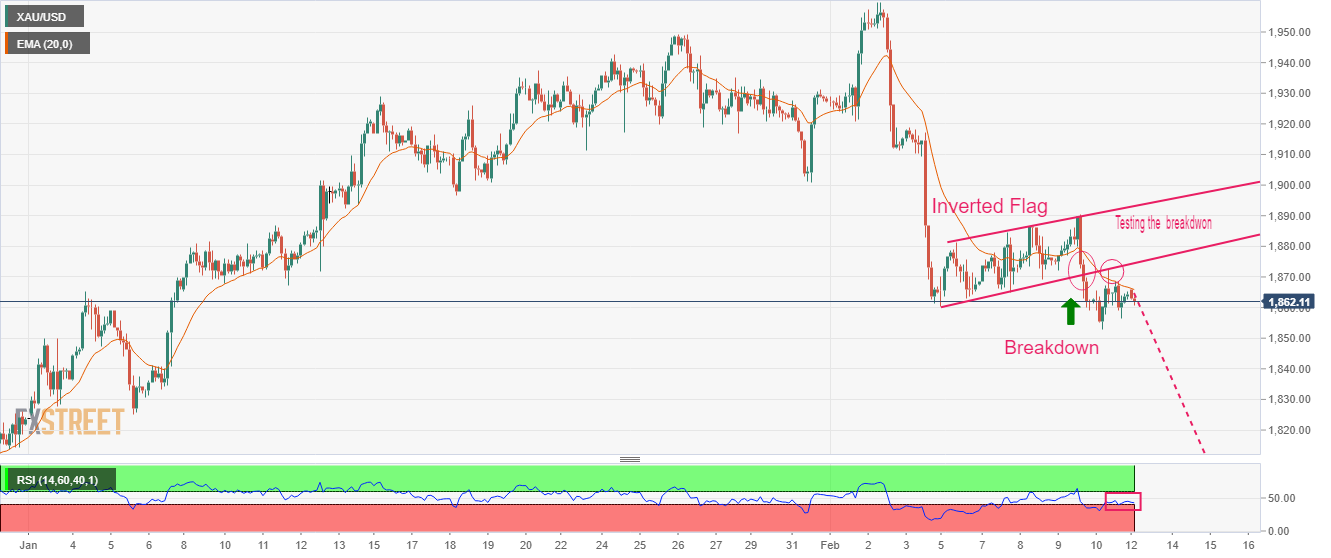
- AUD/USD holds lower grounds near one-week bottom, down for the second consecutive day.
- Indecision over the “unidentified objects” flying over US, China give rise to market’s anxiety.
- Fed speak appears mixed ahead of the key US CPI.
- Aussie jobs report also becomes important as RBA remains hawkish.
AUD/USD sellers attack the 0.6900 support amid market’s cautious mood during early Monday, after surprisingly ignoring the US Dollar strength to post weekly gains in the last.
Anxiety surrounding the “unidentified objects” flying over the US and Chinese airspace gave rise to the market’s cautious mood in addition to the US Federal Reserve (Fed) talks. Also weighing on the risk barometer pair could be the pre-data mood ahead of the US Consumer Price Index (CPI) for January, up for publishing on Tuesday.
The US and China’s shootings of unidentified objects, with the White House alleging China over spying, seems to weigh on the market sentiment and the risk-barometer AUD/USD pair. Recently, the US General allowed Aussie buyers to take a breather while saying that they have no reason to think latest objects are Chinese. It’s worth noting that the US shot down nearly four such objects while China prepares to down one in nearly a week’s time.
On the other hand, Philadelphia Federal Reserve President Patrick Harker pushed back the chatters of a Fed rate cut during 2023. However, the policymaker did mention, “Fed not likely to cut this year but may be able to in 2024 if inflation starts ebbing.” Comments from Fed’s Harker were in line with Fed Chairman Jerome Powell and Richmond Federal Reserve (Fed) President Thomas Barkin who previously refrained from cheering upbeat US jobs report.
Alternatively, the majority of the Fed Governors and the US diplomats, including US President Joe Biden and Treasury Secretary Janet Yellen, ruled out US recession concerns and appear hawkish for the Fed. Hence, there prevails a dilemma among the Fed policymakers which in turn makes this week’s US inflation data all the more important.
That said, preliminary readings of the US University of Michigan (UoM) Consumer Sentiment for February rose to 66.4 versus 65.0 expected and 64.9 prior. Further, the UoM noted that the year-ahead inflation expectations rebounded to 4.2% this month, from 3.9% in January and 4.4% in December. “Long-run inflation expectations (5-year) remained at 2.9% for the third straight month and stayed within the narrow 2.9-3.1% range for 18 of the last 19 months,” stated the UoM. Further, the US Bureau of Labor Statistics announced on Friday that it revised the monthly Consumer Price Index (CPI) for December to +0.1% from -0.1%, based on updated seasonal adjustment factors.
It’s worth observing that the Reserve Bank of Australia’s (RBA) hawkish hike in the last week allowed the AUD/USD to remain firmer but the cautious mood and expectations of downbeat Aussie jobs report, versus the firmer US inflation data, seems to tease AUD/USD bears.
While portraying the mood, S&P 500 Futures print mild losses and the US Treasury bond yields remain sidelined.
Moving on, a light calendar on Monday highlights the risk catalysts as the key for the AUD/USD pair traders to watch for clear directions.
Technical analysis
A two-month-old ascending support line, near 0.6900 by the press time, restricts immediate AUD/USD downside.
- USD/JPY bulls are moving in from an area of support made last week at 130.00.
- USD/JPY bulls eye a -272% of the prior bearish correction's range at 133.70.
USD/JPY could be about to make a move to the upside for this week's initial balance range as the Asian shares fall on Monday.
Investors are looking to this week's US data in Consumer Prices and Retails Sales, so there is an air of nervousness at the same time that the news of the US air force had shot down a flying object near the Canadian border, the fourth object downed this month, circulates. Officials declined to say whether it resembled the large white Chinese balloon that was shot down earlier this month. This has resulted in the MSCI's broadest index of Asia-Pacific shares outside Japan falling at the start of the week by 0.1%, adding to the loss of 2.2% last week.
Risk-off themes have tended to benefit the US Dollar lover of the Japanese currency as the Yen lost some of its appeals as the currency of choice to fund so-called carry trades at the turn of last year. Speculators cut bearish bets on it to the lowest level in nearly four months in the wake of December's shock move by the Bank of Japan. The BOJ rocked markets with a decision to loosen the parameters of its yield-control policy, sending the currency soaring by close to 5% on the day of the announcement.
This all leaves the outlook bullish from both fundamental and a technical standpoints as follows:
USD/JPY daily chart
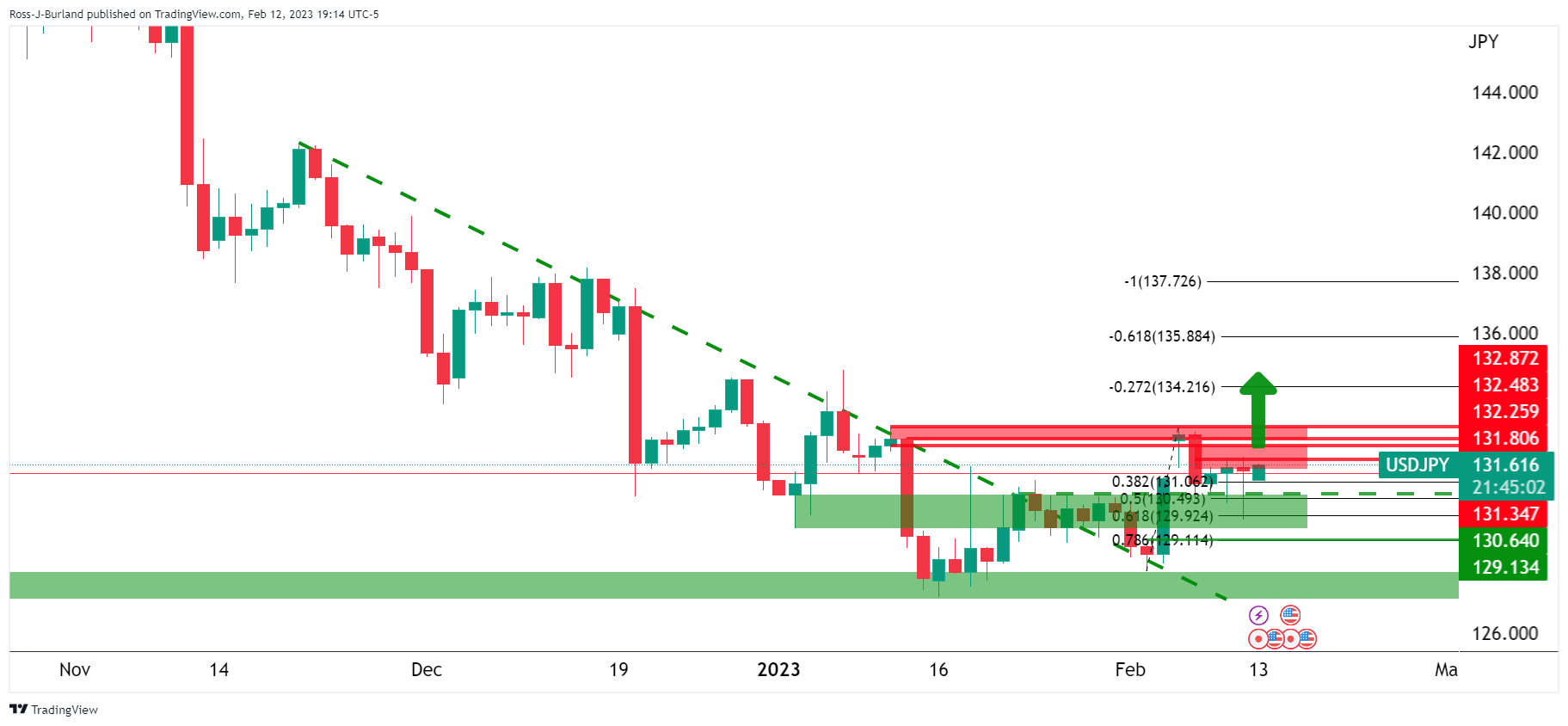
The price is on the backside of the prior bearish daily trend. The bulls are committing to the upside after a correction of the breakout from prior resistance which offers a foundation for the bulls to stay the course. For the days ahead, there could be prospects proven of a move to 133.70 cemented should the bulls crack 132.80 recent highs:
USD/JPY H1 chart
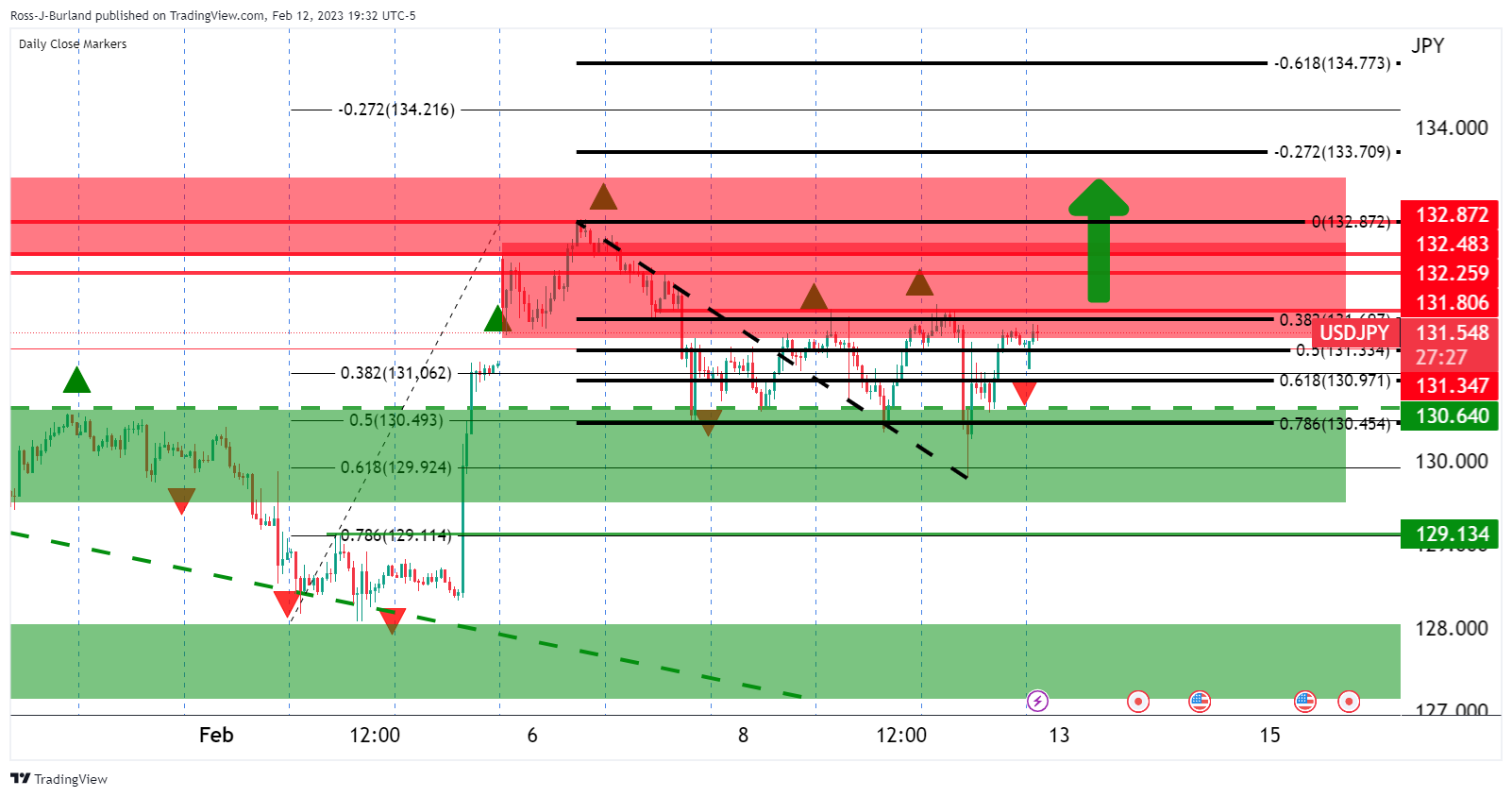
This level is marked as the -272% of the prior bearish correction's range and is a common target for continuation trades. 134.0 the figure comes above there as the next milestone for the bulls.
- The oil price has sensed selling interest after reaching near $80.00.
- Russia announced an oil production cut by 5% of its total output in retaliation against the price cap by G7 countries.
- A surprise jump in the US inflationary pressures might trigger volatility ahead.
West Texas Intermediate (WTI), futures on NYMEX, have sensed selling pressure while attempting to surpass the critical resistance of $80.00 in the Asian session. The oil price has dropped as investors have shifted their focus toward the release of the United States Consumer Price Index (CPI) data, which will release on Tuesday.
The oil price witnessed a buying interest on Friday after Russia announced a cut in the oil supply to retaliate against price caps imposed by G7 countries to restrict Moscow from funding its war essentials against Ukraine. Russia’s energy minister Alexander Novak announced that the nation will cut oil production by 500,000 barrels per day (bpd) which accords 5% of its output in March.
The United States Treasury Department has been reiterating that it aims to limit Kremlin’s earnings on each barrel in order to squeeze Moscow’s funding for the war in Ukraine while ensuring Russian oil supplies reach markets that need them.
Meanwhile, the US Dollar Index (DXY) is on the verge of extending its three-day high above 103.35 in the Asian session on expectations that the US inflation data will deliver a surprise jump amid the tight labor market. Although, the consensus is favoring a decline in the annual headline inflation to 5.8% from the former release of 6.5% and core inflation to 5.4% vs. 5.85 released earlier.
Apart from that, the expression of deflation from China’s CPI report released last week indicates that the recovery mode in the second-largest economy after the lifting of pandemic controls is quite slow. The economy will take sufficient time in achieving the pre-pandemic growth rate. This could trim optimism over a sheer recovery in the oil demand.
| Index | Change, points | Closed | Change, % |
|---|---|---|---|
| NIKKEI 225 | 86.63 | 27670.98 | 0.31 |
| Hang Seng | -433.94 | 21190.42 | -2.01 |
| KOSPI | -11.79 | 2469.73 | -0.48 |
| ASX 200 | -56.6 | 7433.7 | -0.76 |
| FTSE 100 | -28.7 | 7882.5 | -0.36 |
| DAX | -215.44 | 15307.98 | -1.39 |
| CAC 40 | -58.63 | 7129.73 | -0.82 |
| Dow Jones | 169.39 | 33869.27 | 0.5 |
| S&P 500 | 8.96 | 4090.46 | 0.22 |
| NASDAQ Composite | -71.46 | 11718.12 | -0.61 |
- EUR/USD stays depressed around five-week low as bears poke ascending trend line from November 30.
- Clear downside break of the 50-DMA, 12-week-long previous support joins bearish MACD signals to favor EUR/USD sellers.
- Buyers have a bumpy road to return unless crossing 1.0800.
EUR/USD bears roll up their sleeves while poking the short-term key support around 1.0660 during Monday’s Asian session, following a two-week downtrend.
The major currency pair’s bearish performance could be linked to the previous week’s downside break of the 50-DMA, as well as an upward-sloping trend line from November 21, 2022, now resistance near 1.0690.
Adding strength to the downside bias are the strongest bearish MACD signals since September 2022.
Hence, the quote is all set to conquer the immediate 1.0660 support, which in turn pens the south-run towards the 50% and 61.8% Fibonacci retracement level of the EUR/USD run-up from November 2022 to February 2023, respectively near 1.0630 and 1.0530.
It’s worth noting, however, that the previous monthly low around 1.0480 could challenge the EUR/USD bears past 1.0530.
On the contrary, recovery moves need to cross the immediate support-turned-resistance line from November, close to 1.0690, to convince traders. Even so, the 50-DMA could probe the EUR/USD pair buyers around 1.0710.
Following that, a two-month-old ascending resistance line near 1.0800 becomes crucial for the EUR/USD buyers.
Overall, EUR/USD is likely to extend its south-run as traders await the key US inflation data.
EUR/USD: Daily chart
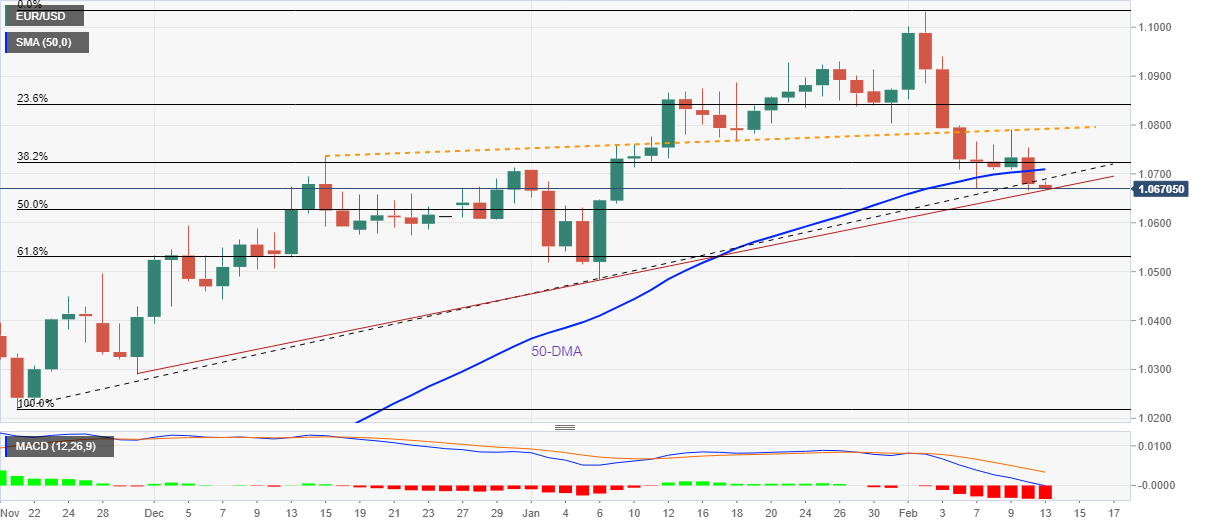
Trend: Further downside expected
| Pare | Closed | Change, % |
|---|---|---|
| AUDUSD | 0.69208 | -0.2 |
| EURJPY | 140.316 | -0.64 |
| EURUSD | 1.06796 | -0.53 |
| GBPJPY | 158.389 | -0.66 |
| GBPUSD | 1.20552 | -0.54 |
| NZDUSD | 0.63088 | -0.27 |
| USDCAD | 1.33391 | -0.79 |
| USDCHF | 0.9237 | 0.2 |
| USDJPY | 131.389 | -0.12 |
- US Dollar Index stays defensive after two-week uptrend.
- Fed’s Barkin sounds dovish despite pushing back rate cut talks.
- US-China tension weigh on sentiment and favor DXY bulls amid dicey markets.
- US CPI for January appears important after recently firmer US jobs data, inflation cues.
US Dollar Index (DXY) remains sidelined bear 103.60 as the greenback buyers await the US inflation data during early Monday, following a two-week uptrend.
In doing so, the US Dollar’s gauge versus the six major currencies portrays the market’s cautious mood amid firmer US data, mixed comments from the Federal Reserve (Fed) officials and geopolitical fears surrounding “unidentified objects” which raised US-China tension.
On Friday, preliminary readings of the US University of Michigan (UoM) Consumer Sentiment for February rose to 66.4 versus 65.0 expected and 64.9 prior. Further, the UoM noted that the year-ahead inflation expectations rebounded to 4.2% this month, from 3.9% in January and 4.4% in December. “Long-run inflation expectations (5-year) remained at 2.9% for the third straight month and stayed within the narrow 2.9-3.1% range for 18 of the last 19 months,” Stated UoM. Further, the US Bureau of Labor Statistics announced on Friday that it revised the monthly Consumer Price Index (CPI) for December to +0.1% from -0.1%, based on updated seasonal adjustment factors.
Considering the data, Philadelphia Federal Reserve President Patrick Harker pushed back the chatters of a Fed rate cut during 2023. However, the policymaker did mention, “Fed not likely to cut this year but may be able to in 2024 if inflation starts ebbing.” Comments from Fed’s Harker were in line with Fed Chairman Jerome Powell and Richmond Federal Reserve (Fed) President Thomas Barkin who previously refrained from cheering upbeat US jobs report. On the other hand, the majority of the Fed Governors and the US diplomats, including US President Joe Biden and Treasury Secretary Janet Yellen, ruled out US recession concerns and appear hawkish for the Fed. Hence, there prevails a dilemma among the Fed policymakers which in turn makes this week’s US inflation data all the more important.
Not only the mixed Fed and anxiety ahead of the US inflation but the US and China’s shootings of unidentified objects, with the White House alleging China over spying, also seems to weigh on the market sentiment and favor the DXY bulls. During the weekend, the Pentagon shot down a mystery object by saying that it appeared to have traveled near US military sites and posed not just a threat to civilian aviation but also as a potential tool for surveillance. “It was the fourth unidentified flying object to be shot down over North America by a US missile in a little more than a week,” said Reuters.
Amid these plays, S&P 500 Futures print mild losses and the US Treasury bond yields remain sidelined.
Moving on, risk catalysts may entertain DXY traders ahead of Tuesday’s key CPI data for January. Should the scheduled inflation numbers manage to remain firmer, the odds of the Fed’s policy pivot get thinner and allow the US Dollar to remain firmer, which in turn could weigh on prices of commodities and the Antipodeans.
Technical analysis
A daily closing beyond the 50-DMA, around 103.40 by the press time, hints at the DXY’s ability to cross the descending resistance line from late May, close to 103.75 at the latest.
© 2000-2024. All rights reserved.
This site is managed by Teletrade D.J. LLC 2351 LLC 2022 (Euro House, Richmond Hill Road, Kingstown, VC0100, St. Vincent and the Grenadines).
The information on this website is for informational purposes only and does not constitute any investment advice.
The company does not serve or provide services to customers who are residents of the US, Canada, Iran, The Democratic People's Republic of Korea, Yemen and FATF blacklisted countries.
Making transactions on financial markets with marginal financial instruments opens up wide possibilities and allows investors who are willing to take risks to earn high profits, carrying a potentially high risk of losses at the same time. Therefore you should responsibly approach the issue of choosing the appropriate investment strategy, taking the available resources into account, before starting trading.
Use of the information: full or partial use of materials from this website must always be referenced to TeleTrade as the source of information. Use of the materials on the Internet must be accompanied by a hyperlink to teletrade.org. Automatic import of materials and information from this website is prohibited.
Please contact our PR department if you have any questions or need assistance at pr@teletrade.global.

